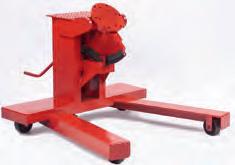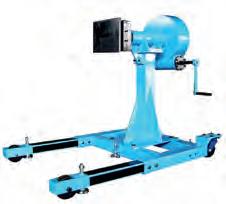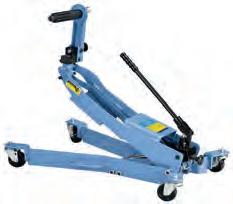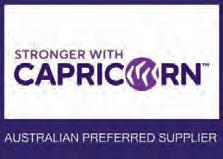





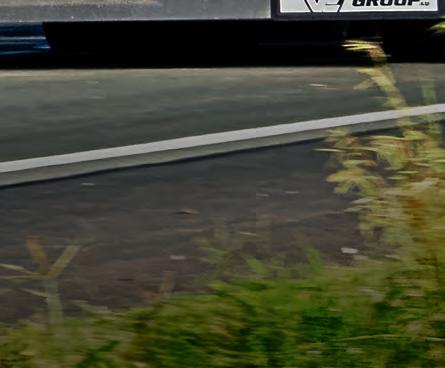
































DAF.COM.AU





















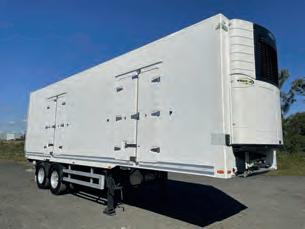













































DAF.COM.AU



























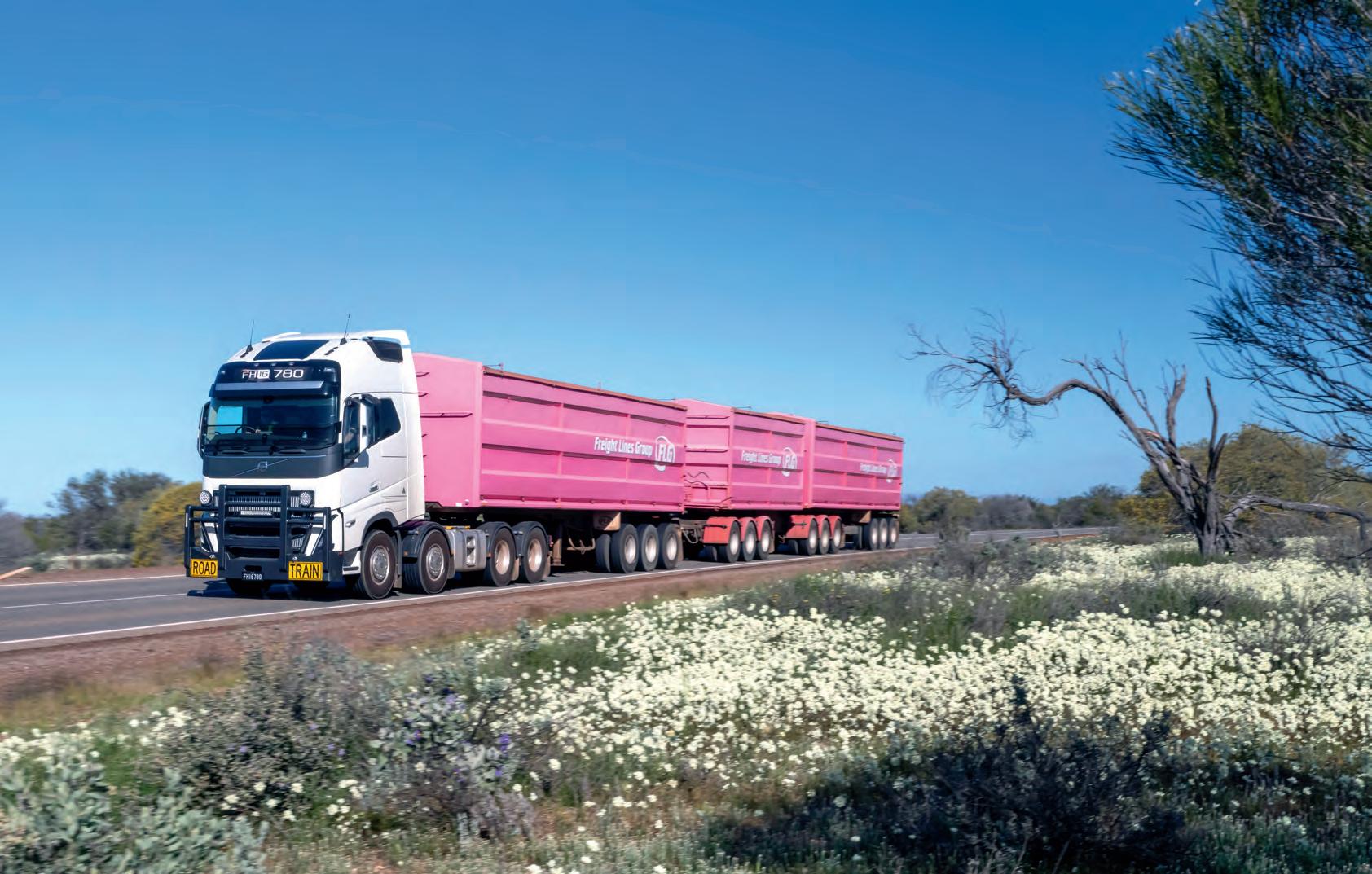
8 ROAD UPDATES


24 KEEPING IT KLEEN

Samantha Ruggeri has gone from dance teacher to expert truck cleaner in the space of a decade
28 FORMING A LEGEND
Inside Michael Bransgrove’s fun owner-driver journey

32 SPECIAL CELEBRATION
VE Group paid tribute to Kenworth in a unique way
44 RISING STAR

Inside the latest funding and safety upgrades for Australian roads
18 TOP OF THE TREE

Warren Aitken hops behind the wheel of the new Volvo 780




Chatting with the NatRoad Young Driver of the Year
62 LOCK IN THOSE SHOW DATES
Find out what’s on for the end of this year
66 GROWING THE NEXT GEN

Goldstar Transport invests in its youth
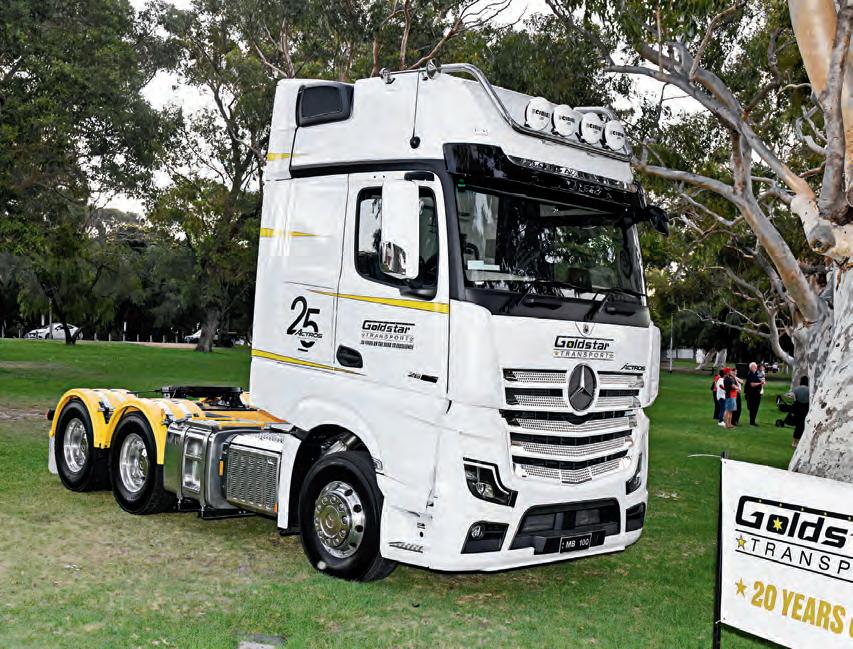
You don’t need to use a general transport system, courier system or plant hire system to issue your Tipper dockets. It’s not too late to change.
Use TipTraxx - the only system developed for Tippers. TipTraxx allows you issue Tipper Dockets on Job Completion & Manage your Tipper Operations.
Easy & Convenient to Use - designed for Drivers
Allocation System - ongoing or future jobs
Dynamic Pre-Start & Safety Equipment Checklist
Load Tracking - Truck travelling loaded/empty?
Downtime & Wait Time Notification
Capture Signature - Job sign-off, load verification
Record Tolls/Fuel/Speedo

Set Job or Daily Cartage targets
Accommodates Pre-Loads/Split Loads
Attach Load Documents to Dockets
Set Load Rates - Totals Calculated
Accounting system integration
The ONLY paperless docket system developed specifically for TIPPERS

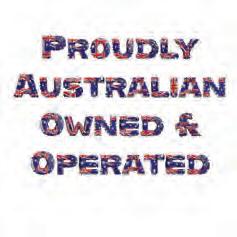




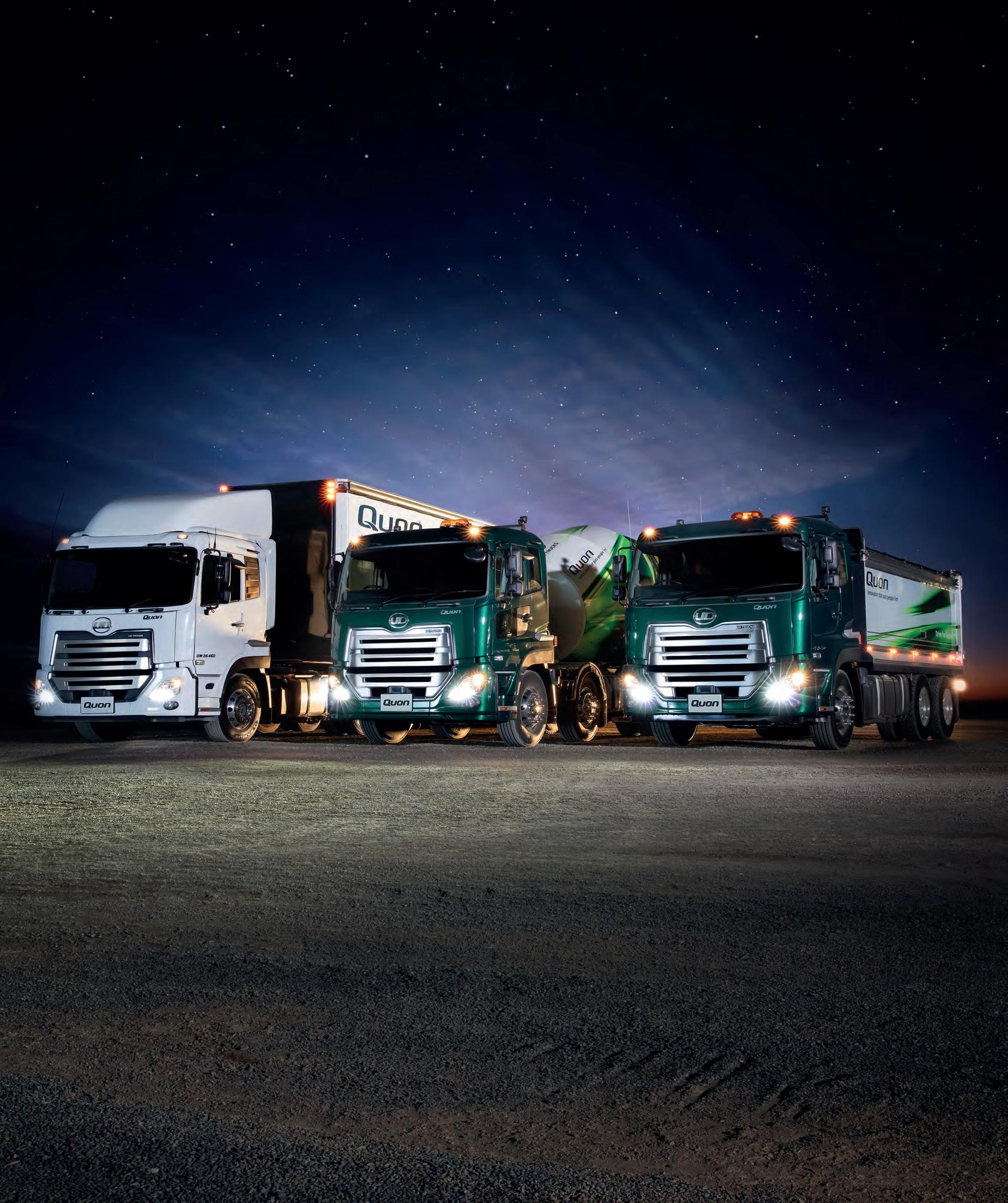
Innovation that puts people first

The UD Quon may be our greatest modern achievement.
From its 2004 introduction with the world’s first ‘Selective Catalytic Reduction System’. To its reinvigoration in 2017, with Euro 6 compliant technology. To today, with the reimagined Enhanced Quon, that continues to break boundaries with greater safety, productivity, comfort and sustainability. We continue to go the Extra Mile to ensure our flagship Quon is better for business, better for people, and better for the planet.
There’s a reason the UD Quon is the truck Australia trusts
Going the Extra Mile
To find out more, contact your UD Trucks dealer on 1300 BUY A UD or visit udtrucks.com/australia


EDITORIAL
Editor Geoff Crockett
E-mail Geoff.Crockett@primecreative.com.au
Journalist Alex Catalano
E-mail Alex.Catalano@primecreative.com.au
Contributors Warren Aitken, Frank Black, Warren Clark, Daniel Woods, Tiarna Condren, Tiane Gavillucci, Rod Hannifey, Michael Kaine
Cartoonist John Allison
PRODUCTION
Art Director Bea Barthelson
Print IVE Print
ADVERTISING
Business Development Manager
Hollie Tinker Ph 0466 466 945
E-mail Hollie.Tinker@primecreative.com.au
SUBSCRIPTIONS
www.ownerdriver.com.au/subscribe
Phone +61 (0)3 9690 8766
Mon-Fri 8am-4.30pm (EST)
Email subscriptions@primecreative.com.au
Mail 379 Docklands Drive, Docklands, VIC 3008 Australia
EXECUTIVE GROUP
CEO John Murphy
COO Christine Clancy
Operations Manager Regina Fellner
Trader Group Sales Director
Asanka Gurusinha
VIC 3008
Telephone: (+61) 03 9690 8766
www.primecreative.com.au
ISSN 1321-6279
OwnerDriver magazine is owned by Prime Creative Media. All material in OwnerDriver is copyright and no part may be reproduced or copied in any form or by any means (graphic, electronic or mechanical including information and retrieval systems) without written permission of the publisher. The Editor welcomes contributions but reserves the right to accept or reject any material. While every effort has been made to ensure the accuracy of information Prime Creative Media will not accept responsibility for errors or omissions or for any consequences arising from reliance on information published.
Opinions expressed in OwnerDriver are not necessarily the opinions of, or endorsed by the publisher unless otherwise stated.



Proof-reading this month’s edition of OwnerDriver, getting it ready for the printer, the distribution team, and ultimately you, the reader, I was reminded just what this life is all about.
While we all love to read about amazing machinery and marvel at the pictures of the glorious trucks that play their part in the transport industry, the real heroes are the people.
Each month at OwnerDriver we have a dedicated team of columnists who find time in their busy schedules, away from work and family, to share their thoughts or advice with our readers and try their hardest to push the industry a little further down the road to becoming the best it can be.
An industry where people share their knowledge freely, where earning a living doesn’t have to be a race to the bottom. Where safety is a priority. And where fairness reigns supreme, both in the contracts between transporters and their hirers, but also in the policing of the boundaries of behaviour agreed upon by all those participating in the transport game.
It’s these sorts of ideals that Ken Wilkie has championed in OwnerDriver for more than 30 years. While Ken’s battling a few health issues right now, and has hung up the pen, his decades’ long quest continues to offer a guiding light for his friends, fellow columnists, and the OwnerDriver team, and we wish him a speedy return to good health.
Rolling through the feature stories in this edition, it’s a reminder of just how much passion the transport industry inspires.
Warren Aitken’s interview with Samantha Ruggeri, who went from teaching and dancing to helping to lead a family truck washing business in



Western Australia, captures perfectly the power of this community to draw people in and engage their imagination.
And his Truck of the Month tale about VE Group not only offers some stunning photography of a classy Kenworth, but also highlights the power of family, of the willingness to take a risk, and the desire to succeed.
Long time owner driver Michael Bransgrove shares the tale of his classy ride, along with some great tips on how to keep a small transport business alive in today’s world and we celebrate the champions chosen by NatRoad members this year to take home their coveted transport industry awards — including Young Driver of the Year Jade Harney — who started out learning on a forklift and moved on to driving trucks.
There are top tips for staying on top of fatigue management, the latest in lighting technology, and even a review of Volvo’s biggest truck yet, the monster D17 780hp model.
I hope you enjoy this month’s read and would love to hear your stories or ideas for the magazine at geoff.crockett@primecreative.com.au.






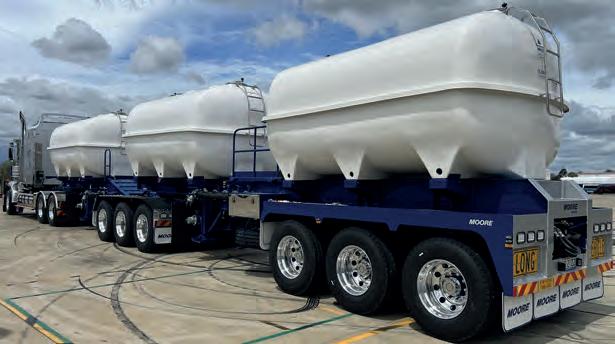




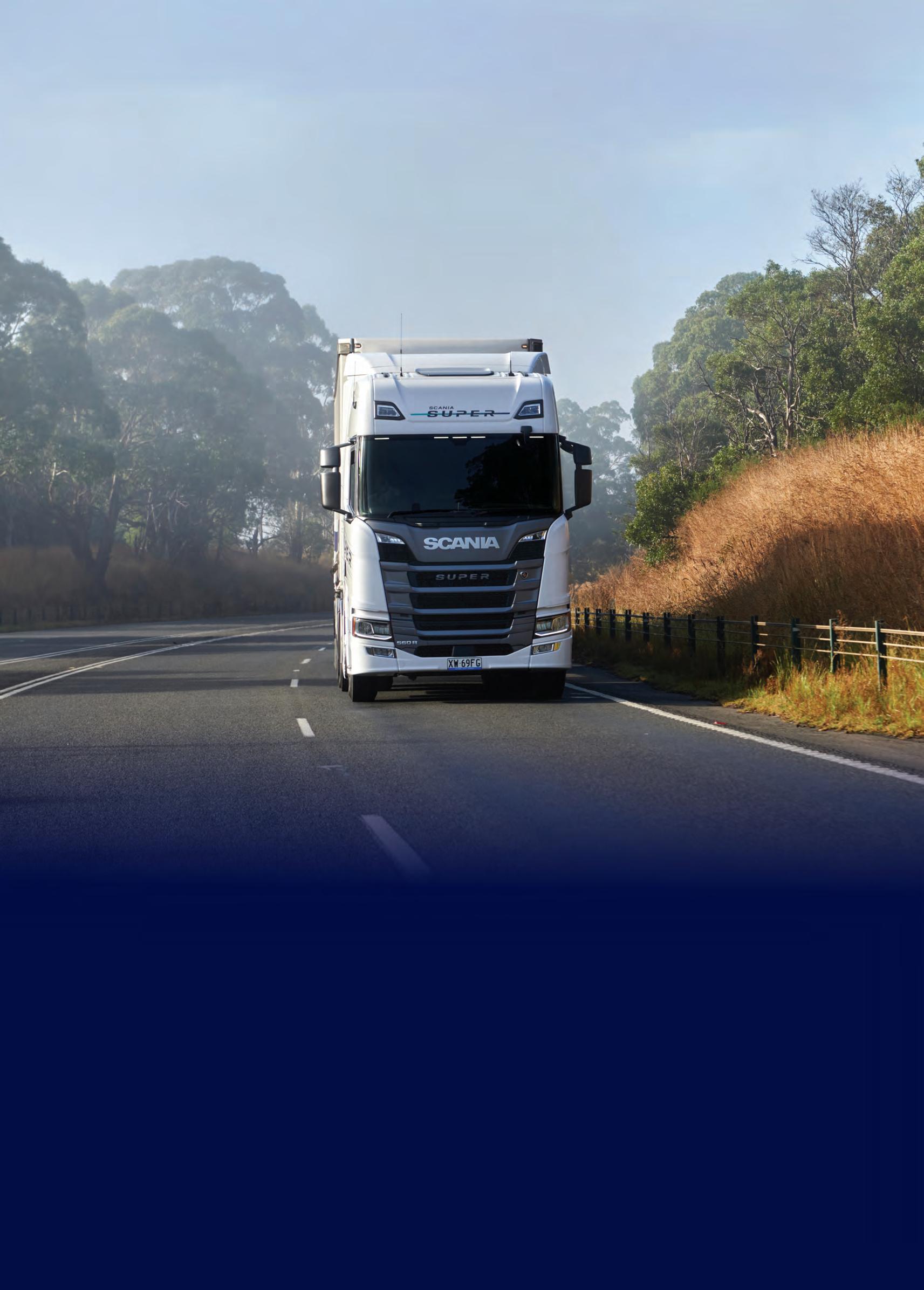



Funding and safety upgrades have been rolled out across Australia’s key freight routes over the past month
There’s been significant funding put towards the completion of several major road upgrades across Australia, particularly in New South Wales.
The $700 million Singleton Bypass project is set to get truckies home quicker and safer, with major construction commencing on the long-awaited connection in New South Wales.
The project will deliver Singleton’s biggest infrastructure project to date, with plans to remove one of the Hunter region’s most notorious bottlenecks and around 15,000 vehicles from the Singleton CBD daily.
NSW minister for Hunter Yasmin Catley says this project will make travel safer, faster, and more efficient for all road users.
“Starting construction on the bypass is one of the ways the NSW government is delivering top-quality services to regional areas, making sure that our communities have access to the best infrastructure possible,” she says.
“There’s never been a better time to live in the Hunter. With this new bypass, we’re connecting people across NSW and getting people from A to B quicker and safer than ever before.”
Motorists will avoid five sets of traffic lights and benefit from improved road safety and reduced travel times.
Six bridges will also be built including four across the Hunter River floodplain as well as a northbound climbing lane, allowing heavy vehicles to climb the hill without slowing other traffic, between Gowrie Gates and the northern connection.
West of Sydney near Orange, a section of the Mitchell Highway has been re-opened for public use, following the completion of works to widen the highway near the intersection with Pretty Plains Road.
A dedicated left turn lane off the highway into Pretty Plains Road was also installed.

“This is a very busy intersection on the Mitchell Highway and Bathurst and Orange, and for years motorists have been asking for something to be done to make it safer for all road users,” says Transport for NSW Regional Director West Alistair Lunn.
“The problem has always been that motorists wanting to turn from the highway into Pretty Plains Road have had to rapidly decelerate from 100 km/h, running the risk of vehicles behind them not reacting quickly enough and creating further hazards.”
likely to see the biggest benefits.
“The trial is a win-win for our city and our freight industry,” Minister for Roads and Road Safety Melissa Horne says.
“By taking livestock trucks off inner-city streets and into the tunnels we’re improving road safety while also keeping our freight sector moving.”
The Queensland Department of Transport and Main Roads (TMR) has
work is done reinstating the bridge to a safe condition.
The department will continue monitoring, assessing and reviewing the roads in the region while encouraging operators to drive through the region.
SAFETY WORKS IN SA
Meanwhile in South Australia, the state government has allocated
“By taking livestock trucks off inner-city streets and into the tunnels we’re improving road safety while also keeping our freight sector moving.”
A 12-month trial will commence in Melbourne in 2025 to remove livestock trucks from some of the city’s busiest streets.
The Victorian government is partnering with Transurban and the freight industry to allow the heavy vehicles to enter Citylink tunnels.
Livestock trucks had previously been banned from the Burnley and Domain tunnels due to low-clearance infrastructure, but recent upgrades to raise it to a safe height mean the trucks can enter the tunnels with no risk to animals on-board.
The trial is expected to remove 600 trucks from city streets each week, with City Road, Power Street, Olympic Boulevard and Hoddle Street
announced that heavy vehicles can now travel through Developmental Road.
The Springton Creek Bridge along Developmental Road in central Queensland was originally closed in June due to an ongoing grassfire, with heavy vehicle restrictions now changed on a temporary side-track around the bridge.
All vehicles operating under OSOM guidelines and permits are now allowed to travel on the side-track centreline at a maximum speed of 10kph, gaining access through the region and onto Developmental Road.
The Queensland TMR department says conditions may change in the event of wet weather, with the side-track to remain in place until
$10 million over four years to undertake safety treatments on key regional roads across the state.
Southern Ports Highway and Southend Access Road junction, Spencer Highway (Wallaroo to Moonta), Flinders Highway (south of Wangary to the junction of Western Approach Road), Goolwa Road (Mount Compass to Goolwa) and Gorge Road (Amber Gully to Corkscrew Road) will all be beneficiaries of the funding.
The $10 million investment is part of the state government’s larger $98 million road safety package, which is one of three being delivered under a combined $346.1 million partnership with the federal government.















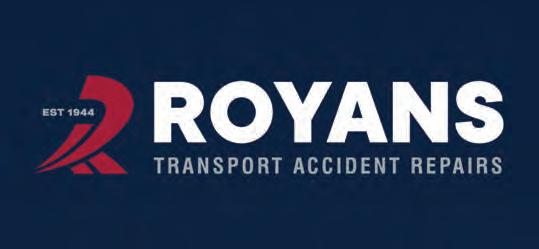

Royans Transmech based in Wingfield, is one of Australia’s leading manufacturers of car carriers. Supplying some of the industry’s most soughtafter vehicle transporters ranging from four car carriers through to fourteen car RTV2 Road Train configurations.
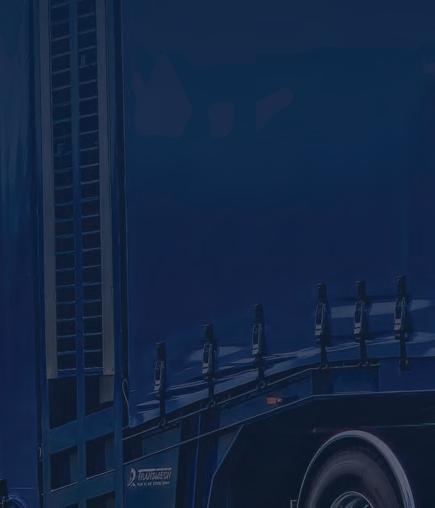

Transmech provides customers with the complete customised package from design, engineering, manufacture, trailer servicing and repairs. Additional capabilities also extend to other specialised transportation equipment, including specialist rig moving equipment for the mining industry.





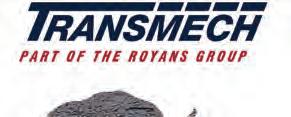





Regulations setting mass limits under the Heavy Vehicle National Law (HVNL) have been amended to allow Australia’s heavy vehicles to meet the latest international standards, according to federal transport minister Catherine King.
From November 1, 2024, general access mass limits will increase by
500kg for trucks in Australia that comply with Euro VI or equivalent noxious emissions standards.
“This will improve safety and emissions reduction outcomes in our heavy vehicle fleet and follows the government’s recent announcement of tighter noxious emissions standards for new
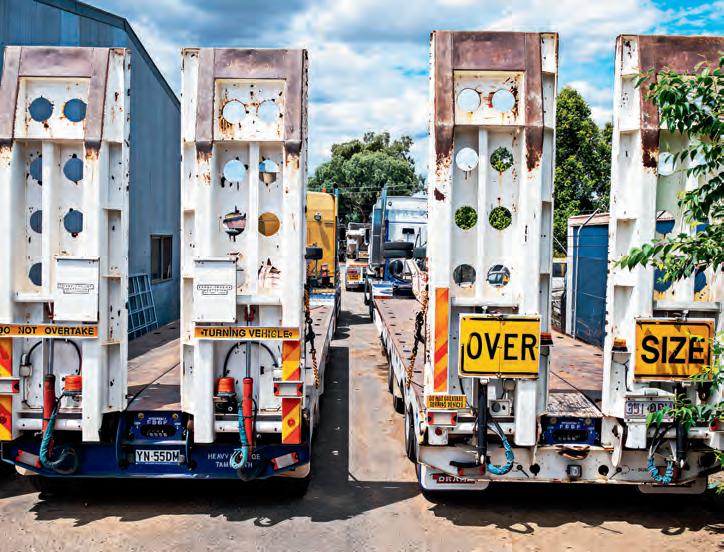
trucks and buses,” King says.
“The increase in heavy vehicle mass limits is an important step towards improving productivity and safety in the heavy vehicle sector, while reducing emissions.”
It follows the government’s recent announcement of the introduction of tighter noxious emissions standards for new trucks and buses, which must also be met from November 1, 2024.
The mass limit amendments have been made under the HVNL, which is based in Queensland and adopted by participating states and territories.
The Euro VI standards will be phased into effect across the 12 months following the commencement in November.
King said that new emissions standards for new trucks and buses will reduce a significant pollutant in Australia when the new standards were first announced.
“These new standards will improve air quality and health
outcomes and bring safer and more efficient trucks into Australia,” she said.
“We are committed to continuing to work with industry and state and territory governments to ensure the smooth introduction of these standards.
“Australia has been lagging in our vehicle noxious emissions standards for years now, and this move will help bring our vehicle market into the 21st century — and into line with overseas vehicle markets.”
Euro 6 standards have already been in place in the European Union and United Kingdom for years, and equivalent standards also apply in most developed countries, including the United States and Japan.
Introducing Euro 6 will mean manufacturers must add the advanced safety and fuel-saving technologies to Australian models that other countries already have – notwithstanding the leadership of many manufacturers who have brought compliant powertrains and safety technologies to market.











• CLIPLOCK features a TWO-STAGE locking mechanism. The industry standard and the Optional innovative GP LOCKING CLIP & LOCKING GROOVE (PATENT PENDING).


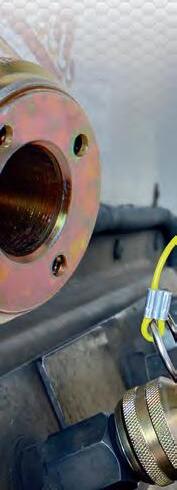

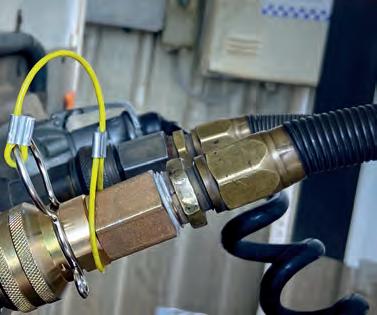

• Prevents incomplete coupling connections of Trailer Airline Couplings.
• A dangling Locking Clip will alert the driver that the Coupling Connection may not be securely connected. Ensures positive and secure connection of the Trailer Airline Couplings.










Industry association NatRoad recognised excellence in the transport industry on the last day of its annual conference on September 13, crowning the winners of its three major awards.
It says these awards “highlight the dedication, professionalism, and commitment of individuals who have set new standards of excellence in road transport”.
The Professional Driver of the Year was won by James Ellison of Ditton Bulk Haulage, recognising his impeccable safety record and dedication to mentoring and uplifting those around him.
“James has been driving over 200,000 kilometres annually without a single incident to date,” NatRoad says.
“His professionalism and
willingness to mentor his colleagues have set a high standard in the industry.”
PowerTorque editor Tim Giles was awarded the Ted Pickering Memorial Award, recognising his 50-year career in the trucking industry both on the road in Europe and Australia, and more recently in journalism.
NatRoad recognised Tim’s “dedication to informing and uplifting the industry, as well as his ongoing passion for technology and preparing the industry for the future”.
Jade Harney from Followmont Transport was awarded the Sam Sali National Young Driver of the Year, named in honour of the late industry veteran.
“Earning multiple licenses and certifications at just 24 years old,
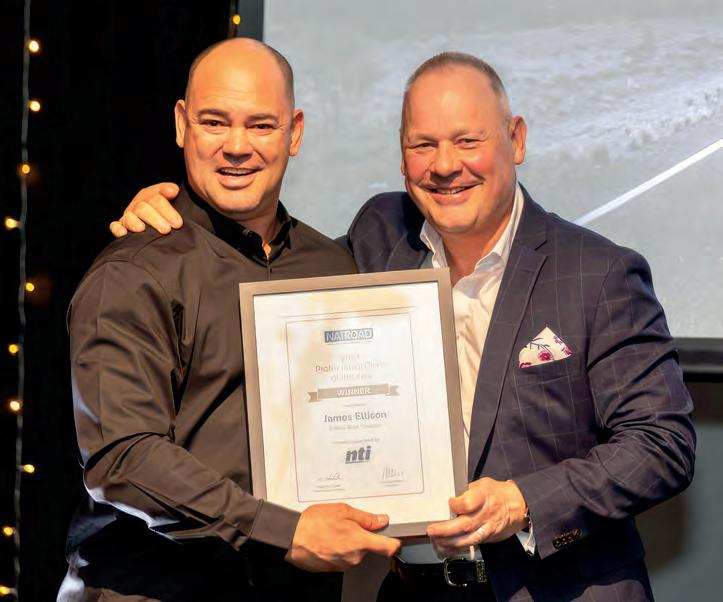
Jade’s dedication to safety and proactive approach to problem-solving have made her a standout in the i ndustry,” NatRoad says.
NatRoad CEO Warren Clark congratulated all the winners from the night.
“These awards reflect the hard work and passion of individuals who have excelled in their roles and gone above and beyond to have a significant positive impact on the
broader industry,” he says.
“This year’s award winners have all made outstanding contributions to the sector. They have truly set the standard in our industry and exemplify the kind of commitment, professionalism, and passion that drives the road transport sector forward.”

Specialists in CAT and Cummins Engines also carrying parts for all American Truck Brands and Road Ranger Gearboxes. Rebuilt and Second Hand Options Available. Warranty with all second hand and rebuilt engines.
CAT C-15 Rebuild (6NZ or 9NZ Prefix) $48,000 + GST exchange on Special Until EOFY or While Stocks Last. (Block Work, Pistons/Sleeves, Cyl Head, Injectors, Turbo, Camshaft, Rocker Gear, Water Pump, Oil Pump). 12 Months Parts Warranty, 6 Months Return to Base Labour. 550 HP Spec.
CAT C13 Engine (KCB Prefix) $25,000 + GST exchange. Second hand engine with 600,000km on it. Runs good with good oil pressure. 60 Days Return to Base Warranty. 470 HP Spec.
CAT C15 Acert Engine (NXS Prefix) $26,000 + GST exchange. Second hand engine. Has had a bearing roll (mains and big ends). 60 Days Return to Base Warranty. 550 HP Spec.
Cummins Signature Gen 2 Rebuilt Engine $48,000 + GST exchange on Special until EOFY or Stocks Last. Block Work, Pistons & Sleeves, Cylinder Head, Turbo, Camshafts, Injectors, Water Pump, Oil Pump all done. 12 Months Parts Warranty and 6 Months Labour.
Cummins ISX 475 Engine Second Hand Engine. $22,000 + GST exchange on Special Until EOFY. Good Oil Pressure, Ran Good. 60 Days Return to Base Warranty.
Cummins Signature Gen 2 Second Hand Engine
$25,000 + GST exchange. Good Oil Pressure, Ran Good. 60 Days Return to Base Warranty.
Cummins ISX Signature EGR Engine. $52,000 + GST Exchange on special until EOFY or Stocks Last. Blockwork, Pistons & Sleeves, Cylinder Head, Turbo, Camshafts, Water Pump, Oil Pump.
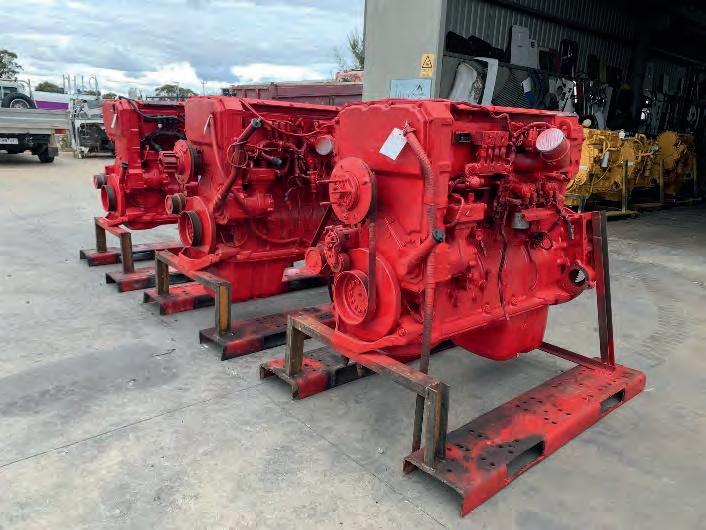
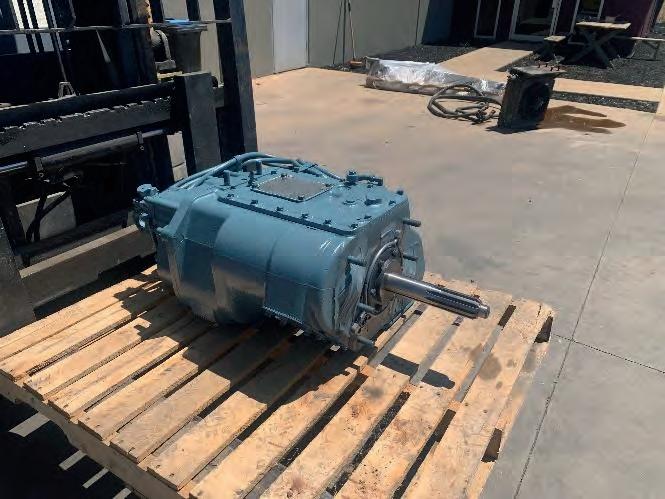
Road Ranger Gearboxes Reconditioned and Second Hand. All genuine Eaton Parts in reconditioned boxes. Various models available including 16718B, 16918B, 18918B, 20918B, 22918B. Call for pricing and availability of your preference.
While there is a clear need for a freight hub in Melbourne’s west, another project hasn’t been able to get off the ground
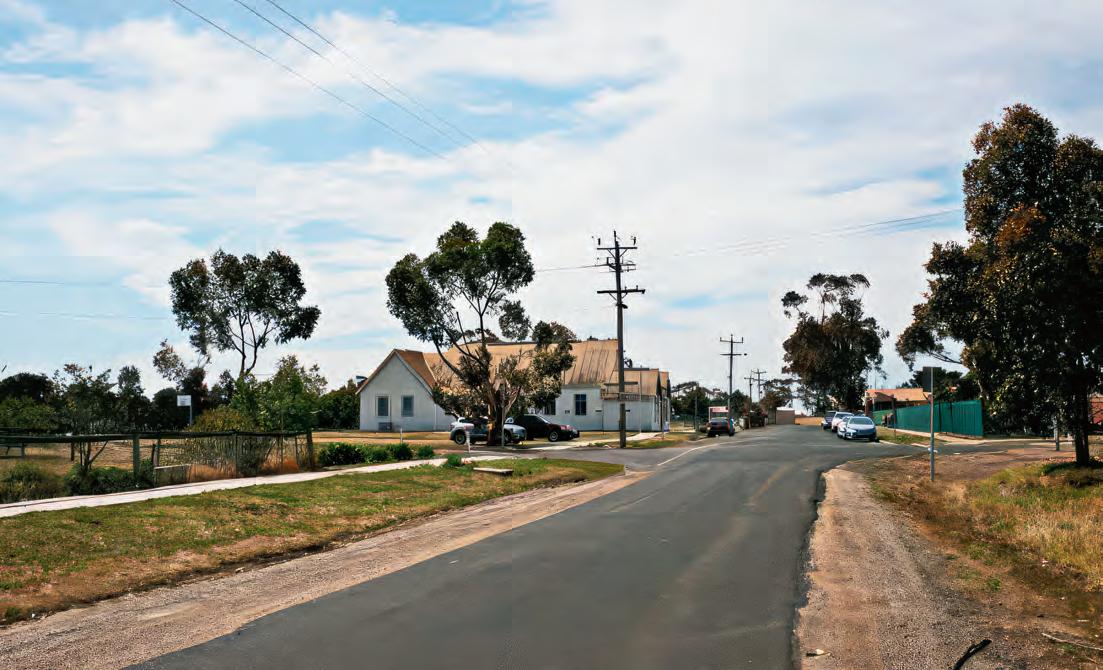
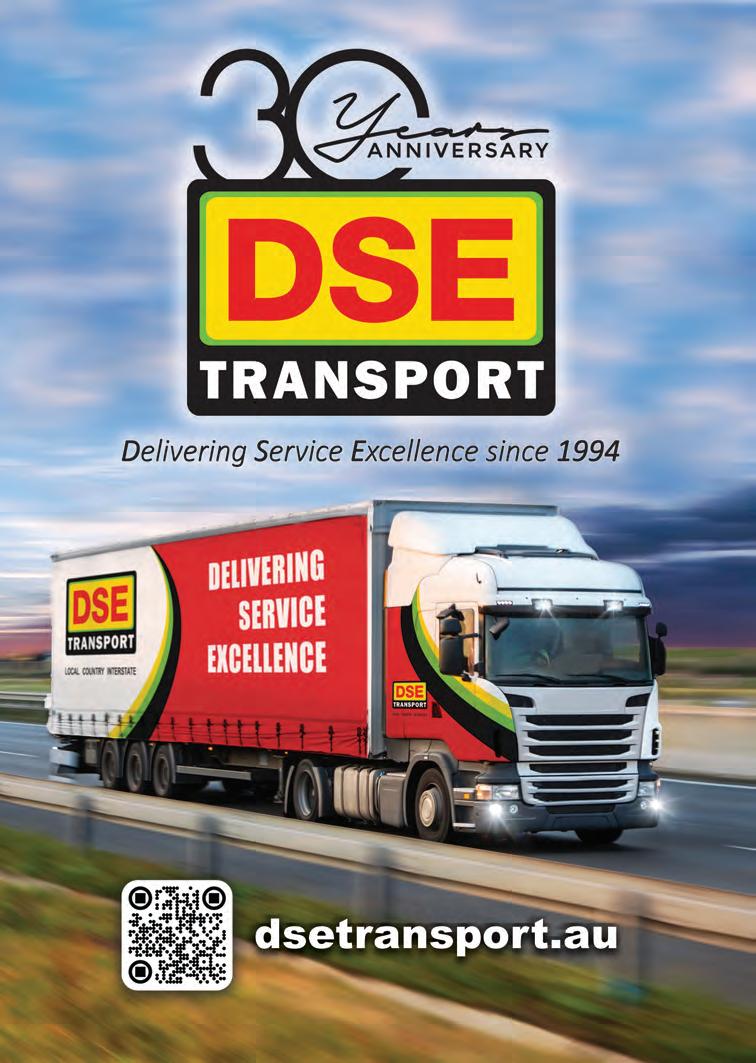
Locals of the Little River area have made their voices heard in opposition to a proposed freight hub that was supposed to commence construction soon.
Located west of Melbourne, in the growing Wyndham region, the freight hub was proposed as a logistics precinct, led by rail freight operator Pacific National.
It was to be a mixed-mode facility, incorporating both rail and road freight to unlock what is becoming a transport and logistics hotspot in Melbourne.
But after the response from the Little River community, raising concerns over the environmental impact of increased freight activity in the region, Pacific National has confirmed it will withdraw from the project.
“Pacific National has commenced notifying relevant statutory authorities and decisionmakers of its decision to withdraw its environmental referrals and applications for planning and environmental approvals for the Little River Logistics Precinct Project,” it said in a statement.
“All work on the Environment Effects Statement (EES), including technical investigations and technical design for the project, will shortly cease.
“Pacific National has made this decision given the changed timelines for associated freight and infrastructure projects and economic factors which have impacted on the project business case.
“Pacific National will continue to consider potential alternative terminal site options as they emerge to support efficient freight transport connectivity.
“Thank you to the many stakeholders, project partners and community members who engaged with the project team to discuss the project and have their say.”
The Wyndham City Council had previously rejected the proposal from Pacific National for the removal of vegetation in the area to start the process of laying out the foundation for the freight hub.
Permits had been voted down by the councillors by a vote of eight to three.
The Victorian government had also made them aware that the Minister for Planning decided in December last year that an environment effects statement (EES) was needed for the Little River Logistics Precinct project to proceed.
“In February 2024, Wyndham City Council considered two applications for vegetation removal — one to allow for archaeological excavations and the other for geotechnical assessments — as part of preconstruction works at the 500ha site on Old Melbourne Road, Little River,” a Wyndham City spokesperson told OwnerDriver.
“Both applications were refused.
“The permit to remove native vegetation for the purposes of geotechnical testing was refused on the grounds that the proposal did not sufficiently minimise the impacts of the removal of the native vegetation and land and water degradation within the site.”
As a part of the technical studies informing the initial proposal, Pacific National had identified a number of key reasons for a hub to be built in the area.
It can considered that rail freight needed to be able to easily access the regions west of Port Melbourne, supported by road freight.
The precinct would have accommodated a rail freight terminal, internal rail sidings and access roads, maintenance facilities and warehouses, and aimed to support more than 3,600 ongoing jobs at capacity.
A Victorian government backed-freight hub project was also scrapped earlier this year in favour of a federal project north of Melbourne’s CBD.









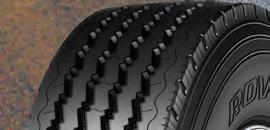




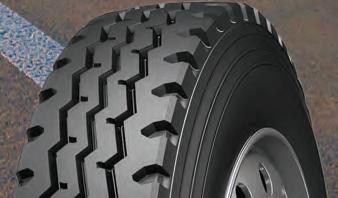

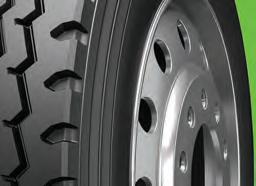
There’s some good news for truckies on the quest
Six new projects have been announced under the Heavy Vehicle Rest Area (HVRA) project, just days after confirmation the project’s Steering Committee of industry professionals had been extended to 2025 to continue to inform the initiative.
The more than $6.85 million committed to the six new projects has been funded through the third tranche of the HVRA, with $5.48 million of the latest round of funding being provided by the federal government while the remainder will come from state, territory and local governments.
Overall, the value of the HVRA is $140 million over 10 years. The newly funded projects, which include the construction of new rest areas with facilities including toilets, resurfacing, line-marking and bitumen sealing are:
• Wollondilly Shire Council –Ted ‘Greendog’ Steven’s truck parking bay renewal (NSW).

• Walcha Council – New Pindari Tops rest area on Thunderbolts Way (NSW).
• Bourke Shire Council – new heavy vehicle rest area on the Bourke to Milparinka Road at Goonary (NSW).
• Shire of Mukinbudin –Mukinbudin heavy vehicle rest area (WA).
• Shire of Coolgardie – Asphalt surfacing of road train/truck stop area at intersection of Bayley Street/Great Eastern Highway and Ladyloch Road in Coolgardie (WA).
• Northern Territory – five heavy vehicle rest areas on Buntine Highway to be upgraded.
HVRA Steering Committee Chair, Senator Glenn Sterle, says the upgrades will continue to improve road safety and outcomes for Australia’s truckies.
“These projects are another example of the federal government’s Heavy Vehicle Rest Area initiative boosting heavy vehicle user safety and productivity through new and upgraded rest areas,” Sterle says.
“We are steadfast in our commitment to keeping our freight operators and communities safe.
“These new and upgraded rest stops will help drivers reduce
Roughly $11.5 million will upgrade a critical stretch of the rural NSW route
The New South Wales government has announced that it is investing $11.5 million into upgrading a six kilometre stretch of the Oxley Highway, approximately 50km west of Gunnedah.
Works got underway on Monday, September 16, with crews working to widen and rehabilitate the pavement, widen nine culverts and seal the 6km stretch of road. Changed traffic conditions,
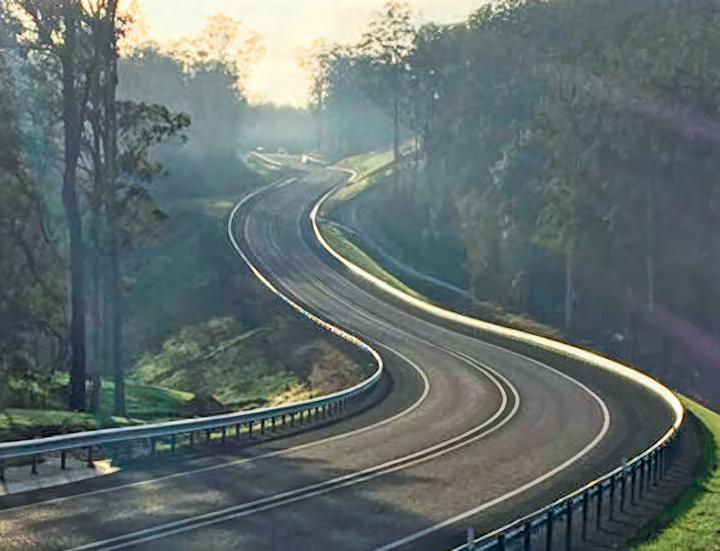
including single lane closures and lowered speed limits to 40kmh, will apply while works are underway.
“This pavement improvement work will deliver a stronger and more resilient road surface, safer turning at the Oxley Highway intersection with Goolhi Road and reduced ongoing maintenance costs,” NSW transport and roads minister Jenny Aitchison says.
“These improvements will benefit all road users, including drivers of heavy vehicles who regularly use this route hauling freight across NSW.
“Crews were relocated from this job in 2021 to provide support to the urgent flood repair work required at various locations across the state.
“Rehabilitating the road surface to make it more resilient will reduce the need for ongoing pavement maintenance and improve the experience for road users, as well as reducing
truckie fatigue as they work hard keeping our country moving.”
Federal assistant minister for regional development, Senator Anthony Chisholm, says the $5.48 million federal investment is part of the government’s commitments towards achieving zero deaths on Australian roads by 2050.
“By investing in much-needed rest stops, we will ensure that truckies spend less time on the roads and get home safely to their loved ones,” Chisholm says.
“I would like to thank the HVRA Steering Committee for their work in identifying these strategic projects, which are essential for the safety of all road users.”
disruptions due to roadworks.”
Works will take approximately eight months, taking place on weekdays between 7am and 6pm, and on Saturdays between 8am and 1pm.
“In recent years, the Oxley Highway has proven to be particularly prone to floods. This work will help improve the road’s ability to resist future flood events and remain open,” member for Barwon Roy Butler says.
“As I have often said, it is important not just to rebuild roads after natural disasters, but also to build them back better than they were. This work will continue the process of making our regional road network safer and less likely to be cut off during heavy rains.”
NSW Labor spokesperson for Barwon Stephen Lawrence says regional NSW makes up a third of the NSW population, but two thirds of deaths on the state’s roads happen in the country.
“This investment will improve safety on the Oxley Highway and will work towards achieving the goal of ensuring everyone gets home safely every time to their loved ones,” Lawrence says.




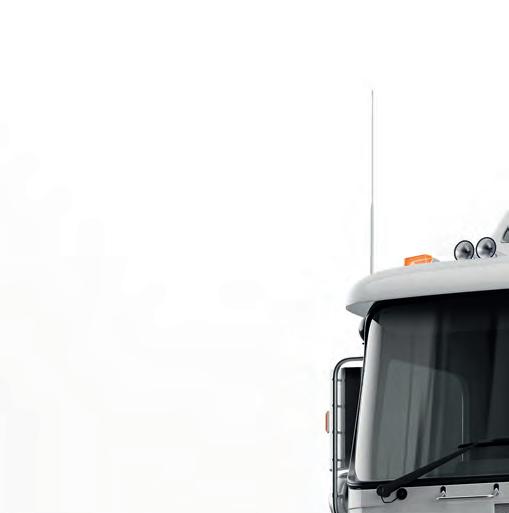


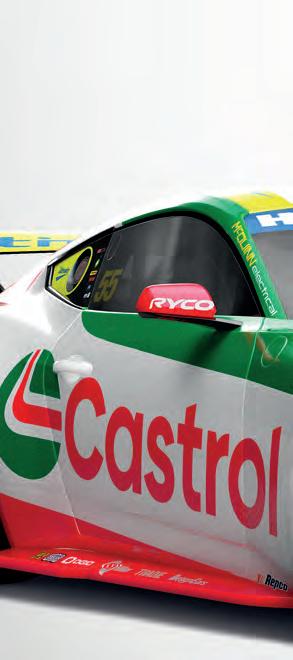

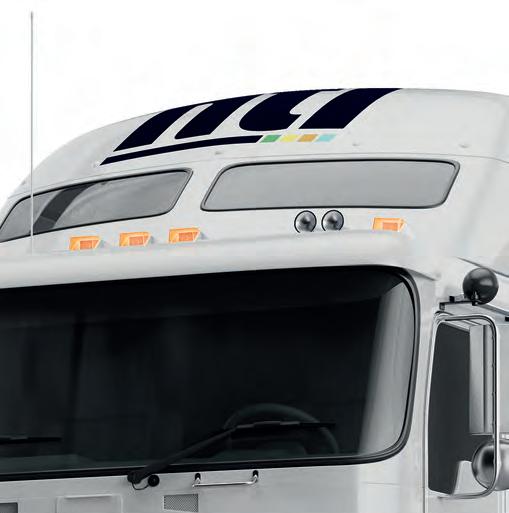






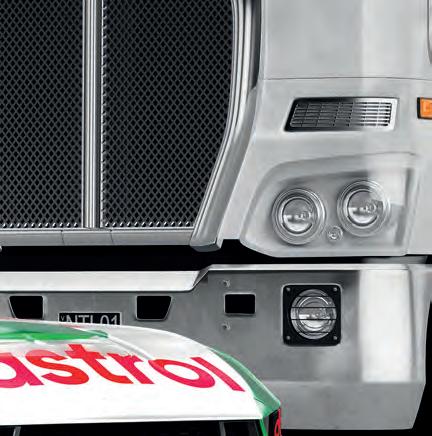
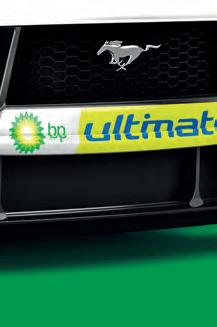




















Tickford Racing trusts Castrol fluids in its supercars and transporters. When performance matters, trust Castrol in your trucks.

25 Main Roads WA inspectors will now use a NHVR app to carry out heavy vehicle intercepts throughout the state

The National Heavy Vehicle Regulator (NHVR) has announced that Main Roads Western Australia’s 25 transport inspectors will now carry real-time heavy vehicle analytics on site that use national technology.
This means that heavy vehicle inspections in the state will connect with the national enforcement database through the NHVR’s Regulatory Compliance Mobility Solution (RCMS) app.
The app allows Main Roads WA to target high risk offenders by giving inspectors access to a central database with driver and vehicle information so that they can administer digital notices during a heavy vehicle intercept.
WA transport minister Rita Saffioti says the RCMS WA app will help improve road safety across the state.
“We know the majority of the heavy vehicle industry are safe and compliant and it’s only a small cohort of high-risk operators and drivers that put themselves and the community at risk,” Saffioti says.
“By leveraging heavy vehicle
“We know the majority of the heavy vehicle industry are safe and compliant and it’s only a small cohort of high-risk operators and drivers that put themselves and the community at risk.”
compliance and enforcement data, Main Roads WA can target recidivist offenders to keep road users safe and prevent damage to the state’s infrastructure.”
NHVR CEO Sal Petroccitto says the app provides a single central system that stores and analyses compliance and enforcement data in real time.
“Camera sightings from over 115 fixed cameras across Australia alerts RCMS users if an approaching heavy vehicle is unregistered, has current defect notices, compliance breaches or recently failed to enter an inspection station,” Petroccitto says.
“The NHVR and Main Roads WA are addressing key safety risks quickly and accurately to deliver an efficient and borderless regulatory approach.”
The NHVR first introduced the RCMS app in Victoria in October 2020 before expanding it to the ACT, South Australia and Tasmania in June 2021, with NSW receiving the app in August 2022.
The app is also now live in Queensland following the state’s transition of heavy vehicle regulatory services to the NHVR in April this year.
Main Roads Western Australia chief operating officer Des Snook says the RCMS will transform its
approach to roadside inspections, with the end-to-end technology removing the need for paper-based forms.
“We expect a 60 per cent reduction in the time spent per heavy vehicle intercept,” he says.
“This targeted enforcement approach rewards safe operators with quick roadside intercepts, as our transport inspectors prioritise unsafe drivers, operators and vehicles.
“We can now collaborate with the NHVR in real time and be alerted to unsafe, high-risk operators travelling between WA and the eastern states, and vice versa.”















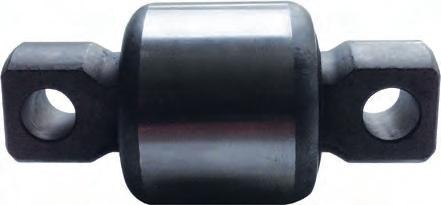















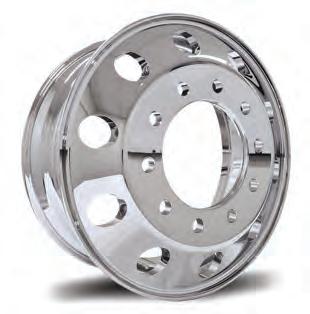
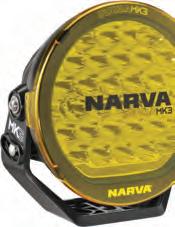

















































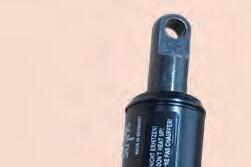
































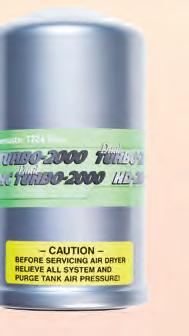











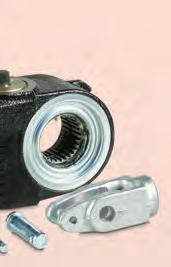





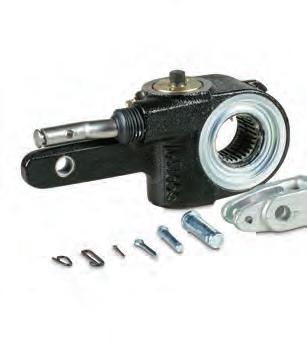



























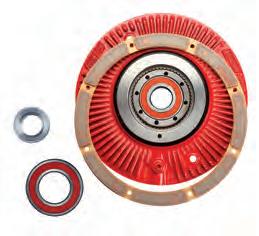



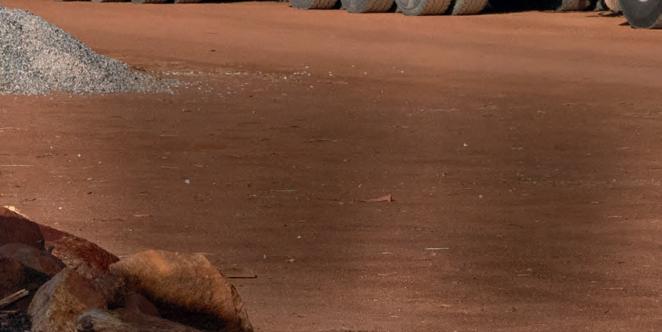





Volvo Trucks recently unveiled its new D17 780hp model, boasting a larger internal combustion engine that provides extra grunt. Warren Aitken hopped behind the wheel to discover the power that comes with Volvo’s latest addition
reckon the best way to start off this commentary on my recent experience with the new Volvo D17 780hp is to share part of one of the many interactions I had with Matt Wood, Public Relations and Media Manager for Volvo Group Australia. This conversation took part with Matt in the passenger seat while I was behind the wheel, pulling out onto Geraldton Mt Magnet Road in the 780hp Volvo with a Western Australian C-train in tow.
“Have you actually put anything in these trailers mate?” I said.
“Yeah, 106.8 tonnes,” Matt replied.
“You’re telling me I’m pulling 106 tonnes behind me?”
“106.8.”
“I call BS, no way.”
“I loaded it myself mate. Bang on 106.8 tonnes.”
That’s where I’ll cut the chat off, for the next couple of comments contained multiple expletives as I accused Volvo’s Media Manager of waxing lyrical and pulling the old weekend fisherman’s trick of ‘I swear it was this big bro’. However, when you put yourself in my shoes, I had just flown 4500km across
the country to test drive Volvo’s latest evolutionary engine. I was being told by a PR professional that it was 106.8 tonnes, yet under my feet I had a road train pulling up the highway feeling quieter, smoother and less hindered than my car with a heavily packed lunchbox. How could I not question the validity?
It turns out that Matt was right — it was 106.8 tonnes and Volvo’s new D17 engine, with 3800nm of torque, was eating it up like Patrick Bertoletti at Nathan’s Famous Hot Dog Eating Contest.
I had been invited over to Geraldton, Western Australia to be impressed, and it took all of about three minutes on the road for that task to be achieved. The rest of the ride out to Mt Magnet was used to solidify my first impressions of this top torque engine and quiz Volvo guru Matt on exactly what was impressing me under the floorboards.
Be warned, 95 per cent of this writeup on Volvo’s latest iteration of the popular FH line is going to be under the drivers’ feet rather than what was wrapped around me. The test truck I had my happy hands on was the newest version of the long
“The moment you put your foot down, the truck gets into the job. Peak range is from 950-1450rpm and the smarter-than-me G-series I-shift does a fantastic job of working the torque curve.”
running Volvo workhorse, but very little has changed. According to Matt, there are several aerodynamic adjustments added for efficiency, however those were hidden by the far less aerodynamic cowcatcher bolted to the front. Inside the Volvo I found all the creature comforts that have made this series of truck so popular — ergonomics aimed at drivers who appreciate comfort, practicality and a bass booming stereo system.
All of the stuff that you take for granted with the Swedish truck maker was on hand and in action. What I went to experience was their new D17 engine and G-series I-shift transmission — a product designed with the future in mind. As many are aware, at the start of 2025, Australia will have a whole lot of new safety and compliance requirements rolling into law. One at the top of the food chain is the necessity for new heavy vehicles to meet the Euro 6 standards.
Volvo has had a Euro 5 and a Euro 6 version of its 16-litre engine available for quite some time and it could’ve quite happily rested on its laurels. However, as Matt explains, it’s just not in the brand’s DNA.
“The motivation behind the 17-litre and 780 is all about sustainability and efficiency,” he says.
“Volvo has made the D17 engine ‘slipperier’, with less friction and drag. It’s more powerful and has a lower drag transmission, which means better economy and efficiency.”
The D17 continues Volvo’s strive for market leading efficiency and world leading technology.
When you look at the stats for the new D17, it is pretty impressive. It features the same crank and block as the previous D16, however the white coats in the Volvo engineering laboratory have made some major changes. The extra displacement comes from a 5mm larger cylinder bore diameter and the added efficiency comes from the low friction cylinder liners, the Volvo patented wave-top pistons and the new fuel injector design. Couple all of that with the updated G-series I-shift and you have a winning formula.
Another big difference between the Euro 6 D16 engine and the Euro 6 D17 is the turbo system. The D16 came equipped with a twin turbo system and found its sweet spot in the 500-600hp market. Although there are several 700hp variants working the tough gigs over here, we never got to see the big 750hp that some countries got, mainly because of the truck breaking conditions we have here in the land of hot and heavy loads. The new D17, however, is fitted with a whole new VGT Turbocharger system, which means it is more than capable of handling the toughest of Australian conditions, with the biggest loads we can throw at it. It also means we finally get to appreciate the biggest torque output the big Swedish scientists
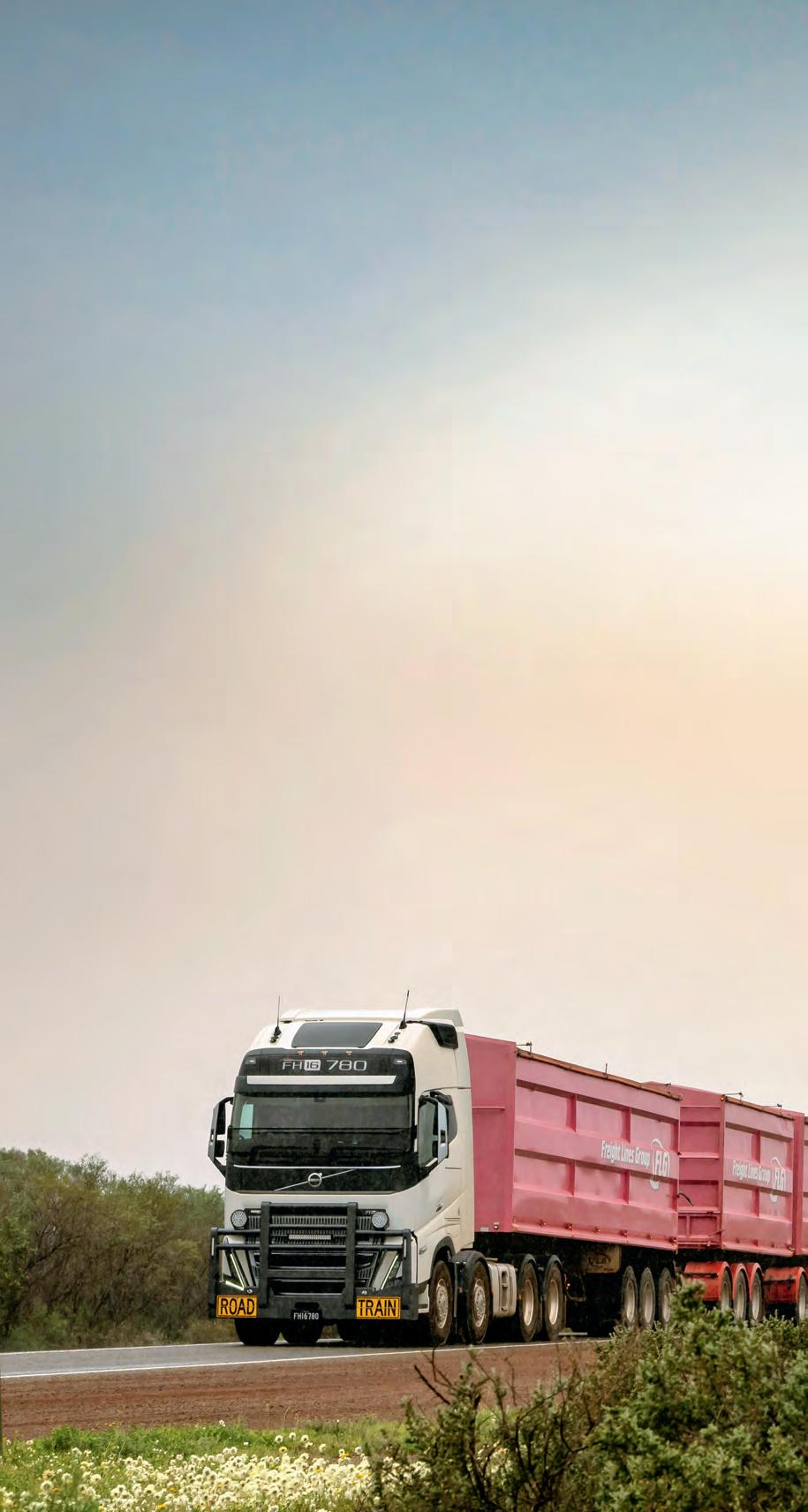

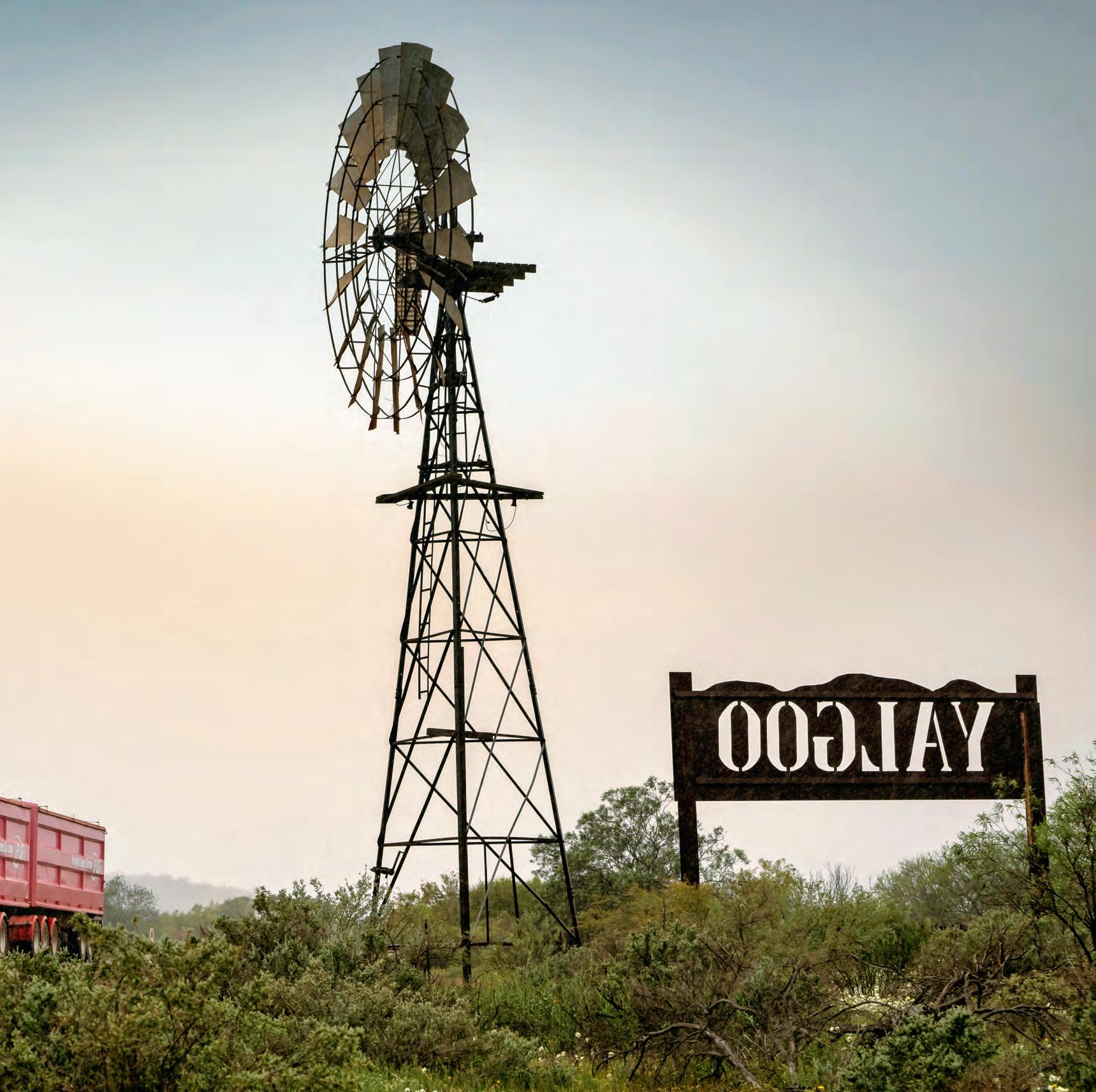
can pack into a 17-litre internal combustion engine.
As I mentioned before, the D17 tops out at 780hp and 3800Nm of torque. You can also get the D17 at 600hp and 700hp, putting out 3000Nm and 3400Nm respectively. It is definitely the torque numbers that deserve all the attention because that is what you can feel when you get behind the wheel of the big 780 Volvo. The moment you put your foot down, the truck gets into the job. Peak range is from 950-1450rpm and the smarter-than-me G-series I-shift does a fantastic job of working the torque curve. You can feel the I-shift changing gears, but in the same way an old school trucker would change gears, doing it smoothly and timed perfectly so there is no break in momentum. It’s almost therapeutic. If you want to take a bit more control or let the big motor rev out a bit more, you still have that option available, but truth be told, the Volvo doesn’t really need any gear changing tips.
The Volvo 780 will garner a lot of attention for the fact it’s made it to the highest horsepower number to date. While being able to wave that Everest size flag is important, for the drivers and for the owners there are going to be two very different
For the owners it will be about the numbers, specifically the fuel numbers. It is a bigger, more powerful engine than Volvo has had before, but the technology and efficiency inside it has been designed to make the latest Volvos even more fuel efficient than we’ve seen before. Obviously, I can’t quote numbers, as every application is going to be different, but across the board, the D17 is delivering on its design goal of improving fuel efficiency and that’s the important thing for owners and companies.
For the driver’s litmus test, the verdict all comes back to chasing that hot damn hill feeling. That feeling of having a fully laden truck dropping gears as it reaches the pinnacle of whatever legendary jump up you travel, watching the revs drop down and down, waiting to feel another gear, and then noticing that instead of dropping, the engine has just dug in, holding on and hooking into the hill like it’s stolen your lunch and you’re not letting go. There is something in that feeling that all drivers know and the 3800Nm of torque oozing from the new 780hp Volvo will ensure you get that feeling on every hill you hit. 106.8 tonnes. I believe it now, colour me impressed.


The ability to access the Fair Work Commission thanks to recent transport law reforms presents an unprecedented opportunity to set fairer standards
There are over 500,000 transport workers in Australia. But we are all intrinsically and deeply connected to the transport industry. When lives are lost on our roads, they affect countless families and communities. This year and every year we have lost far too many from truckrelated crashes — 140 just in 2024, 35 of them truck drivers.
Recently transport reform laws came into effect that will allow us to improve this industry for all participants. Not only that, it will allow us to save lives. That’s pretty big. It’s so big that to mark the occasion we had guests in Sydney from international transport unions, coordinated by the International Transport Workers Federation which represents over 18 million transport workers — guests from across Europe, Africa and Asia. It’s not just a huge moment for Australian transport, it’s a big global moment.
Other countries are looking on, and last year 67 other unions around the world signed up to a global campaign to secure similar systems. For decades we’ve talked about what these laws would mean to this industry. Now it’s time to use them to actually start fixing things. We’re wasting no time.
Two days after new transport laws came into effect, we made our first applications to the Fair Work Commission to begin making road transport a better industry. These have been informed by discussions with industry over the last few months after we won the laws.
The applications are in three areas — three areas that require critical action.
The first is unfair terms in trucking contracts. We need to ensure that maximum 30-day payment terms are standard, and get rid of terms that force transport operators to dangerously cut costs in their operations.
We’ve seen scores of transport businesses go under because of unsustainable contracts — even leaders in their industry, like Scott’s Refrigerated Logistics last year. Drivers and operators shouldn’t have to wait months just to be paid. This application will seek to lift some of
those critical pressures on workers and operators.
The second is food delivery, where the standards are not just rock-bottom, they’re non-existent. We need to stop the horrific exploitation of gig workers and we need to make sure it doesn’t spread by raising standards to a decent level.
On the day we made the applications we were joined with gig workers like Rosalina, who’d come to the Fair Work Commission seven years previously trying to get justice, and being turned away. Gig workers until now have been excluded entirely from the workplace system, and that needs to change.
The third is the last mile sector, which is exploding in Australia, but with entrants like Amazon Flex, standards are plummeting.
Amazon recently announced it was recruiting hundreds of seasonal workers, “no experience required.”
We’ve seen how it will recruit drivers with their own cars, dangerously overloaded, rushing to fulfill a set amount of orders. If they don’t complete them in the allotted time frame, supposedly they can bring the undelivered parcels back to the depot—but in doing so risk being deactivated.
twu@twu.com.au
This model is a threat to couriers, to owner drivers, to transport operators, to the Amazon Flex workers themselves. We need to ensure drivers can access fair cost recovery, dispute resolution and consultation. This will stop the Amazon effect that is crushing this sector of the industry.
Rome wasn’t built in a day, and after decades of neglect, there’s a lot of work to do.
The applications we’ve made using the new laws are just the beginning — an immediate safety net to stop the dangerous downward spiral, while we work on more involved issues with the rest of the industry. So how will we achieve all this?
This is where industry consultation, the heart of the system, comes in.
There are three main parts to this. First there’s the Expert Panel which will establish and maintain standards.
Second, this will be guided by the Road Transport Advisory Group.
Recently Richard Olsen, TWU NSW Secretary, and Peter Anderson, ARTIO National Secretary, were appointed to that group. Both have decades of experience in the transport industry.
The third part are subcommittees which can be formed of other industry stakeholders, so that those who will be affected will have a say.
It’s industry unity that got us here and it is industry unity that will allow us to start reshaping road transport with this powerful tool.
The brilliance of this system is its ability to overcome threats to that unity in the likes of Amazon and Aldi who refuse to get on board.
Aldi is the only major supermarket that hasn’t signed a charter with the TWU on supply chain safety. Aldi and Amazon continue to stick their heads in the sand. But we’ll carry on with or without them, because we’ve already shown that when we join together as an industry there is nothing that can stand in our way.


















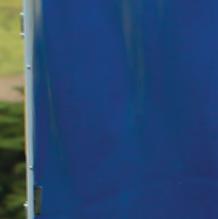

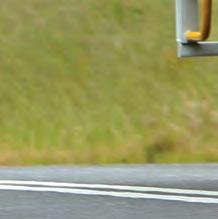









When it comes to fully automatic transmissions, Allison Transmission is the choice of the transport industry. Fleet owners and operators understand that in terms of reliability, productivity and ease of operation, no-one comes close. What’s more, our national distribution and dealer network is here to provide all the support and maintenance you’ll need. That’s why Allison is Australia’s number one choice for fully automatic transmissions in medium duty and light heavy duty truck sales.

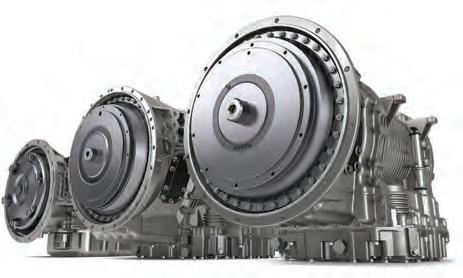

Just a decade ago, Samantha Ruggeri was a dance teacher studying for a diploma. Now, she’s the queen of the Kleening Zone in WA, where she helped keep Warren Aitken’s big rig shiny
This month’s ‘Woman in Trucking’ feature is going to be focused away from the driver’s seat, as our central character doesn’t even hold a heavy vehicle license, yet. However, she plays a pivotal role in an area very dear to the heart of most truck drivers — the ‘looking sharp and shiny’ arena.
I am focusing on Samantha Ruggeri, a young lady who, up until 10 years ago, admitted she had no idea what the bonneted and cabover terminology meant in reference to truck and wasn’t able to point out an A-double Mack unit or know what a Kenworth road train was. Growing
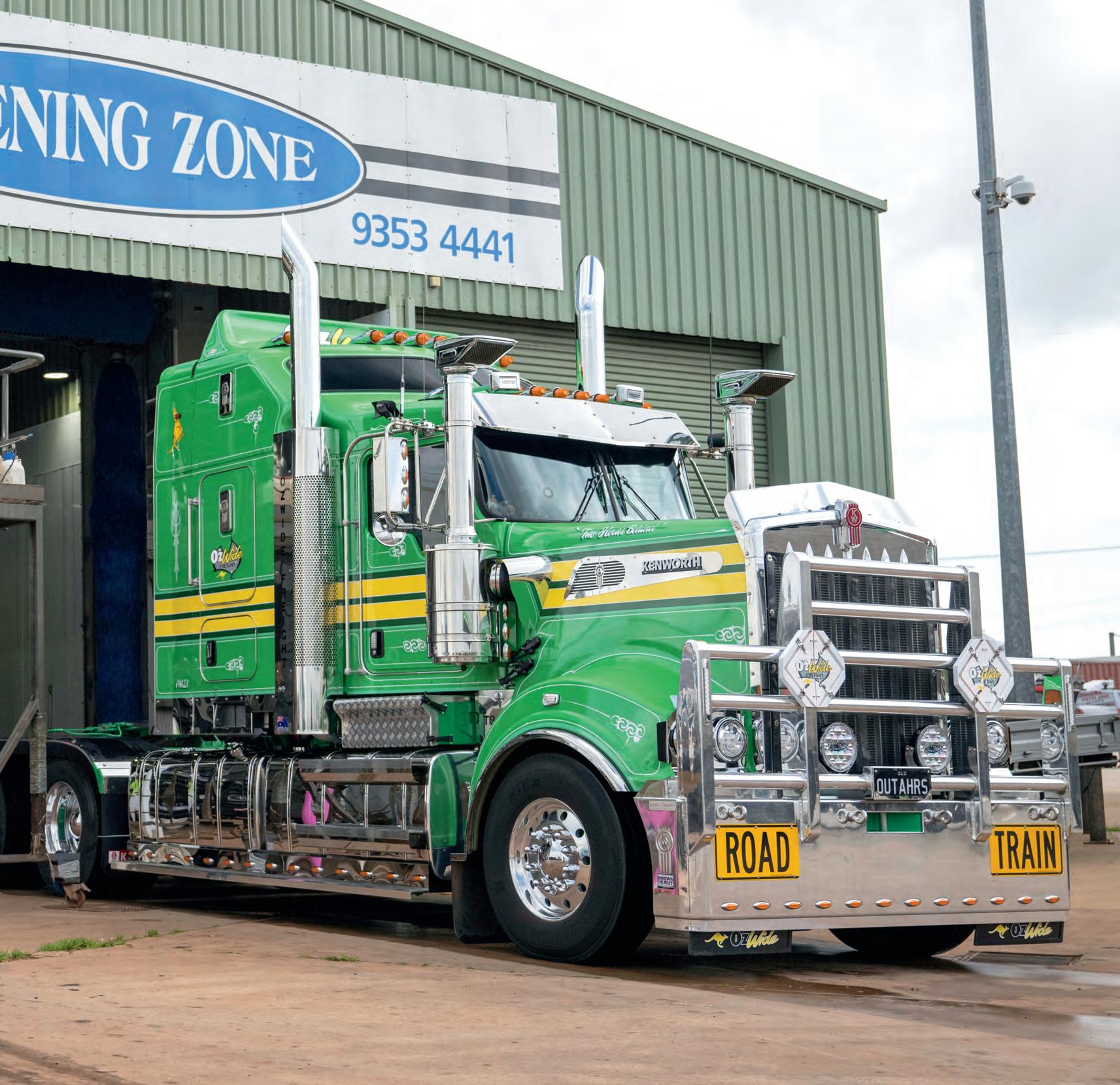
up, Sam’s expertise lay in teaching and dancing, a far cry from the dirt and detailing that now encompasses her life. However, before Sam hit her 20s, she got introduced to the world of trucks and transport and the addiction took hold. Ten years later, she is eying up the idea of getting her license while running one of Perth’s busiest truck washing operations and being a Zen-like master of all things soap. She is the go-to lady when it comes to making a showpiece shine.
In order to introduce the lovely Samantha Ruggeri into this tale, I need to set the scene a little. I had just arrived in Perth, having driven from Brisbane. The first 90 per cent of the 4500km trip had been great weather, meaning I retained the shiny wheels and pristinely polished paint and had only the inconvenience of surfeit of suicidal bugs to contend with. That’s fine, I had my bottle of Bowden’s Bugger Off and Jax Wax Body shine, so I had been able to keep my truck looking pretty damn good. However, the final 10 per cent of the trip involved rain, inappropriately located rain, to be exact. By that I mean it only rained around the same sections of road that the big WA quad tippers all entered the highway from their stockpiles
and quarries, leaving kilometres of dirt, which turned into kilometres of dirty brown road spray. This resulted in my road train looking like it had spent a week bush bashing in the Pilbara. I did not have enough micro-fibres to rescue the shine hidden under a layer of WA dirt, so while I was waiting to reload in Perth, I popped into the Kleening Zone and booked the big rig in for a little TLC, which is where I met Sam.
What convinced me to sit Sam down and learn a little more about her was when I discovered she wasn’t just the smiley face that answers the phones and books the trucks in. She was the person that created the deep dive questionnaire you need to pass just to get a booking, a questionnaire that rivals any onsite induction course. It’s a questionnaire that shows how committed to cleanliness the Kleening Zone team are, and it reflects the depth to which Sam’s passion for the transport industry has hit.
Sam is a truck washing guru. What started as a parttime job has now become a Certificate in Shine for the young lady running one of Perth’s largest and busiest truck washes. She is also someone that, up until a decade ago, was teaching a classroom of five-year-olds how to
Above: Sam credits her dad with a lot of her accomplishments, particularly her work ethic and her addiction to ensuring the highest quality service possible. She grew up watching her dad work round the clock and with utmost professionalism, now she carries the same standards as she oversees the family business.
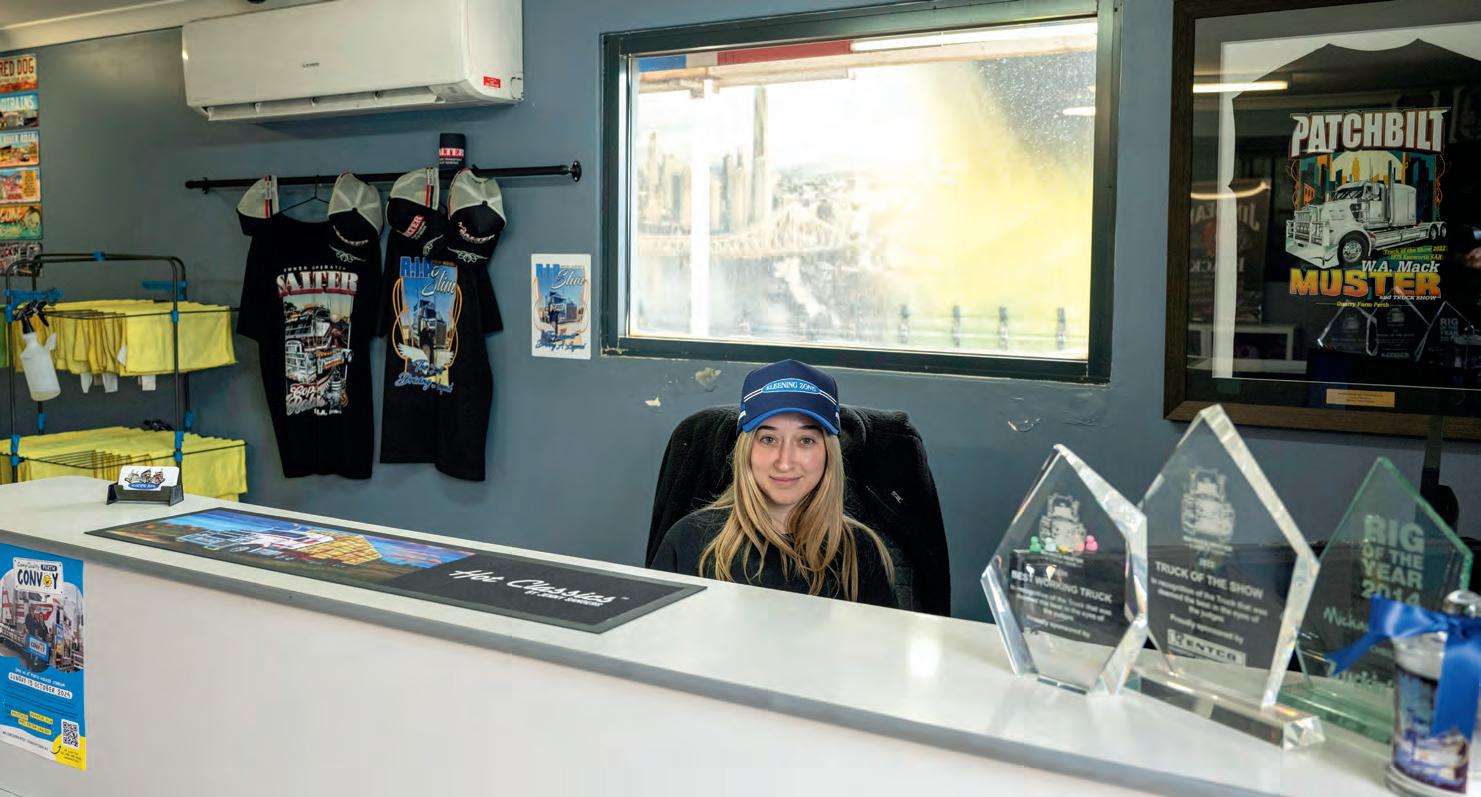
“I definitely have my favourite trucks now, but most of all, with doing a lot of the cleaning, I really appreciate how important the trucks are to the drivers and how it’s our role to ensure we clean them with the care they need.”
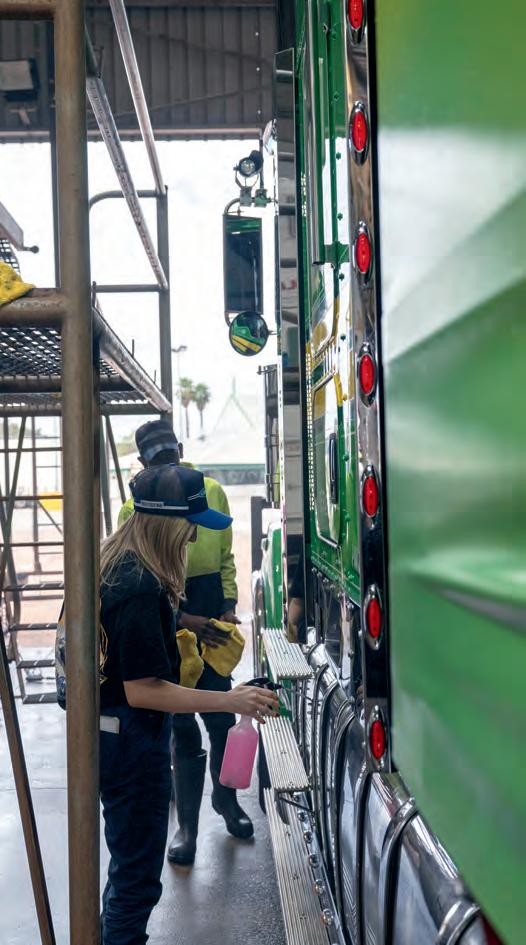
dance while gaining her teaching diploma. Now she has been bitten by the transport bug and has become the sovereign supreme of soap.
“I started working here about 10 years ago,” Sam says.
By ‘here’ she is referring to the business her father bought around 2009 in ‘The Kleening Zone’.
“I was only here part-time to start — I had another part-time job and was at uni, so I would just work doing the invoices. I wasn’t even helping with the booking because I didn’t know one thing about trucks.”
While Sam may not have had a deep background in transport, one thing she had picked up from her dad Jamie was a very strong work ethic. The part-time element of her job quickly became all-encompassing and soon enough her passion for the transport industry saw the idea of becoming a teacher shelved as Sam ended up full-time at The Kleening Zone.
“I started taking on more and more responsibilities,” she says.
“Dad was teaching me and introducing me to all the different trucking configurations, as well as a lot of the drivers that came in. They were great — they’d get me out to show me the setups and types of truck they drive. At the start I didn’t even realise there were different makes of trucks.”
It wasn’t just managing the business that appealed to Sam.
“I really love getting out and cleaning — even now when I am running everything in here, I will still get out and help the team to clean as often as I can,” Sam says.
“Back at the start I had someone teach me how to wash a truck. From starting at the top, to ensuring the truck stayed wet and had nothing baked onto it, to which parts you could use brushes and which parts you had to use sponges on, I really began to appreciate the importance of what we do, and I am thankful for those lessons.”
Sam credits a lot of the regular customers for fanning the flames of her trucking passion.
“I definitely have my favourite trucks now, but most of all, with doing a lot of the cleaning, I really appreciate how important the trucks are to the drivers and how it’s our role to ensure we clean them with the care they need.”
It’s that level of attention and comprehension that saw Sam throw herself into the seriousness of her role.
“I have become extremely well informed about soaps,” she says.
“I have investigated a lot of different soaps, working out which ones work best in our conditions, which ones work best on the red dirt trucks, all that sort of stuff. There’s a lot more to it than just ‘a truck wash’. When I’m booking the trucks in, I ask a lot of questions, finding out where the trucks have come from and what they cart is important. I like to know if there’s particular areas of the trucks that need attention so I can factor that into the schedule, finding out if they want a wax as well. All that sort of stuff is important.”
While Sam’s love for the transport industry has evolved as her years behind the gurney have compounded, her pre-

existing skills have continued to flourish in her new role. Ingenuity and personal management are two skills that have played a huge role in the success of both herself and the family business.
“Co-ordinating the books and timing the bookings I find second nature now,” Sam says, a task made easier by actually knowing the different combinations.
“I also know which staff members work better together and in what areas, so I know I can put certain ones together and they’ll push out a particular truck in a certain time. We have a great crew working for us and they make it easier.”
It’s not just soap and staff that Sam has mastered in her new role.
“I also have a huge whiteboard of ideas I am slowly convincing my dad to implement,” she says.
Those ideas are seeping through, such as the idea for the movable gantries that Sam designed, and her dad and brother built.
“I wanted something that would make it easier for our team to clean safer and more efficiently. I came up with a design, and dad can build anything, so he and my brother just knocked them up for me.”
Adding a wash and wax option to the truck wash services was also well received by Kleening Zone clients as an extra level of protection for the recently shined up rigs. Another outside the box idea was lining the interior shed with white panelling, the premise being that not only would it tidy up the wash bays and make it easier to clean, but it would also add more light to the sides of vehicles, ensuring less missed spots and a better overall job done.
Sam’s formative years may not have included any thoughts of getting into the transport industry, however it is now a major part of her life and indeed her future.
“I think the transport game is a great place, especially for female workers. People have an idea of what ‘the transport industry’ is like but I have found it great. It can be a really big family, once you are in there are so many people that are keen to teach you and help you,” Sam says.
Sam also points out that in her line of work she is not
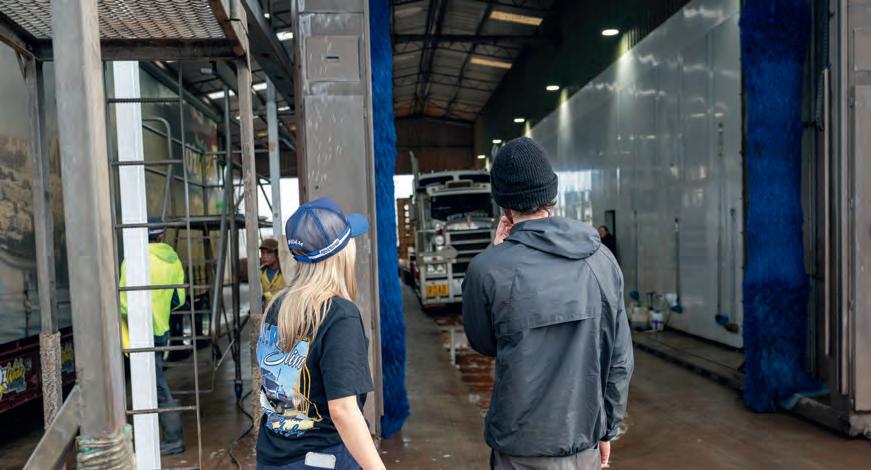
Top: Sam’s original motivation for the family-built gantries may have been influenced by her diminutive size, but they make life easier for all the team, allowing for easy access to the harder to reach areas of the trucks
Above: Managing and helping her staff is a huge part of Sam’s role, the fact she understands the roles they have makes it easier to problem solve and keep the system working effectively
Opposite: Sam’s familiar smile is a welcome greeting to all those coming in for a bit of a tidy up in Perth’s Kleening Zone truck wash. Take note of the huge stack of micro fibres drying behind Sam, the tools of the trade are on high was rotation; It’s not all office work for Sam, she enjoys being able to get out and help the Kleening Zone team to get the trucks shined up
the only female keen to pick up the sponges and tyre shine
“We’ve had a few females working here and they were great. The guys are also great when it comes to working alongside them,” she says.
“There are areas that just need a bit more elbow grease and the guys will pitch in and help on those spots, it’s teamwork. It isn’t easy work, but it doesn’t matter if you are male or female, you get the job done.”
I shall wrap up my homage to truck washers by once again just trumpeting the fantastic appeal and diversity of our industry and the opportunities for ‘Woman in Trucking’ to get in and master every aspect. Samantha is a shining example of the alure of our industry. At 20 years old, a truck was just an annoying moving roadblock getting in her way on the journey home. Now, a decade later, she is looking to add a heavy vehicle license to her repertoire. And as for those moving roadblocks, now Sam can’t travel anywhere without noticing and admiring them, albeit with a critiquing view. Welcome to the club Sam.

Owner-driver Michael Bransgrove has taken the lessons of the past forward when it comes to his own journey as Alex Catalano found out
Being able to confidently and securely own a truck can be a challenging experience in the current trucking landscape — just ask owner-driver Michael Bransgrove. He’s been in the game for as long as he could sit behind the wheel, getting his first taste of driving with his father, also an owner-driver.
“I didn’t have a lot of hope!” he tells OwnerDriver.
“I spent a lot of weekends growing up washing dad’s truck, greasing it. It was pretty much inevitable that I ended up in it.”
Michael’s first job was in his dad’s truck, carting paper and bricks from their native Gippsland to Melbourne and back.
One became two as he got more involved in the business, with the pair driving Scanias on shorter local journeys most of the time.
As work expanded, Michael found himself driving interstate, going as far as Newcastle in a truck that was only meant for local work at most.
“I did that for about 17 years. Dad ended up with about half a dozen trucks across that time,” he says.
“The Scanias weren’t quite right for driving interstate though. The bed wasn’t big enough and they were underpowered.
“We got into Freightliners after that, which dad had a few of over the years. They were a lot better to live in than the Scanias with their set up.

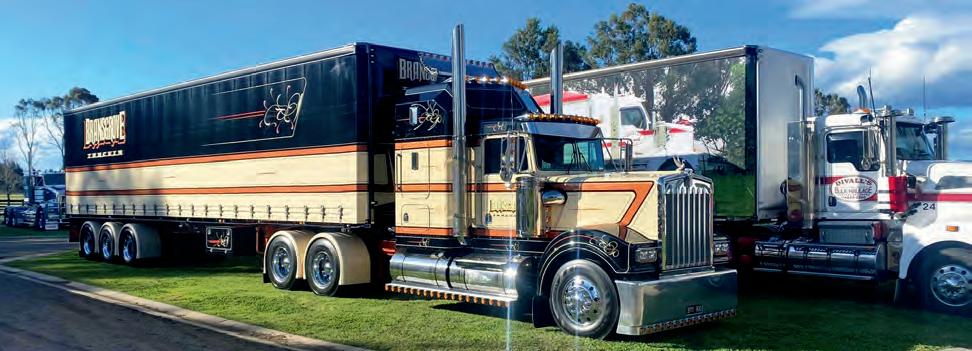
“It was hard on the family though, you sacrifice a lot being away at that time when your kids are growing up.”
With more considerations to make for the family, Michael dialled it back to local work for the last 18 months of working with his dad. As many ownerdrivers would know, when work comes calling, it can be hard to refuse.
“We ended up with another job which I said to dad, ‘you should get a new truck for this one’,” he says.
“He was pretty convinced he’d bought his last truck,
and suggested I buy my own. That’s pretty much how I got into owner-driving, with help from him.
“I don’t know how anyone starts off as an owner-driver these days without help from someone. I’ve been working for myself now for 12 or 13 years.”
While it was a daunting task to take the next step into being a fully solo owner-driver, Michael was taking plenty of lessons learned from the start of his career into it.
Making the leap
Following in his father’s footsteps, Michael went out and bought his first truck – a brand-new Freightliner Argosy.
After enjoying the Freightliners he’d been driving previously, it was a no-brainer. He says a number of factors came into account, as he had to look closely at the reliability and productivity of his truck.
Any downtime or potential loss of revenue would be a killer, as he had discovered from his dad’s work.
“The Argosy came with extended warranty on the motor and driveline,” Michael says.
“That gave me peace of mind, I didn’t have too many concerns. I knew the costs were going to be covered by it.
“The biggest thing I noticed that was different going out on my own was that concern of costing.
“When you’re working for someone and something’s gone wrong, the motor’s blown up or I’ve done a diff, your only concern is how you’re going to get home. When it’s your truck, you’re thinking how am I going to pay for this?”
Michael managed to stay mostly in Victoria across his time in the Argosy, about 600,000km in total, but still did some interstate work.
He stuck with Freightliner for his next purchase, jumping behind the wheel of a Coronado next, which he had for four and a half years.
That was when his love of customising trucks really started to come out. It’s another benefit of being an owner, Michael says, being able to change and shape your truck to your heart’s content.
“I like to customise trucks, and I went to town on the Coronado,” he laughs.
“I really enjoyed it. It was a nice truck to live in, drove well and was comfortable.
“Dad was normally pretty good when I wanted to customise his trucks, but sometimes I could see him looking sideways thinking ‘what’s going on here’!”
Michael’s most recent purchase, and his current truck, is a Kenworth T900 Legend – the stuff of dreams.
Beautifully painted and finished in a combination of black, tan and brown, it’s certainly a sight to behold, both on the road and off it.
He bought it in 2017 and has already put a cool 1.2 million kilometres on the odometer.
There’s almost a childlike wonder in Michael’s voice when he speaks about the Legend — it goes to show his passion not only for the job, but the truck itself.
“We did all the customising on it at home in about 30 days and then sent it away to get painted,” he says.
“That’s one of the main reasons I’m an owner-driver. I could make more money and have a different lifestyle doing something else, but I love the machinery.
“If I could keep my truck sit in the shed and not have to work it, I’d do it every day of the week. I just love the trucks.”
Words of wisdom
With now more than a decade of experience as an owner-driver under his belt, Michael has taken plenty of learnings out of his career on the road.
One of the things that he’s strived for is a ‘point of difference’ — particularly important when you’re competing for contracts constantly as a part of the job.
“You have to be doing something different from everyone else,” Michael says.
“If you want to buy a truck and cart 24 tonnes and make a reasonable living, it’s not going to happen. You have to be proactive and find the most productivity out of your truck.
“I specced my truck up really light so I can get a 29-ton payload. I went down a different path, doing investigations on diff ratios to try and save on fuel.
“Every .1 of litre of fuel you save can save you $700 or $800 a month. These are the little things.”
As much as being an owner-driver can be hard, lonely work, Michael says building business relationships in areas you may not be as proficient in is vital.

“It’s easy to work hard and make no money.
“You do a lot of hours, doing maintenance and bookwork along with the driving. You want to put as many things going in your favour.
“It’s important if you’re not proficient in certain areas that you get help with it, whether it be insurance, maintenance or the business side.”
Adding to that, being familiar both with your customers, both their products and business, as well as your own responsibilities on the road, will go a long way.
“One of the biggest problems is the chain of responsibility,” Michael says.
“The responsibility on you as an owner is quite extreme. You have to take the risk into account. You need to be making more out of that, in case something does happen. You’re the front line.
“A lot of people get into the truck without realising that, and then it’s too late if something does happen.
“As an owner-driver you have to realise the customer is king. Not necessarily your contractor, but where your product is going. It’s important to understand their business, their product and how they’re using it and how you can make them happy.
“I remember dad going through tough times as an ownerdriver, and he always depended on whether he had good work or bad work. It’s all about relationships.”







October’s big in the trucking world for an abundance of truck shows, it’s also home to Halloween, but what about the music world?
Here are some notable events and anniversaries related to Australian rock music history that took place in the month of October: from The Australian Truck Radio Rock’ N Roll Diary!
OCTOBER 1
1980: INXS released their self-titled debut album INXS. This marked the beginning of the band’s rise to international stardom, blending new wave and rock sounds that would become iconic in the 1980s.
OCTOBER 4
1976: AC/DC released their album Dirty Deeds Done Dirt Cheap internationally (though it had been released earlier in Australia in 1976). This album became one of their classic records, featuring the title track as a signature anthem.
OCTOBER 6
1997: Silverchair released their second studio album Freak Show, which solidified their position as leading figures in the post-grunge scene. The album debuted at No. 1 in Australia.
OCTOBER 8
1987: Midnight Oil released their influential album Diesel and Dust in the U.S. This album featured their massive hit “Beds Are Burning,” which raised awareness about Indigenous rights and environmental issues in Australia.
OCTOBER 13
1986: Divinyls released their album What a Life!. It included the popular single “Pleasure and Pain,” showcasing lead singer Chrissy Amphlett’s raw vocals and the band’s unique mix of rock and pop.
OCTOBER 18
1975: Skyhooks released their second album Ego is Not a Dirty Word, which topped the Australian charts and became an essential part of the Australian glam rock scene in the 1970s.
OCTOBER 19
1973: AC/DC played their first gig in Sydney at the Chequers Nightclub. This performance was a crucial moment in the band’s early years, eventually leading to their iconic status in rock music worldwide.
OCTOBER 23
1990: Cold Chisel reformed for a brief tour after their initial breakup in 1983. Their reunion, known as the “Last Stand Tour,” reignited interest in their music, particularly songs like “Khe Sanh” and “Flame Trees.”
OCTOBER 30
1984: Hoodoo Gurus released their debut album Stoneage Romeos. This album gained critical acclaim for its energetic mix of garage rock and new wave, influencing many Australian bands that followed.
“AC/DC played their first gig in Sydney at the Chequers Nightclub”
SIMON SMITH is the manager and producer of Australian Truck Radio. He has been in the radio game for 44 years and has been customising playlists for truckies for at least 20 of those. For great tunes 24 hours a day, 7 days a week, download the digital app for your phone at www. australiantruckradio. com.au

1981: Men at Work released their debut album Business as Usual in Australia. The album would later top the charts globally, fuelled by hits like “Down Under” and “Who Can It Be Now?” It became one of the best-selling Australian albums of all time.
October 28, 1956: Jimmy BarnesScottish-born Australian rock singer, known for his work with Cold Chisel and a successful solo career.
October 16, 1953: Peter Garrett - Lead singer of Midnight Oil and former Australian politician.
October 27, 1959: Andrew Farriss (born October 27, 1959) - member of INXS, key songwriter and multiinstrumentalist for the band.
ABOVE RIGHT: Get on board with Australian Truck Radio
BELOW: Celebrate the great musical milestones of October
These events highlight the influence of Australian rock on both the local and international stages, particularly with bands like AC/DC, INXS, and Midnight Oil shaping global music trends. October is full of anniversaries that mark key moments in the Australian rock evolution that powers Australian Truck Radio 24/7 around the Nation.





















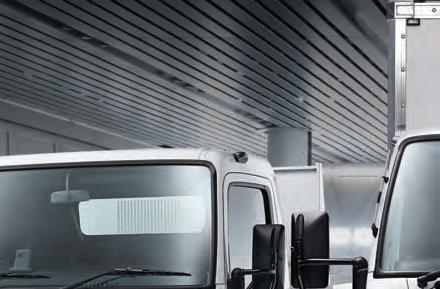
















































































An Australian operator recently paid tribute to Kenworth’s centenary celebrations with a unique configuration. While checking out the truck, Warren Aitken soon found that the family company at the helm of the vehicle has its own intriguing story






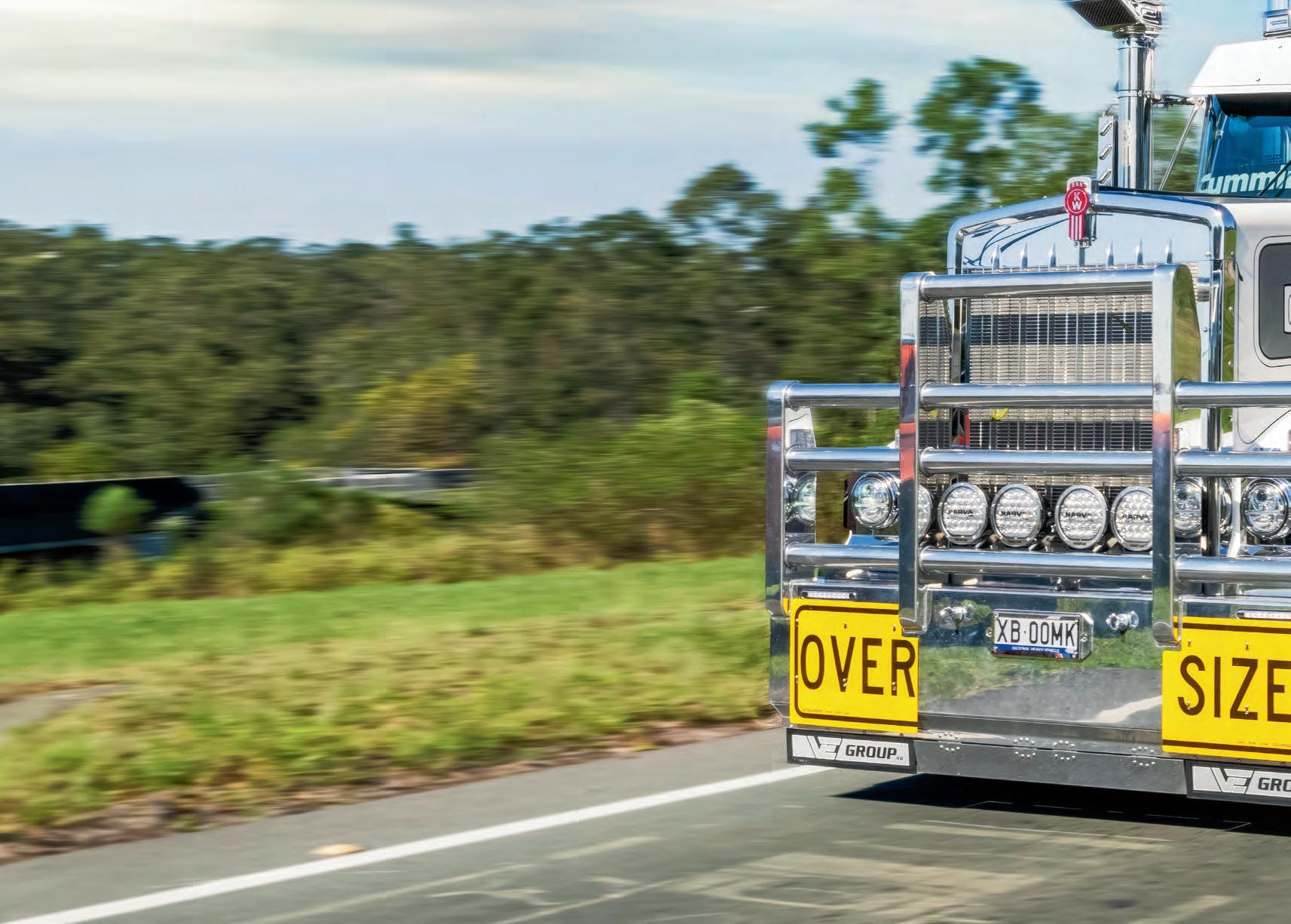




Heads or tails? That’s the 2000-word question today. The reason I am fl ipping a metaphorical, and behind the scenes, literal, coin is because what started out as a single lane story quickly diverged into a two-lane tale. Allow me to explain before I fl ip the coin.



I was recently asked by Rocklea Truck Electrical to track down Nathan Howell from VE Group in order to snap some photos of the Kenworth 100-year anniversary truck – a model that Rocklea Truck Electrical had a hand in creating. Having personally seen one of the American 100-year releases myself, I had several questions. Like what? Ah? Are you serious? And of course, when can I shoot it?
The idea of an Australian 100-year tribute truck instantly triggered my ‘I need to make a





story out of these’ senses. The single lane story I was aiming for would focus on Kenworth’s century long history, the special 2023 releases over in America and exactly how there is an Australian built truck waving the Kenworth 100-year flag.


The second lane of my story manifested itself when I met Nathan Howell and his wonderful wife Bronwen. This humble couple have built one of Australia’s leading earthmoving and civil construction companies, all while holding onto the work ethic and country culture that’s entrenched in their small-town roots. The story was meant to be purely about the truck, but then I met the force behind the machine and suddenly I have two avenues to cover. Do we start with the mechanical or start with the familial? Let’s flip.


prying into the lives of Nathan Howell, his wife Bronwen and the VE Group.

“I grew up around trucks, my dad had a truck and pig trailer with a loader doing local work for the council – their industrial lot was adjacent to the Moura Wheat Board which was also a hype of transport activity,” Nathan says.

Tails it is, and that means we get to start by

“Moura Bulk Grain & General Haulage was owned by my uncle and aunty, Tony and Marlene Seccombe. They lived next to mum and dad’s depot, which, in years to come, became our own Moura depot. Next door to that was Absolon Transport.




“Absolon had a few R-model Macks, and it was big gear back in those days – I was just truck mad. If I wasn’t sitting beside dad in the truck, I was sitting beside my uncle Butch or next door helping uncle Tony or up in Absolon’s yard, I was always doing something truck related.”






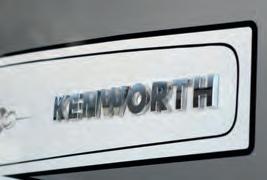

Listening to Nathan recall his childhood in the small Queensland town of Moura brought out the jealous side of me – no internet, no Wi-Fi and probably only three channels on the TV you never used, but an outdoor playground that consisted of trucks, trucks and more trucks. It really was inevitable that decades later Nathan would find himself working under the shadow of a gluttony of gorgeous trucks and life size tonka toys.
“Dad also had yellow gear as well,” Nathan says, referring to the distinct CAT yellow earthmoving gear.
“My passion shifted to include that stuff. Because us kids didn’t have any licenses, we would just use his little digger to mix dirt for Dad or dig sand out, stuff like that so dad could go deliver it.”
Through Nathan’s school years, the distinct lack of earthmoving and transport activities in the government set curriculum meant Nathan’s attention was often focused more on the school bell and getting home to undertake some manual labour. This meant that once Nathan was old enough, he said goodbye to school lunches and hello to a country apprenticeship.
“I went and worked in Absolon’s shed, completing a lot of general maintenance such as re-bearing trailers and doing brake linings the old school way with having to do the rivets manually – we didn’t get to just buy them off the shelf like you can today,” Nathan says.
It wasn’t your standard official apprenticeship that many get. Instead, it was the country apprenticeship that has nourished so many of this country’s greatest bush mechanics.

Seeing as Nathan was still in his late teens when he left school, he had the skills and desire to drive trucks and earthmoving equipment. However, that good old-fashioned issue of ‘not legally old enough’ kept rearing its head. That period of waiting was filled in for Nathan by getting some work on a local farm, then moving into work in a local Moura engineering workshop that would lead to work with an earthmoving outfit where Nathan found himself out west building dams and doing property work, ‘bush ticketed’ of course.
“I never actually thought about having my own business back then,” Nathan says.
“I was wanting to get officially ticketed and get into the coal mines, which I did. I was about 20 when I got a job in the mines and was there operating the big excavators and such. I moved up the chain, supervising people, running a crew. After a few years I remember coming home to Bron one night saying, ‘this isn’t for me, I think I want to start our own business’.”
Bronwen Howell, or Bron as she will be referred to, is Nathan’s wife and mother to the couple’s three children. Nathan and Bron have been a couple and team since they first met way back in high school.
“Behind every successful business is a successful team,” Nathan says, adding in that without Bron, none of what the couple has achieved would’ve been possible. Bron is a story on her own with her amazing charity work on top of the day-to-day VE Group work she takes care of. She also recently picked up the prestigious 2023 Queensland Trucking Association (QTA) Trucking Woman of the Year award.
Hence back in 2006 when Nathan finished his night shift and sat down with his wife to tell her he wanted to start his own business with her. Bron was right there to assist. That business would eventually become VE Group and began with a small little skid steer loader –no truck, no transporter, just the skid steer. With a laugh, Nathan recalls the company’s humble beginnings.
“I had a mate building Cavalier Homes and he couldn’t get anyone to do his pads, so I bought a little skid steer and I’d park it at home,” Nathan says.
“On my days off, and sometimes after night shifts, I’d just order the product from the quarries to site, then drive the little skid steer
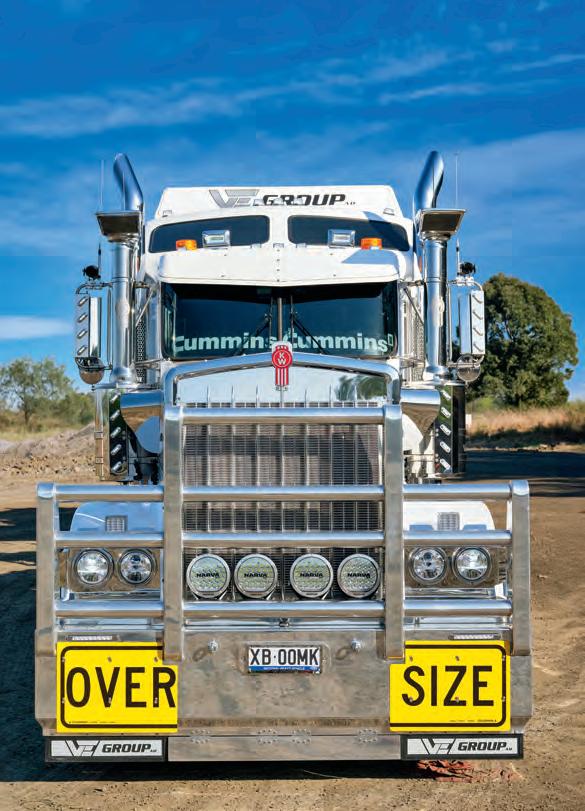
around town to the site, do the job and drive it home. Eventually some plumbers wanted work done, which needed a little digger, so I bought my first truck in an Ex-K&S 4864 Western Star. I took the sleeper off it and bought an old Shephards bin off Croydons in Sarina, had it brought down and fitted at Shephard Transport Equipment in Brisbane.
“I then got a single axle tag trailer to haul the digger around on. As that work picked up, I was finding I’d have reliability issues with getting the product to do the jobs I had, so I bought another truck and dog tipper combo, a full tipping setup. It just kept growing from there.” Now we jump ahead a little to the VE Group story. The trajectory that VE Group took was the picture-perfect representation of ‘hard work pays off’. That first truck became two, then four and, with positive word of mouth growing, the company kept expanding and taking on more and more jobs. The company’s workload shifted from council jobs in small town Moura to large scale projects in the greater Queensland area. Next thing, the VE Group started undertaking more work interstate, with Nathan and Bron
“I was just truck mad. If I wasn’t sitting beside dad in the truck, I was sitting beside my uncle Butch or next door helping uncle Tony or up in Absolon’s yard, I was always doing something truck related.”





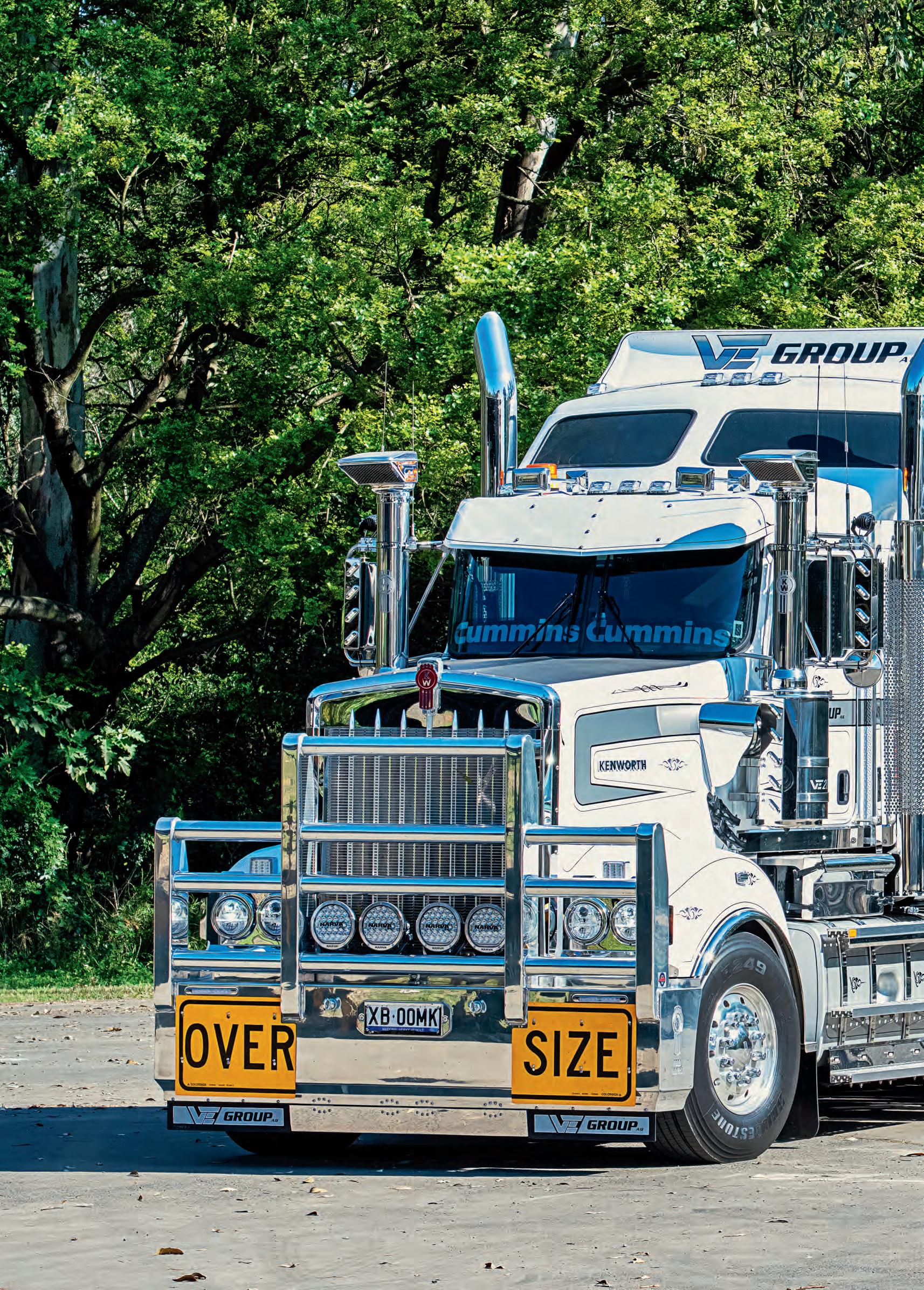


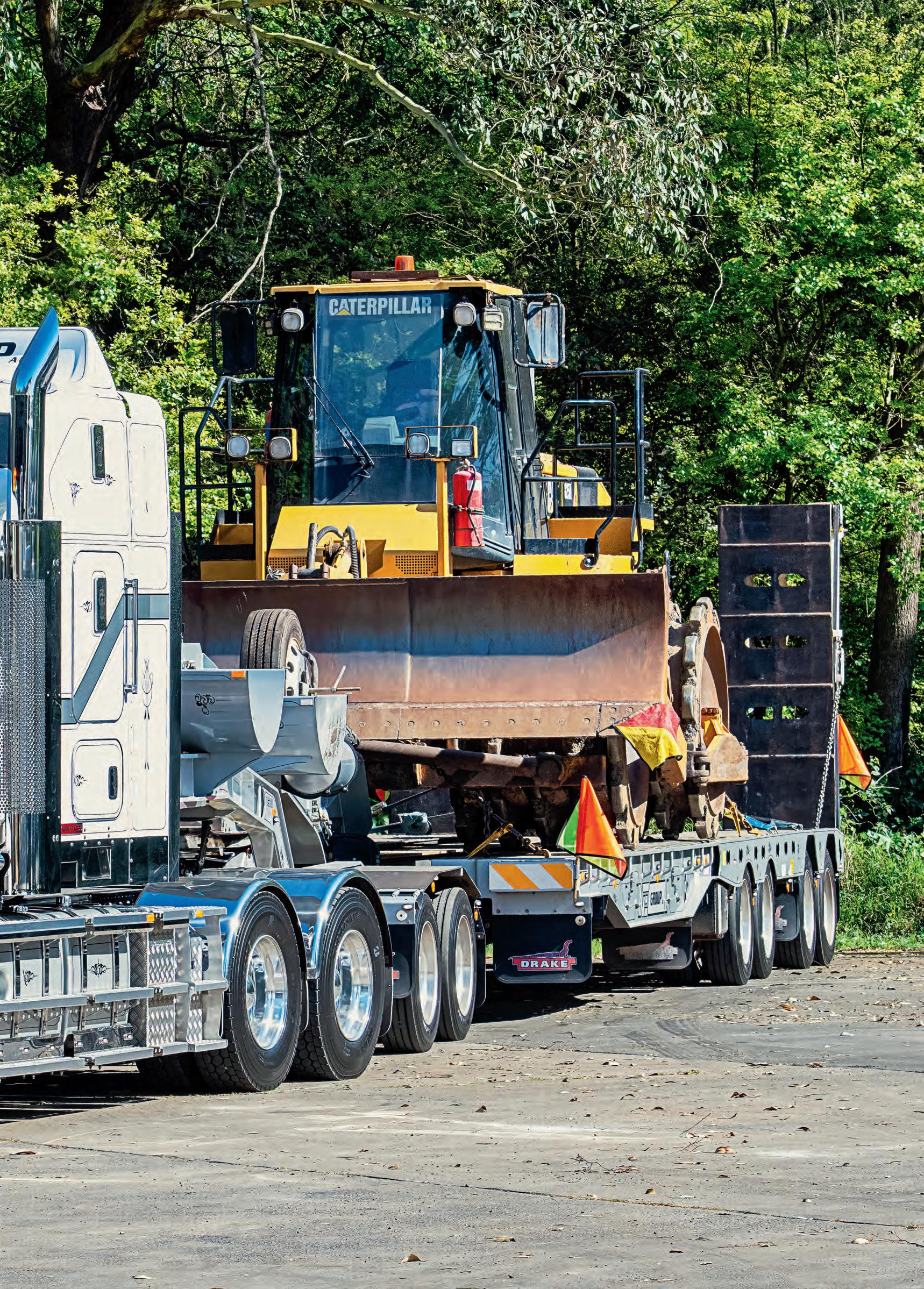
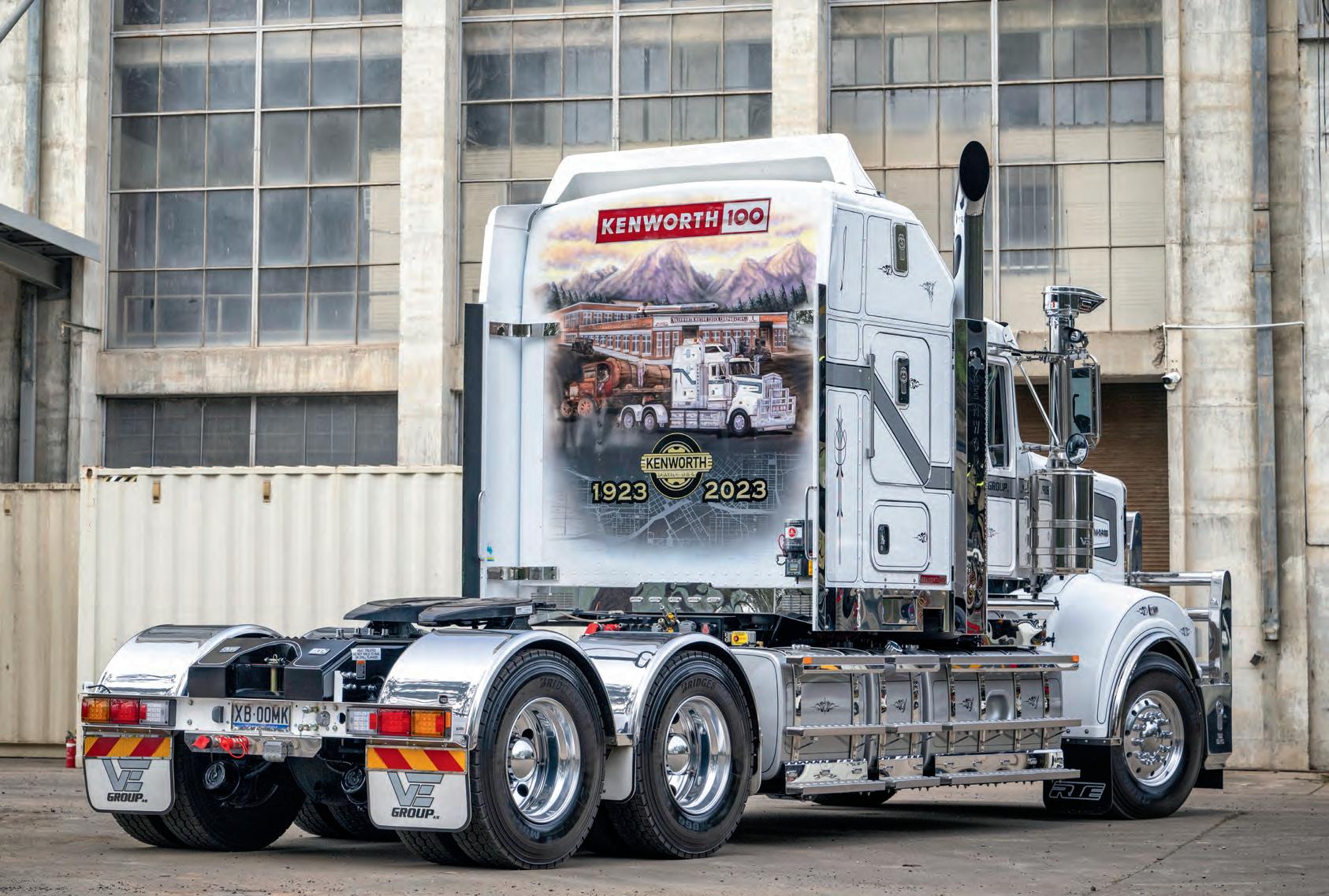

currently setting up a new head office in Brisbane.
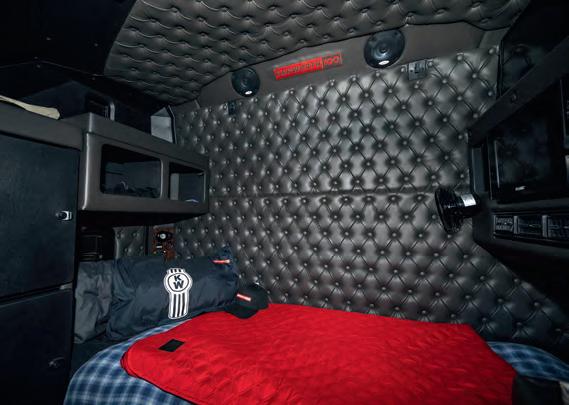
“But we’ve found if you say family culture then people don’t want to call each other out and have some of those hard conversations that need to be had sometimes.”
Having the ability to undertake tough business conversations, and fostering an environment that cultivates and encourages them, means you are held to a higher standard and thus the work you produce is of a higher standard. It is an aspect of life that has paid dividends for the company.
Above, L to R: Another exclusive American addition is the dash mounted badging; Straight out of America, Kenworth Australia managed to also get Nathan the custom bedding set that came with each of the America special releases.
The reason I am not using all my words to track the course that VE Group took to get from a single skid steer to their current collection of around 60 trucks, a similar number of trailers and almost as many pieces of yellow gear is because I want to focus on the couple and the culture at VE Group. It will segue perfectly into the second half of this story where we shine the light on the big 909 on the pages before you.
Spending time with Nathan and Bronwen, the one thing you do pick up is the old-school, small-town values that are the essence of many grassroot companies. It’s not just about hard work, honesty and loyalty, although those three attributes are extremely important, it’s also about building relationships and treating everyone, from suppliers to staff and customers to contractors, with respect.
“We don’t label ourselves a family business, even though we are,” Nathan says.
One particular example of this is the very low staff turnover within the company. It is a very competitive job market out there and, in order to hold onto your staff, you need a culture that people want to be part of, which VE Group prides itself on.
“Our core values are integrity, endurance and relationships,” Nathan says.
“We want to build a culture that people want to be part of. To make something like that, you just have to go that extra mile.”
While practicing those values is important to VE Group, finding reciprocal values in the people VE Group deal with is also vitally important and that is what brings us to the second lane of our two-lane story today in Kenworth.
“My first truck was a Western Star and it did us well. When we started buying more trucks, we tried another manufacturer and we just had such a bad run. It almost sent us broke, to be honest,” Nathan says.


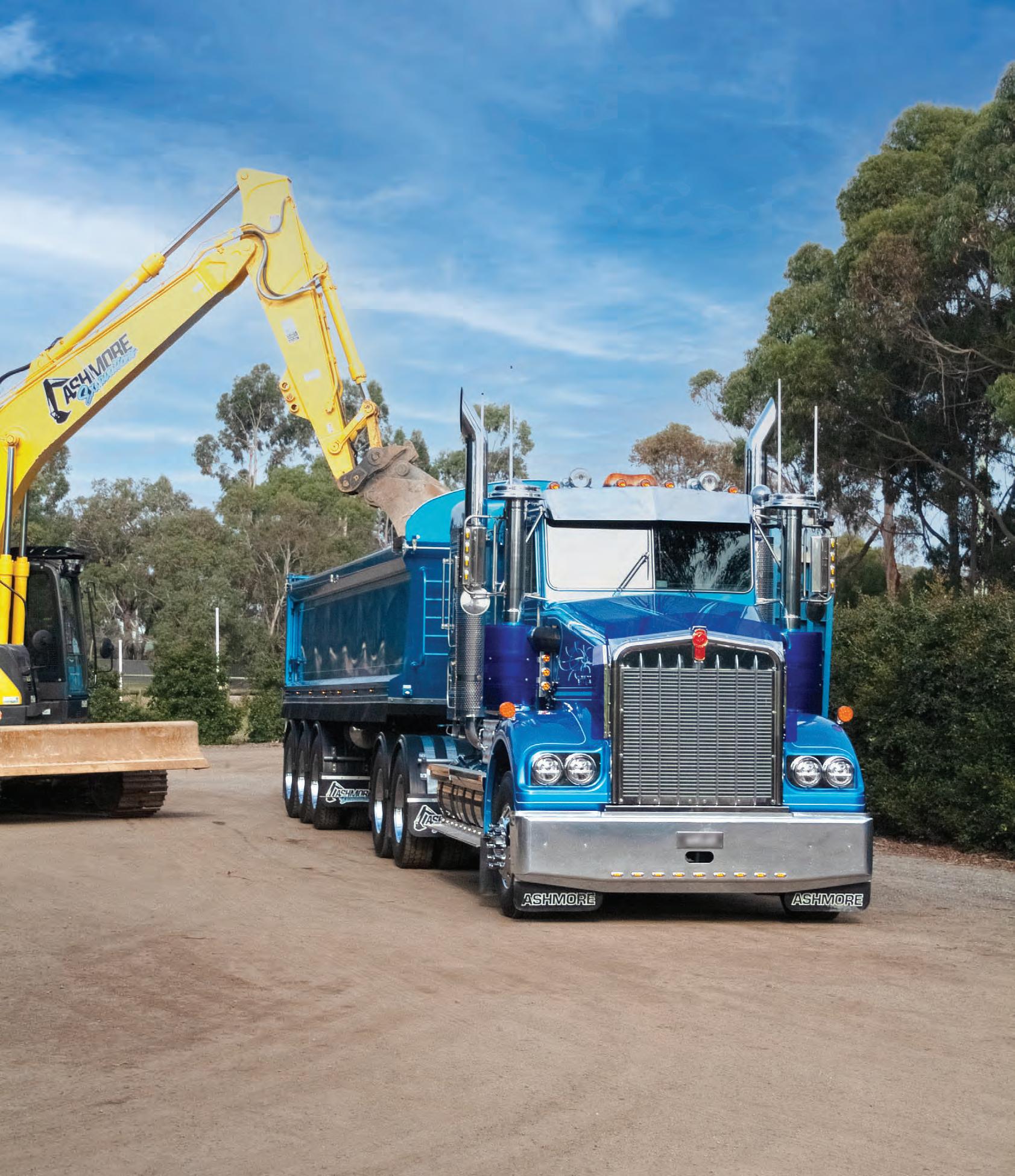

When you choose Ryco, you’re not just buying a part. You’re buying round-the-clock technical support, market-leading innovation, and unparalleled filtration expertise. Ryco’s Commercial Filter Range includes oil, fuel, air, coolant, crankcase, cabin air, AdBlue urea filters, transmission and Service Kits for a large range of popular North American, European and Japanese Trucks. So when your customers need superior protection, be Ryco Ready.








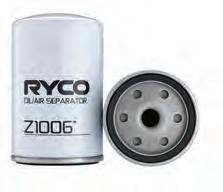


“Then we got onto Kenworth and the product just spoke for itself. The support throughout the Brown and Hurley Network is awesome, the resale value is there and we haven’t had any issues.”
The VE Group truck role call sees the everpopular T610 model as a favourite for the truck and dog tipper combinations. When it comes to the away work and the float work, that’s when Nathan starts rolling out the bigger gear, with several T659s in the fleet and, of course, the favourite child of the Kenworth family in the Aussie-built T909. All of this leads us towards our star pupil for today.
LANE TWO
In 2023, when Nathan first went looking for a new truck to add to his expanding fleet, he chose to add another T909 to the stable. However, this time he wanted to try and do
something a little different. He wanted to shine a light on a brand that has been the backbone of his company for many years by celebrating and acknowledging the 100-year anniversary of Kenworth.
Australia has been a card-carrying Kenworth country since 1960, when George Blomfield and Ed Cameron imported the first Kenworths from the United States. A decade later, the huge Bayswater plant in Victoria was built and, in 1971, the first Australian-built truck, a K125CR, rolled off the production line. That was the origins of Kenworth in Australia, but the American trucking icon had a history nearly 50 years older than our first locally built ‘Grey Ghost’.
Kenworth Motor Company was incorporated in 1923, with the name coming from the two guys that owned the company, Harry Kent and Edgar Worthington. Hence the original Kenworth logo was just a round badge, with Kenworth written through the middle and a K and W above and below to represent the company’s founders. The two men were aiming to build trucks tough enough to help out the local loggers who were struggling to get the felled trees up the slippery winding mountain track.
Since its beginnings, Kenworth has become a household name, both within the transport circus and the general Joe public. In 2023 it celebrated its 100-year anniversary by offering a limited release of 900 commemorative W900L and T680 tractor units. Now 900 may seem far from ‘limited release’, but keep in mind Kenworth sold nearly 40,000 class 8 trucks in 2023, so 900 is very limited in that scale. These
limited editions came with special badging, numbering, interiors and a few other goodies.
‘Why didn’t we get them over here?’ you ask.
‘We’re Kenworth fans, what about us?’. To start with, the T680s would laugh at our width laws, and the W900L would positively crack up at our length laws.
This did not stop Nathan Howell from wanting to get in on the celebrations.
“We decided with the new one that we really wanted to do something different, something to celebrate the Kenworth history and we thought we would reach out and see if we could get the limited edition parts and add them to an Australian truck,” Nathan says.
Nathan applauds the assistance he got from everyone at Kenworth in Australia, beginning with local Brown and Hurley guru Matt Innes, all the way through to the likes of managing director Damian Smethurst, director of sales
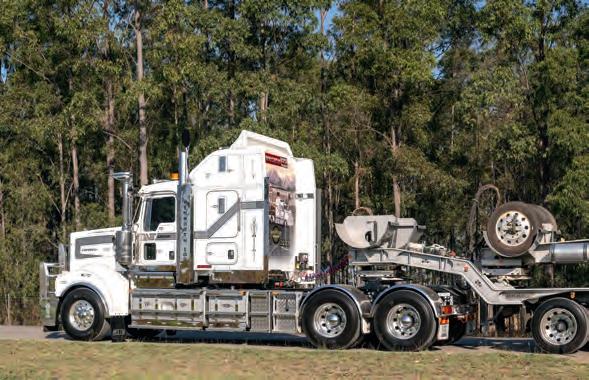
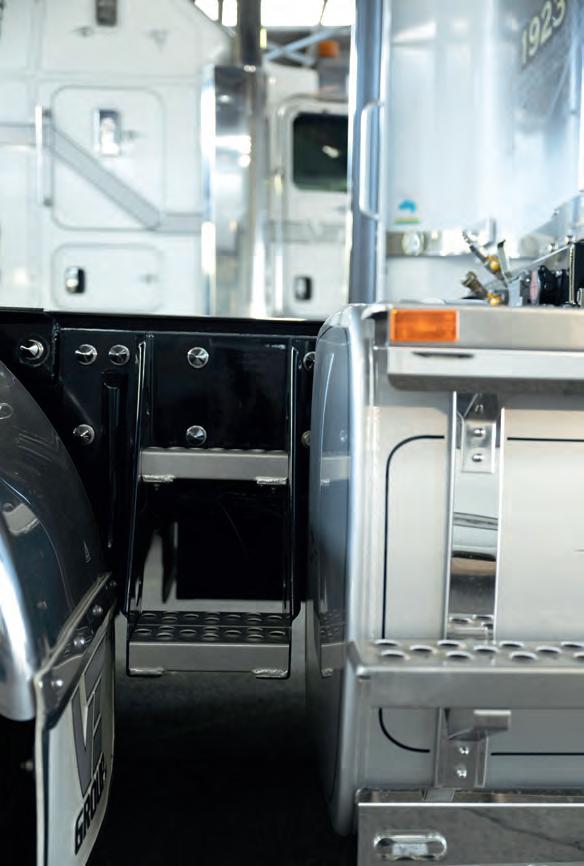
and marketing Michael Long and regional salesman Matt Robertson, as well as many others who helped twist the arms of the big wigs in America who assisted the request and sent over everything they could to help create an Australian 100-year truck.
“They sent us over the badging for the dash and the 100-year badges for the sleeper. There were also the door kickers that looked a bit like 610 door kickers, so we modified those to fit,” Nathan says.
“The bonnet badging is also different, it’s old school individual letters rather than the current one piece set up.”
He also received the 100-year pillows and blankets and got the interior stitching done to the back wall of the sleeper.
The other talking point of the VE Group 100-year Kenworth is the amazing artwork on the back of the sleeper. Courtesy of Cyclone Airbrushing, the mural showcases the North American geography and features the

Above, L to R: Another custom addition to the 100-year T909 is the RTE build steps, making hooking and unhooking a lot easier; Attention to detail is paramount for VE Group, not just in the work they do but also in the finishing of their trucks; Down the passenger side, Nathan requested the RTE team build out the rear box cover and sleeper air cover, all to ensure a flush finish look that works very well.
Below: The American supplied door kickers were designed for the US-only T680 model and required a little bit of modifying to fit our Aussie built T909s.
Bottom: Time for Brad to check heights and await the pilot so he can hit the road.
Opposite middle: The man responsible for piloting the new 100-year Kenworth is Brad, a reluctant model for my camera. However, I did manage to catch him when he was focused on the job rather than me.

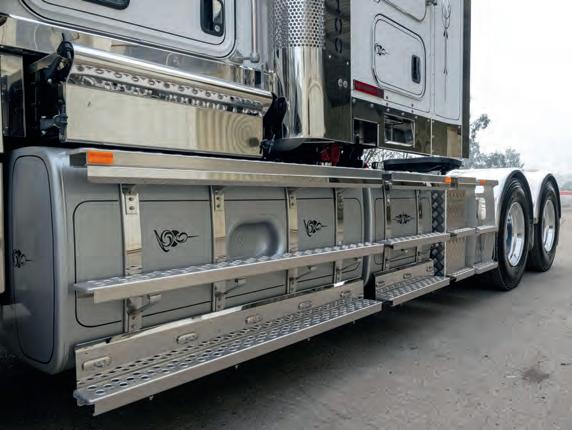
original Seattle factory, as well as the original Harry and Edgar log truck, all of which is overlayed atop the Seattle Street map. For those avid cartographers reading, you may notice the Kenworth logo on the mural lays directly over the Seattle factory’s location. The whole art piece took weeks to complete but was well worth the wait.
Getting a masterpiece like VE Group’s 100-year truck on the road is a team effort and big praises need to go out to all of those involved, from the likes of Sam’s Signs, who did all the lines and scrolls and Mr Bullbars who created a custom engraved 100-year bull bar, to long time VE Group suppliers Shephard Transport Equipment, who supplied and fitted all the hydraulics to the big rig. Nathan also
“We decided with the new one that we really wanted to do something different, something to celebrate the Kenworth history and we thought we would reach out and see if we could get the limited edition parts and add them to an Australian truck.”

gives credit to Brock, Kim and the team at Rocklea Truck Electrical, who were instrumental in putting together this stunning ride. Along with many custom-made fabrications, it was the RTE team that was responsible for so much of this truck, from organising the custom painted tanks and painted drop visor to organising the 100-year embroidery inside the big Kenworth bunk.
I guess it’s about time my two-lane story winds up so you can go and have a closer look at this outstanding truck. I am very thankful I got the invite to capture such a oneof-a-kind tribute truck and am extremely appreciative of the time I had getting to know the power couple behind VE Group. I’m privileged that I have been able to share their story. Now it’s time to let this big beauty go and earn its keep.
In this month’s column the Highway Advocates team look at the pros and cons of a traditional logbook
Do Traditional Logbooks Still Cut the Mustard?
For years, traditional logbooks have been a fixture in the transport industry. Many of us can recall the square logbooks that often went half-filled or not filled in at all. Back then, a $50 fine for a logbook violation felt like a minor inconvenience. Fast-forward to today, and the situation has escalated — with fines reaching up to $20,000 and four demerit points for a single critical breach.
Across Australia (excluding Western Australia and the Northern Territory), courts are seeing a surge in truck drivers facing fatigue-related charges. Yet, the term “fatigue-related” can be somewhat misleading. The prosecution doesn’t need to prove that fatigue was a factor.
Under the Heavy Vehicle National Law (HVNL), a separate charge exists for “Drive whilst fatigued,” which carries a lesser penalty — three demerit points instead of four — but is still highly punitive.
As work diaries and penalties have become more stringent, so too has the legal landscape — both in statute and common law. Several recent court rulings, like Transport for New South Wales v De Paoli Transport Pty Ltd, have raised the bar for compliance, especially for operators and others in the Chain of Responsibility.
Justice Cavanagh’s judgment in the De Paoli case has offered vital takeaways for transport operators:
• Systems: Companies must have systems in place to manage risks, and those systems must work. Proactive compliance monitoring is crucial.
• Training: Drivers must be properly trained to complete work diaries and manage fatigue. But it’s not just about the initial training. Continuous monitoring is necessary to ensure compliance. It’s about making a lasting commitment to compliance.
• Risk: There doesn’t need to be a collision or a fatal accident to be convicted of a primary duty offence under the HVNL.
The HVNL also applies to the Master Code, an industry code of practice that defines the primary duties of all parties in the Chain of Responsibility. It’s important to remember that drivers themselves are not responsible parties under the Chain of Responsibility,
though they are often seen as “lowhanging fruit” when infractions arise.
Imagine a transport company operating 30 B-Doubles on interstate journeys, with drivers sometimes away for weeks at a time. Paid by the kilometre, these drivers are responsible for loading and unloading their own vehicles. The company tracks its fleet using GPS and reviews work diary pages when returned. Drivers primarily operate between Sydney, Melbourne, and Brisbane, often completing a leg per day or night.
Now, imagine one of these drivers is involved in an accident that results in injury or death. The police will seize the driver’s logbook and subpoena GPS data. If discrepancies between the GPS data and the logbook entries are found, the consequences could be severe — potentially even jail time.
In one case handled by Highway Advocates, a regional transport company faced the most severe penalties under the HVNL, including the possibility of multi-milliondollar fines and even imprisonment. Fortunately, in that case, we were able to have the penalties reduced to less than 3 per cent of the maximum.
The charges stemmed from a common scenario in transport companies across Australia, underscoring the importance of robust and proactive compliance systems.
In 2024, the increasing surveillance network is creating additional burdens for transport companies. Notices to Produce are becoming common, demanding companies identify drivers and submit work diaries for inspection. Often, these notices are issued based on allegations that a vehicle has been detected travelling too quickly between Safe-T-Cam sites, suggesting a possible offence.
Safe-T-Cams, however, are not approved or prescribed devices for detecting average speed, and no specific trip times are legislated or published. Yet, these Notices to Produce are regularly used in what can be described as “fishing expeditions.”
This practice highlights the considerable risks transport companies across Australia face — risks that the NHVR and other prosecuting
authorities are magnifying.
The NHVR recently released a report summarising “fatigue/distraction monitoring technologies,” with Continuous Operator Monitoring — Oculomotor Measurements — gaining momentum. These devices, while technologically advanced, remain reactive rather than proactive (search Robert Bell and Seeing Machines online for more thoughts on this technology). The only viable solution for proactively managing compliance is adopting NHVR-approved Electronic Work Diaries (EWDs) and their associated compliance modules. There are 11 approved EWD systems, each offering similar functionalities designed to help operators stay compliant. We are now looking to partner with an EWD developer who will genuinely engage with the transport industry and the “Industry Insider” behind Highway Advocates and HACS.


At Highway Advocates, we’ve been recommending and using EWDs for nearly four years. These systems have played a key role in the consistently favourable legal outcomes we’ve achieved for our clients. Electronic Work Diaries provide the tools needed for real-time compliance monitoring, significantly reducing the risk of critical breaches.
Highway Advocates (Consultancy Service) Pty Ltd (HACS) was born out of necessity, just like Highway Advocates (Australia) Pty Ltd, founded by Robert Bell.
Over time, Highway Advocates has become a legal practice leading the way in heavy vehicle law matters.
“Electronic Work Diaries provide the tools needed for real-time compliance monitoring, significantly reducing the risk of critical breaches.”
While Robert remains integral to Highway Advocates, his focus has shifted toward HACS, where he provides services to the transport industry to help them operate smoothly within the ever-tightening enforcement net.
If you’re looking to fully comply with 2024 regulations in your transport operations, contact Robert to see how HACS and an NHVR-approved EWD can help.
Our solutions are designed to be practical, affordable, and compliant, helping keep your business afloat and your drivers on the road — where they belong.

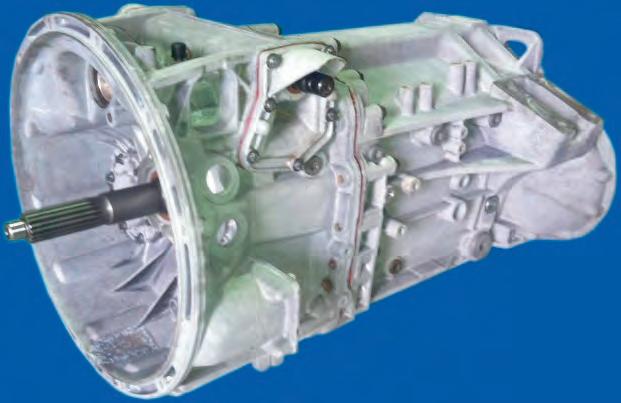
ReconditionedMercedes-BenzTransmissions. MostMakesandModelsG100,G131,GO210, G240,G280,G330available.S3. TA431566. POA
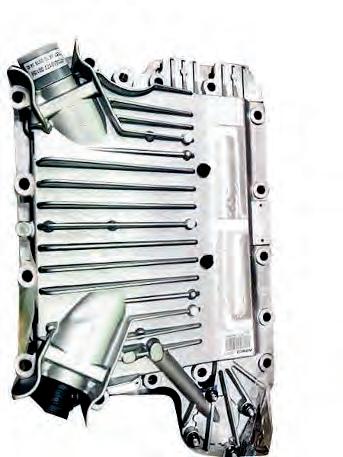
Unit 1/71 Axis Place, Larapinta, Brisbane, QLD, 4110, Australia
Ph: (07) 3276 9300 Fax: (07) 3276 9301
Email: sales@ggd.net.au davids@ggd.net.au
Ph: (07) 3276 9300 Fax: (07) 3276 9301 Email: mattc@gibbsparts.com davids@gibbsparts.com Web: www.gibbsparts.com
Web: www.gibbsparts.com

ZFEcolitepowerpacks.S40. TA952390.
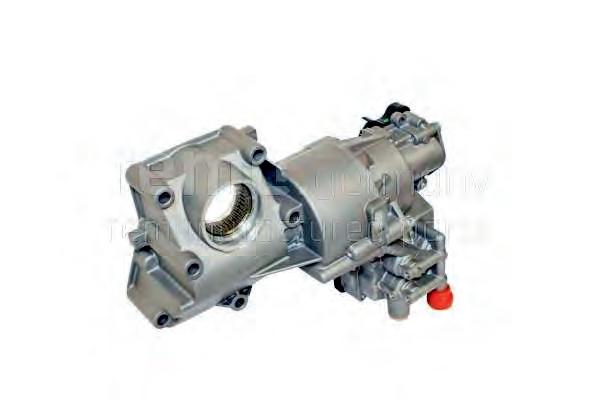

Allmakesandmodelsavailable.S11. TA431615. POA


VOLVO/MACKI-SHIFT/M-DRIVE AT2512C,AT2612D&ATO3112D. S44. TA952399. POA ZFTRANSMISSIONSALLMODELS Allmakesandmodelsavailable.S10. TA431606. POA
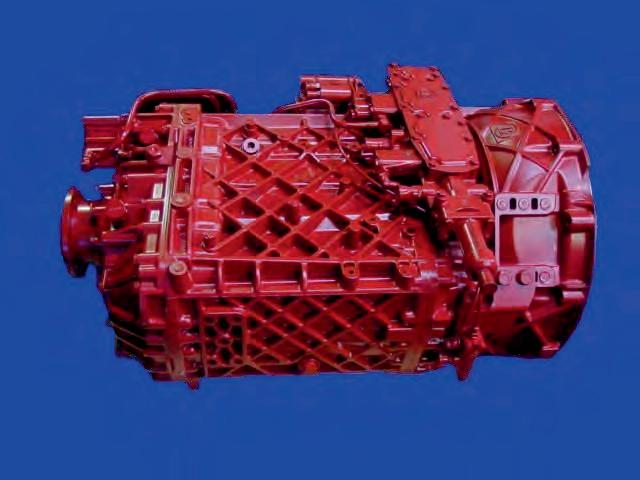
Jade Harney was named NatRoad’s Sam Sali National Young Driver of the Year. She spoke to Daniel Woods about her rise in the transport industry, and what’s next
2024 marked the year NatRoad’s Young Driver of the Year Award was renamed in honour of late industry titan Sam Sali. Such was Sali’s holistic and broad scope of abilities and responsibilities through driving, management and advocacy in the transport industry, it’s fitting this year’s award was presented to Followmont Transport’s Jade Harney.
Harney’s career in the transport sector has been on an upwards trajectory since first joining Followmont as an intern in 2019. Over the past five years she has stretched her abilities and broadened her knowledge to earn a number of highly applicable qualifications that see her loom as a future leader of the industry.
After starting her career as a forklift driver, Harney has since earned her heavy rigid licence and Certificate III qualifications in both Warehouse Operations and Supply Chain Operations (Logistics Operations) and has become a crucial member of one of Australia’s major independent transport companies.
Still just 24 years of age, Harney is already an indispensable member of the Followmont team, whether that be on the road, in the warehouse, in the office or representing the company. A key aspect of the Sam Sali Young Driver of the Year Award is evidence of the recipient performing beyond
expectations, which is a criteria Harney easily fulfils, and then some.
She tells OwnerDriver her passion for her personal development comes through a desire to constantly improve.
“I just love learning,” she says. “After I became pretty good at forklift driving, I thought I’d just try to keep upskilling and have a go at trucks.
“Ever since I got to Followmont I had my eyes on the trucks, and about two years ago I decided to take the leap and give it a go.
“We have a great training team here and they were very helpful in my ambitions to get my truck licence.”
Since getting behind the wheel of her first heavy rigid at Followmont, Harney has maintained a spotless safety record and has recorded zero motor vehicle incidents.
Every day she loads her truck and partakes in daily runs while driving one of Australia’s most iconic vehicles – ‘Pinky’.
Harney’s status as a high-achieving young professional in the industry is made all the more impressive by the fact she is continuing to help pave the way for women in the traditionally predominantly male transport sector. She’s a shining example of the success women can have in the field, and Pinky, being a literal billboard for women in trucking, is the perfect vehicle for her to drive.




“I think the biggest barrier to women coming into this industry is that ‘old days’ view that women aren’t tough enough to be drivers,” she reflects. “The best part about getting in and having a go is being able to prove those old, incorrect stereotypes wrong.
“Just seeing you do the job turns a lot of peoples’ views around. Someone might have that old school view the first time you meet them, but then they see you in action and they’re so impressed it changes their mind.
“I love driving Pinky. It never gets old and it’s actually amazing.
“Every single day I get comments about how great the truck is, and it’s great about how it supports women in transport.
“The colour makes quite a statement, and the biggest thing is when you’re driving down the road you see a lot of kids – especially girls – tell their mum and dad to look at the pink truck.
“Then, when they see it’s a woman driving it, their faces just light up.
“Their faces are what makes it real. It’s great, and it happens every single day, which is just awesome.”
While most praise for Harney’s career development absolutely goes to the driver herself, some needs to be reserved for Followmont Transport’s commitment to upskilling its workforce.
Earlier this year, Followmont Transport CEO Mark Tobin spoke on the transport industry’s struggles to attract – and then retain – high quality young people in the sector.
He said his company was trying to buck that trend by targeting a people-first, high-achieving culture that allowed employees to explore a range of new skill

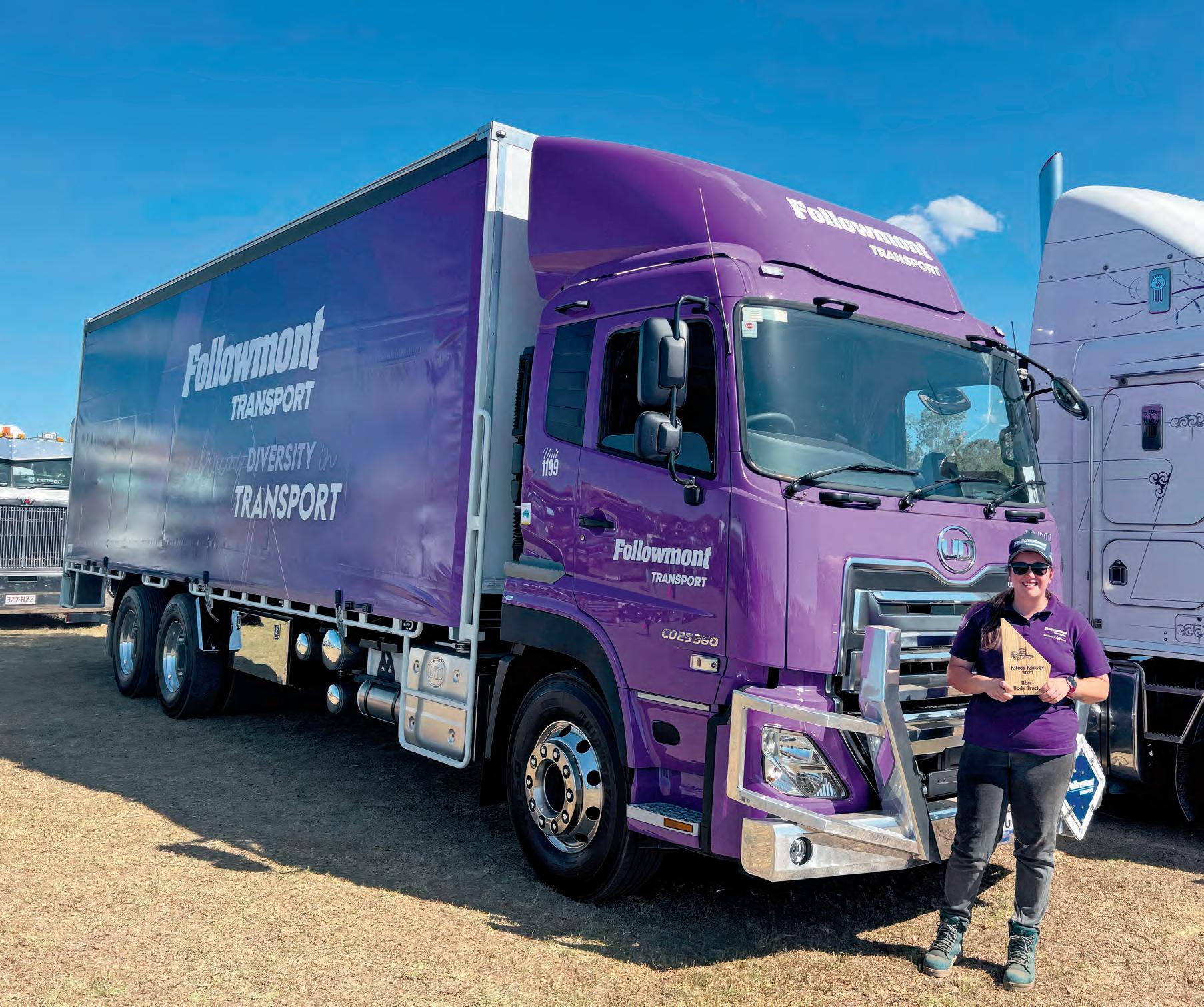
acquisition projects and courses to help them not only stay and thrive at Followmont, but within the sector.
Harney was glowing in her praise about her employer’s approach to its staff.
“There’s nothing better than having a whole company standing behind you,” she says.
“Here, you just have to ask for it. The more I’ve wanted to learn and the more I’ve wanted to do, Followmont has just stood behind me every step of the way.
“If you want to drive trucks, they’ll help you get into truck driving. If something comes up in your life and you can’t drive anymore, they’ll do their best to get you into forklift driving or administrative role.
“They have a job for everyone, you just have to work with them on what’s best.”
With all her experiences across various administrative, warehousing, driving and advocacy projects, Harney is not content to sit still in what she’s doing. She wants to continue to forge her career ahead of her.
She’s represented herself, her company and her industry with aplomb at a variety of truck shows and convoys and in a variety of media landscapes.
Now, she’s looking ahead to potentially driving some of Australia’s most challenging and iconic heavy vehicles.
“I’d love to go up to a multicombination licence,” she beams.
“Then, once I get confident in that, I might have a look at driving road trains.
“I think it’s amazing what those guys do out there, and I’d love to be part of something like that.”
One thing is for sure. If the transport industry was awash with more young people like Jade Harney, it would be in an exponentially better position for it – but that’s what makes her contributions to the sector at such a young age all the more impressive.
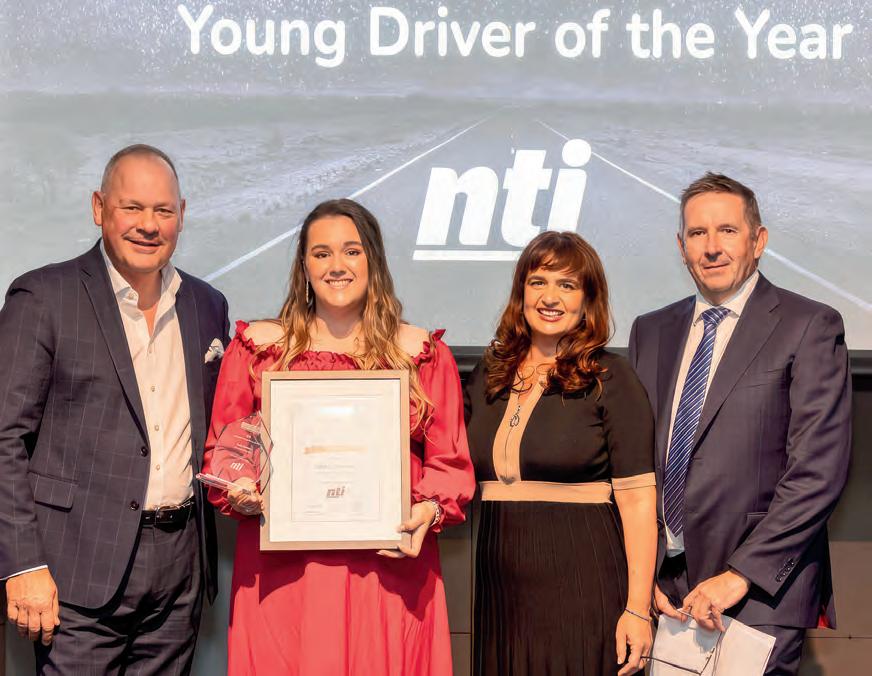

Narva has unveiled more than 790 new products and a revised layout in its latest bumper catalogue
The latest edition of the ever-popular Narva product catalogue is out, and it’s larger than ever, showcasing 790 new lighting and electrical products with 470 never before released products.
Designed for the trade, the 19th edition of the catalogue features more information than ever and introduces a curated new format, implemented following extensive industry consultation.
The included new releases cover almost every product category, with extra attention paid to key categories including Driving Lights, Work Lamps, Warning Lights and LED Truck and Trailer Lighting.
A notable inclusion in the catalogue is Narva’s new Ultima MK3 LED driving light and light bar ranges, which now pack even more power and can be linked


to the clever Connect+ Controller, allowing owners to connect their Ultima lights and adjust performance parameters to best suit driving conditions and environment. Also featuring prominently is the EX2 LED driving lights and light bars, which combine outstanding model choice and overall lighting performance with wide colour customisation options for owners thanks to interchangeable trims.
Work and warning lamps
The latest catalogue debuts the new Microlux Work Lamp range; they’re models that blend superior output and compact beam patterns in a package not previously available in Australasian markets.
There are also more warning lamps with four new strobe ranges introduced, including the brand new Eurotech II and the market changing Optimax Beacons. All have been designed, engineered and tested by Narva to suit the unique ANZ market. The lights (including rotating patterns) meet SAE Class 1 requirements, a performance measure that’s unique to Narva. Also making a debut in the catalogue are two all-new light box ranges.
Additionally, the continued development of Self Contained/Perimeter Warning Lights also introduces new options in this category. The latest offering showcases Narva’s new smoked lens variants and
“THERE ARE NOW ALSO MORE LINE DRAWINGS INCLUDED AND THEY’RE MORE DETAILED THAN PREVIOUSLY, WHERE APPLICABLE THEY INCLUDE INFORMATION COVERING DISTANCE BETWEEN BOLT HOLES (CENTRE TO CENTRE) AND PCD (PITCH CIRCLE DIAMETER) FOR ROUND PRODUCTS.”
versatile flexible warning lights with all silicone optics for increased durability and snug fitment over vehicle contours. And finally, within this category, the Utility/Mine Bar range has been updated to include new beacons, strobes and light boxes as well as an ADR approved combination front position and forward-facing indicator as a standard.
Another major highlight is Narva’s growing range of LED Truck and Trailer Lighting, with nine new models added, providing lighting solutions for everything from box and boat trailers to cattle trucks and road train trailers. Standouts include the new 80 Series which is designed for the toughest commercial applications, and the stylish 70 Series with signature taillight function and first to market combination stop/reflector. Categories such as globes, fuses, trade grade terminals, switches, RV and interior lighting and marine lighting have all grown in the latest catalogue as well.
Industry consultation has shaped the format and layout of the latest Narva catalogue, making it more functional and easier to use than ever — the latest edition is the ideal quick reference, countertop guide.
The new Narva catalogue introduces revised image placement to the leading edge of the left-hand page, letting users more easily see the images on both sides of the page when flicking through, making products easier to find. New graphic icons have been introduced as well, allowing more information to be communicated in fewer words.
There are now also more line drawings included and they’re more detailed than previously, where applicable they include information covering distance between bolt holes (centre to centre) and PCD (pitch circle diameter) for round products. This means installers can be sure their chosen product will fit within the required space.
The number of QR codes in the new catalogue has grown as well, allowing trade professionals to quickly access product videos, application guides, tech tips and more. In the case of the new LED Truck and Trailer lighting range, QR codes link to surface CAD.
The catalogue also features three additional application guides covering Work Lamp, Emergency Lighting and LED Truck and Trailer Lighting — all are easily identifiable by their colour coded tables.
For more information visit the Narva website at www.narva.com.au or find them on Facebook at www.facebook.com/narvaaustralia
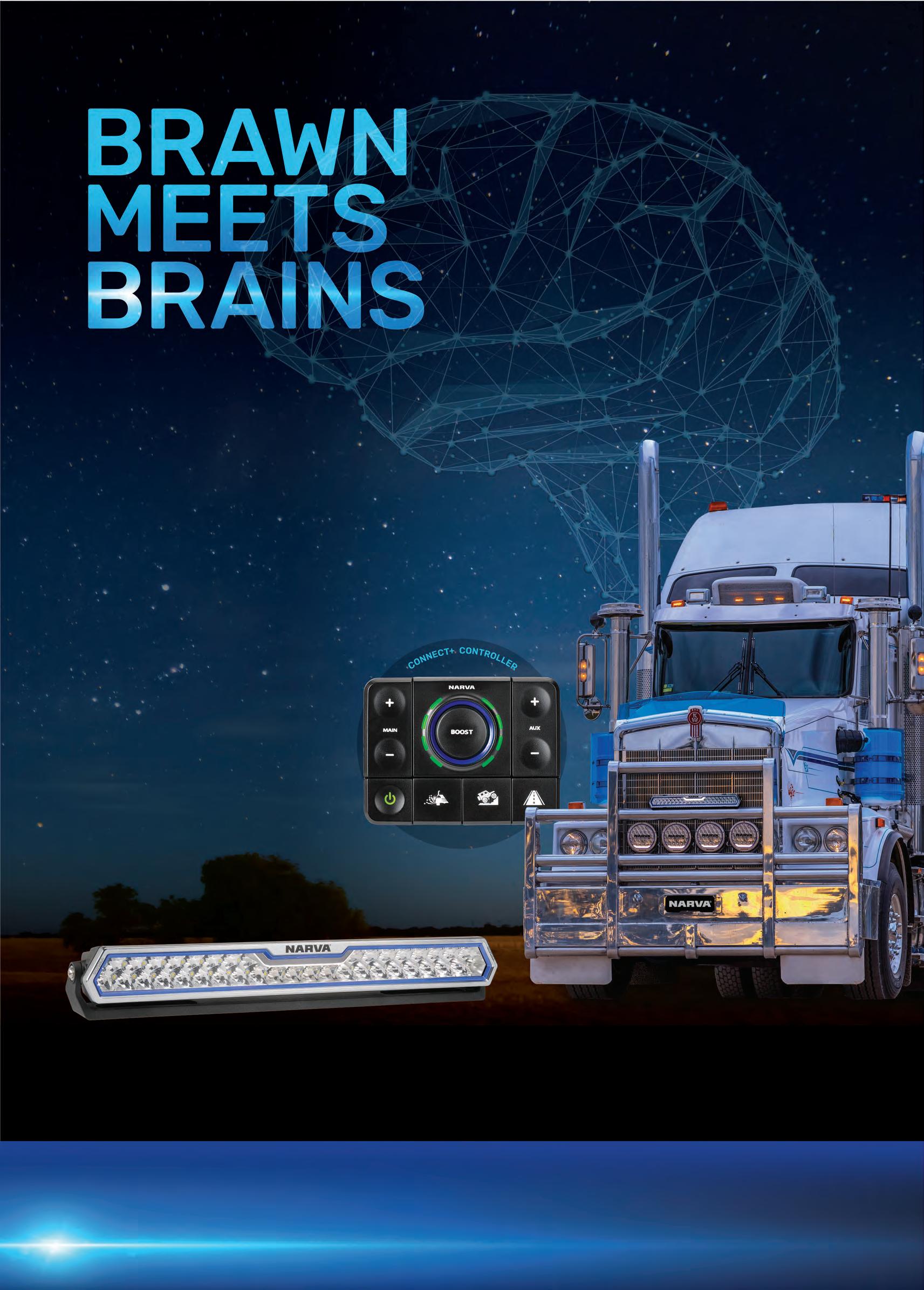
Superior construction and performance; now with intelligent control.
Unlock your Ultima light bar’s full potential with a revolutionary new Ultima Connect+ Controller.*
Featuring 3 customisable driving modes, boost mode and the ability to connect multiple lights, Connect+ gives you total beam control.
Ultima High Performance Light Bars are the first in Narva’s innovative Ultima Connect+ range.
BRAWN: Ultima Light Bars
• Market-leading beam performance
• 2 beam pattern options available
• Unprecedented 10-year warranty
BRAINS: Connect+ Controller
• Adjustable brightness
• Boost mode – 15% more power for 30 seconds
• Single unit to control all Connect+ enabled products
*Sold separately


















Goodaye all, Transport for NSW is going to mark 14 additional green reflector bays around NSW. These will be ones that do not need any work to meet the current guidelines. Then they have said they will look at further expanding the network of green reflector bays with those needing small improvements to meet the guidelines for marking. I have been given a list of the first 14 and the chance to comment and I welcome their efforts and look forward to further expansion to give drivers more options.
They have also provided me with some new posters to put up in truck stops and I will be getting them out there for those who may not know about this simple cheap and effective road safety initiative. I just received a Facebook friend request from a driver who made specific comment that the green reflector bays have helped him in the past, whether it be for a kip over the wheel to get to the next formal bay, or simply for a leak. They still work in the daytime and for any reason when you simply need somewhere safe to pull up. I could have used one last night after hitting a roo, but had to use the best bit of shoulder I could find with decent sight distance, to check all was well. Only lost a spotlight cover lens luckily.
I was travelling from Bourke through Cobar towards Melbourne and there were a few more sites that could be marked. I will be chasing them again to suggest more sites for marking. I did stop at Mt Hope and went into the pub for a coffee. I ended up having a good chat with the few patrons there, one a truckie. I gave them a copy of Owner Driver and a green reflector poster and they all shook my hand and thanked me for the chat.
The publican did say that the toilets there are open 24 hours a day for truckies and travellers and that any truckies who stop in there for a meal have their order put at the front of the order list. They will cook all day and you can ring ahead to have your meal ready — so if you are through that way, give them a try.
Last month I did also get to attend the road safety roundtable in Canberra convened by Senator Glen Sterle. There were 38 attendees from a wide range across the industry and in the end, agreement was reached to set up a small group to work on the immediate issues to take to government, then get
back to the wider group before going to the government.
It did really become a transport industry action meeting and to those who have complained that we are still working on the same issues from 20 years ago, if you are clever enough to be able to get seven governments and territories to agree and then action things we need done, please do so now, as many have tried and failed so far. It is not from a lack of trying, it is simply bloody hard to get those who make the decisions, to care about us on the road at all it seems.
Should we be deemed and seen as an essential service? That would certainly help put weight behind the needs and requests we have been putting forward for all those years. Yes, we were essential when everyone ran out of toilet paper during Covid, but how short are people’s memories?
The Prime Minister did drop in and gave a short speech about the importance of the road transport industry, now we need to follow through and get real change achieved. We must keep pressure on all levels,

ROD HANNIFEY, a transport safety advocate, has been involved in raising the profile of the industry, conducting highway truck audits, the Blue Reflector Trial for informal parking bays on the Newell, the ‘Truckies on Road Code’, the national 1800 number for road repairs proposal, and the Better Roadside Rest Areas Group. Rod is the current president of the NRFA. Contact Rod on 0428 120 560, e-mail rod.hannifey@bigpond. com or visit www.truckright.com.au
sides and those responsible, to ensure the current HVNL reform does actually achieve change. If it does not, the money time and effort will have been wasted and that cannot be accepted. We need better training and licensing and education about sharing the road with trucks.
We need programs to ensure those who come into the industry don’t just get a license. But the, of course, most companies want applicants to have two years or more experience. How do you get that without someone giving you a go and then not just letting you loose on the road, but making sure you have the skills you need to do the job safely, professionally and well.
If you do get a start and then, in your first week, get a fine for not marking a box or going five minutes too far to access some facilities, which actually seem to be shrinking rather than growing or improving, then we will lose those new drivers and they will never come back, complaining we did not tell them the truth of the job on the road.
While I have you, I want to thank and recognise the contribution Ken Wilkie has made to the industry. The first edition of Owner Driver had Ken’s input and I don’t think he has missed one since. That’s over 30 years of making the effort to have a say, to take the time to try and see change and improvement for those involved, while all the time working fulltime on the road. Ken is currently battling illhealth and I wish him and his family all the best and thank him personally for his support, having been a mentor, a confidant and for providing his K104 to me for two years to get the TIV concept up and running. Thanks, Ken, for all your efforts, Rod.
“Should we be deemed and seen as an essential service? That would certainly help put weight behind the needs and requests we have been putting forward for all those years.”

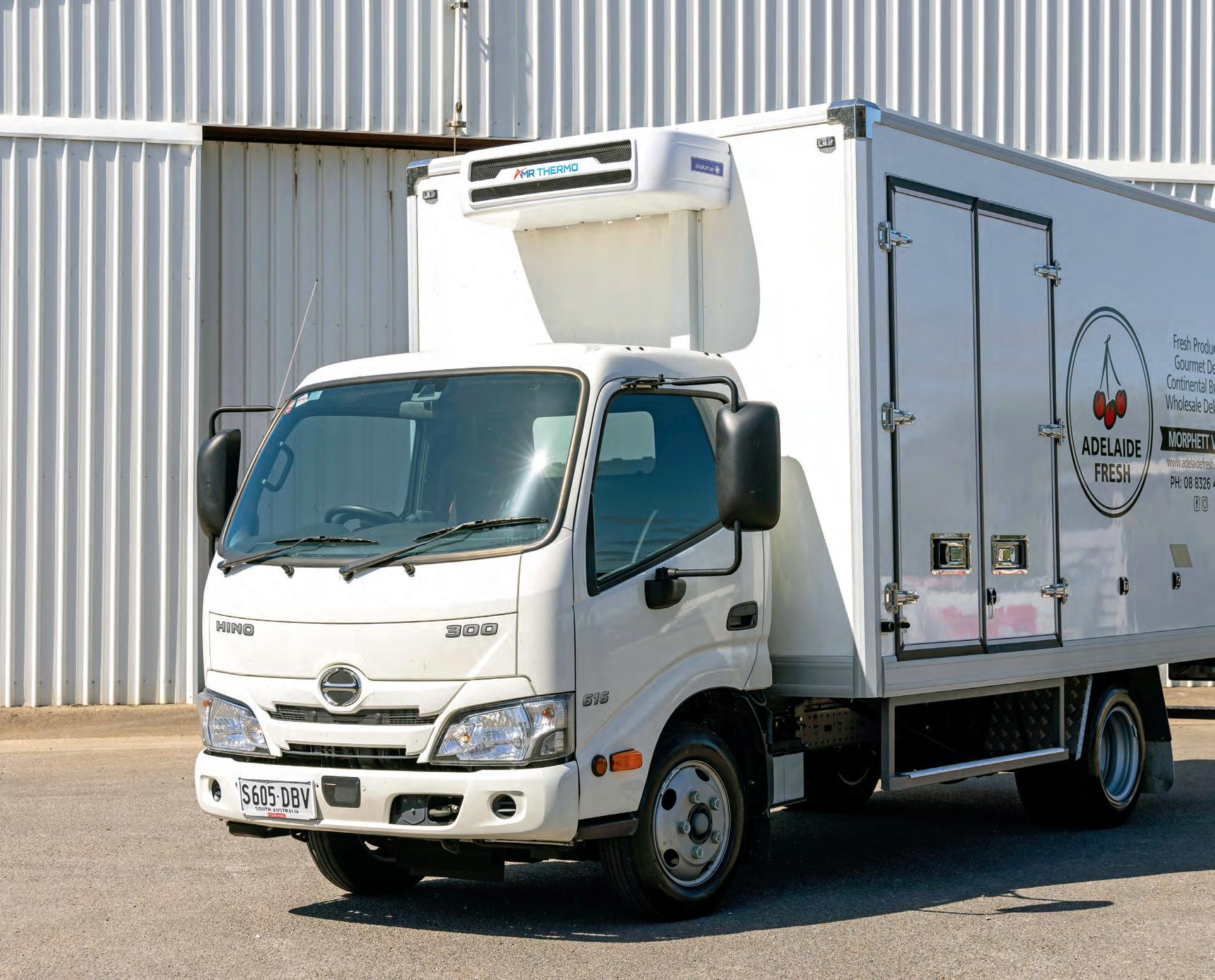
Delivering high quality fruit and vegetables is about more than just having the best produce, it’s also about the service and reliability that the people and trucks behind the operation can provide
South Australian retailer Adelaide Fresh Fruiterers prides itself on its exceptional service quality, both in store and through its deliveries.
A family-run wholesale food, fruit and vegetable business, its origin stretches back nearly 50 years to a small fruit shop in the suburbs of Adelaide.
For the past 18 years Adelaide Fresh Fruiterers has been based out of Morphett Vale, where it remains in the family, under the watchful eye of Dino Labbozzetta.
“My dad and uncle started off with a store in Norwood nearly 50 years ago, and it has just evolved and changed locations since then,” Dino says.
“I was a partner with them, and then bought it out seven years ago. They still help out.”
Adelaide Fresh Fruiterers is a business that has somewhat legendary status in the fruit and vegetable retail space, having been named Australia’s favourite fruit and vege shop by winning the National Retailer of the Year title in the “A better choice” Awards for 2024, 2022 and
2021 and coming runner up in 2023.
More than 30,000 shoppers nominated more than 370 stores for the 2024 Award, with Adelaide Fresh Fruiterers taking out the top gong for having “consistently demonstrated excellence and community spirit”.
Since taking over from his father and uncle, Dino has overseen a refresh of Adelaide Fresh’s small but mighty truck fleet, which it uses for deliveries to its customers’ doorsteps.
Moving away from vans towards trucks for their deliveries, Adelaide Fresh now boasts a fleet of four Hino 300 Series trucks with Pantech bodies. This includes a recently delivered threepallet model, which has already been put to work.
“They’re all refrigerated — a couple are carlicenced, and the others are medium rigid truck licenced,” Dino says. “Our driver team have preferred the trucks over vans. They’re much happier driving the Hino trucks over what we used to have.
“They’re all unique, different sizes. Some have tailgates, some don’t. Some have twin side doors while others have rear doors.”
Dino says the transition to the Hino 300 Series trucks and a range of custom body types had increased the productivity and flexibility of the fleet, particularly with the ability to easily stack and transport pallets and boxes.
“It’s been a pretty easy transition,” Dino says. “The trucks are easier to load, as far as the square bodies go. You don’t have to worry about


“OUR DRIVER TEAM HAVE PREFERRED THE TRUCKS OVER VANS. THEY’RE MUCH HAPPIER DRIVING THE HINO TRUCKS OVER WHAT WE USED TO HAVE.”
wheel arches, and you can throw a pallet in the back. They’re a bit more versatile.”
The Hino 300 Series refrigerated truck bodies were built locally by Alaskan Air and range in size to include 2, 3, 4 and 6 pallet capacity.
Dino and the Adelaide Fresh team have worked with CMI Hino Adelaide for all their servicing needs for the past five years, and Dino says it makes scheduling a breeze.
“Maintaining the trucks is very easy,” he says. “CMI Hino Adelaide has a depot at Lonsdale, which is only a few kilometres from us, which makes it convenient to get to.
“The Hinos are all automatic, so they’re a lot easier to deal with. They go longer, last longer and have less problems.”
Keeping Adelaide Fresh
A day in the life at Adelaide Fresh is one that starts bright and early in the morning.
Dino and the team get out to the local markets to buy

all their produce fresh and local, helping to support the Adelaide community and give their customers the best products possible.
“We go to the market, pick out the fruit and veg and bring it to the shop,” he explains.
“Once we get back, we have a team that delivers wholesale orders in our Hinos to restaurants and cafes.
“We’ve also got a team of people that fill the shop up for our retail customers.”
It may sound simple on the surface, but the team works diligently to ensure that the quality is always there for their customers.
The refrigerated bodies on the Hino 300 Series ensure that produce stays fresh when it is on the journey from the markets to the shop, and then from the shop out to businesses and houses.
While a lot has changed since Dino took over, he says the reliability of their service to customers has never faltered.
“The business has changed a fair bit. We’ve expanded the shop outwards, and we’ve got a warehouse out the back,” he says.
“For the delivery side, we’ve only gotten busier. We can only continue to get busier as well. We’re servicing a unique area in the south of Adelaide.
“Retail has had its challenges, but on the upside, it’s only been growth since getting through those challenges.
“Service and quality has been key to it. It’s what makes customers keep coming back. They want to feel important. They recognise service.
“It sounds simple, but retail can be quite simple. If you’ve got a product that people want and you offer trusted, comfortable service, it can take you a long way.”
As for the Awards, Dino says they offer great feedback for the team, and inspiration that they are on the right path.
“We’re very proud of our awards,” Dino says.
“They were people’s choice, so the customers vote for it. It was about 400 shops involved, so we were very proud to win.”
In
the rugged and breathtaking terrain of Tasmania’s snow-capped Great Lakes, a European giant is rolling in
Second generation Tasmanian logger, Brendan ‘Jock’ Rowe is smitten.
Having spent his life working with trucks and logs in the Tasmanian wilderness he has recently upgraded to Scania’s latest R 770 V8, and has plenty of good things to say about the change.
“The Scania R 770 V8 is not just a truck — it’s a game-changer,” Jock says.
Jock’s success story is not a solo act. He worked closely with Scania’s Tasmanian dealership, C & I Transport Repairs’ owner Leigh Curran, and Scania Account Manager Neil Wesley to ensure the specifications of his R 770 were well suited to the gruelling challenges of Tasmanian log haulage and would deliver new efficiencies to increase profitability.
“Leigh and Neil were fastidious when it came to setting this truck up, particularly because it is the first Scania to enter Tasmanian logging in more than a decade,” Jock says.
“Their efforts and meticulous attention to detail are paying off because what’s initially impressed me is the exceptional fuel economy,” Jock says. “We’re getting 2.9 km/l (34.48-L/100 km), and it can only improve as the truck loosens up.”
The tenacious power output and the downhill retarding capability of the Scania R 770 have cut trip times by more than an hour compared to Jock’s older trucks.
“On a good day, the best fuel economy I could get out of my older trucks was 1.9 km/l (52.63L/100 km), and they’d take 40 to 50 minutes longer to descend the mountain than the new Scania,” Jock explains.
“The fuel savings I’m getting more than cover the monthly truck payment,” he adds. “Equally impressive is the 3-year / 800,000 km extended warranty and the half-a-million km service package that Scania provides.”

The DC16 770 V8 integrates advanced engine management systems that optimise performance and economy. Features like precise fuel injection and turbocharging ensure the engine runs smoothly and efficiently, providing the necessary power when needed while maintaining control over fuel consumption.
The combination of high horsepower and torque means that the engine can handle the high-speed requirements of highway driving

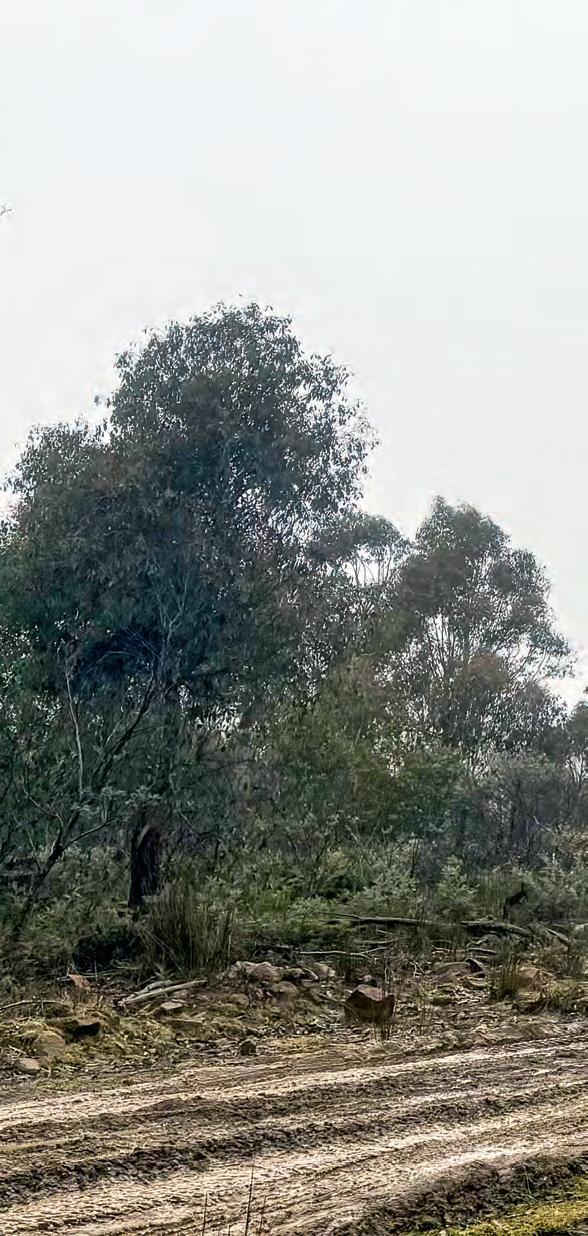
and the low-speed, high-power and torque demands of off-road logging.
Jock has nothing but praise for high torque delivered at lower rpm, as it allows the vehicle to start smoothly and move heavy loads with ease.
“I like the low revving high torque performance of the 770 hp V8. It reminds me of my old V8 Superliner. The Scania motor likes working in the 1000-1400 rpm range; that’s the sweet spot. Anything over that, and you’re wasting fuel and time,” Jock explains.
“This is particularly beneficial for my logging job where I must navigate rough, uneven, and sometimes, like today, muddy and slippery conditions.”
The Scania GRSO926R Opticruise transmission features a more efficient gearshifting system that enhances fuel economy and provides smoother transitions, which are crucial for maintaining momentum on challenging terrain often encountered in logging.
Additionally, the Opticruise system includes automated clutch control and intelligent driving modes that adapt to varying conditions, improving overall vehicle performance and driver comfort. These features collectively lead to increased productivity, reduced wear and tear on the vehicle, and lower operational costs in logging applications.
The safety provided by the braking power of the Scania R4100D retarder is another highlight for Jock.
“If you want to know how well a truck performs, then take it on a test run up here,” Jock says with a smile that suggests he’s done this before.
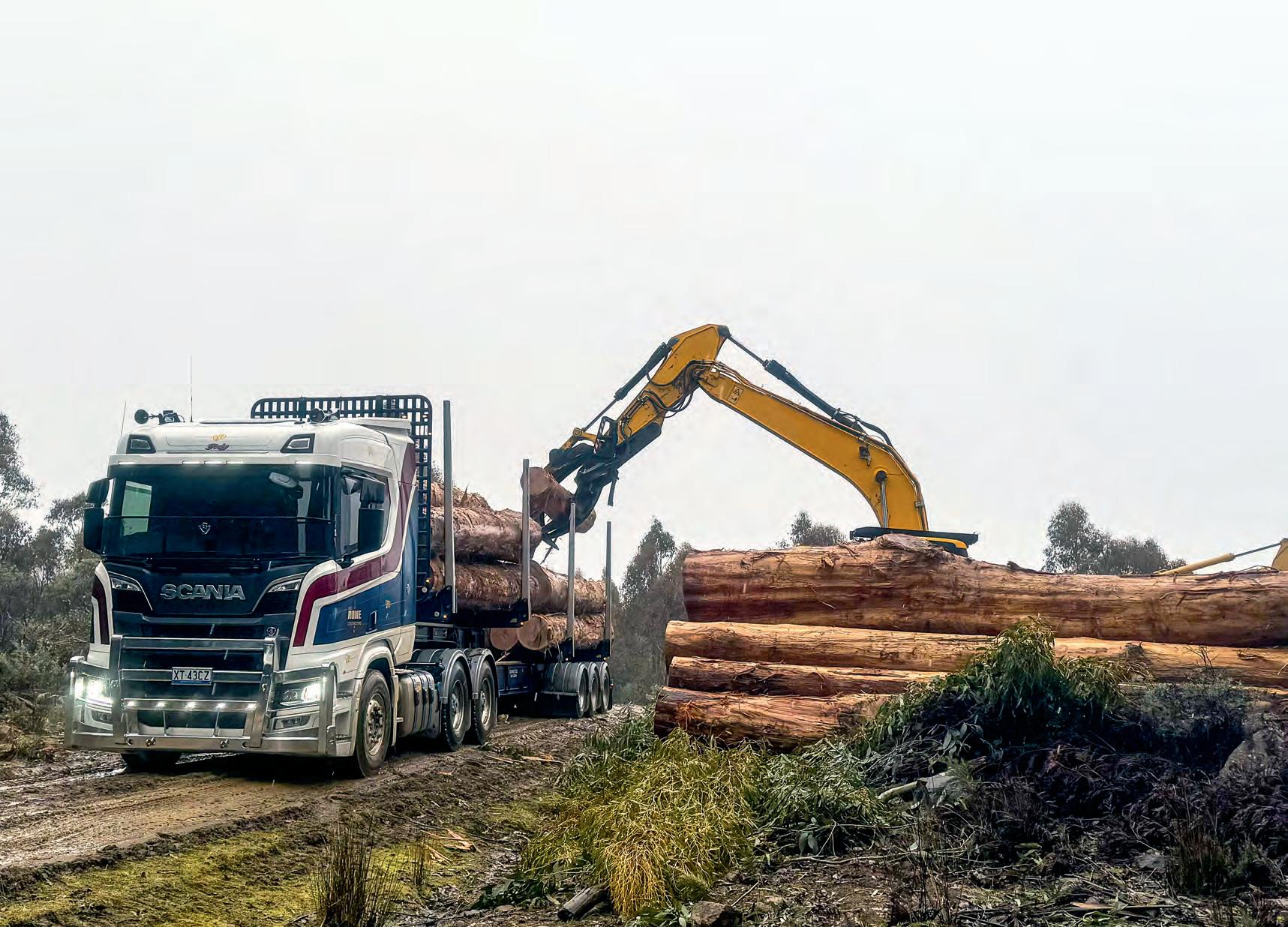
“THEIR EFFORTS AND METICULOUS ATTENTION TO DETAIL ARE PAYING OFF BECAUSE WHAT’S INITIALLY IMPRESSED ME IS THE EXCEPTIONAL FUEL ECONOMY.”
“In my other trucks, when you’re coming down the mountain, with the engine brake crackling, they struggle to hold the truck, even in lower gears, and we’re constantly forced to stand on the brake pedal to prevent engine overruns. Furthermore, the road speed is much slower than the new Scania; sometimes, it can take 40 minutes longer to come down the mountain.”
The Scania R4100D retarder enhances safety by providing consistent and controlled braking power by utilising an auxiliary braking system that operates on hydraulic principles. It is integrated into the vehicle’s transmission and functions by converting kinetic energy into heat, dissipating it through the truck’s cooling system. This process reduces the reliance on service brakes during prolonged or intense braking scenarios, such as descending steep inclines. By alleviating the load on the service brakes, the retarder extends the service brake lifespan and reduces the frequency of maintenance and replacement, which cuts down on maintenance costs and minimises vehicle downtime, thereby improving overall operational efficiency.
Scania’s Neil Wesley says Jock had some very firm operating parameters when shopping for his new truck.
“He was adamant the new truck delivers high

productivity in terms of trip times, but critically tare weight, reliability, durability, safety, and groundclearance were important factors,” Neil says.
“The way the logging industry is structured here in Tasmania, you must keep your trucks on the road as long as possible, hauling as much as possible from the forest.
“We have a unique logging specification that includes essential safety features such as roll stability, ESP, EBS and built-in load scales, all of which help the drivers to do their jobs better and in greater safety.”
Neil says Scania’s logging spec truck is the ideal solution for forestry hauliers, like Jock, because of it draws on Scania’s Scandinavian logging expertise, plus its complete in-house engineering, safety and V8 power.
Jock says the productivity gains from reduced trip times and savings on fuel have him seriously contemplating setting up another Scania log truck.
TOP: The V8 power and superb braking ability are just two of the highlights Jock has noted from his experience so far with his
ABOVE: Driver comfort, great visibility, and everything a driver needs at their fingertips is all part of the design for these European trucks
In the trucking and heavy vehicle industries, productivity can make or break a business.
According to Robert Cavagnino, Australian Sales Manager for Allison Transmission, the success of Allison in Australia comes down to its longstanding reputation and its close relationships with leading OEMs.
As Robert says, “To keep our transport industry running smoothly — literally — you need reliable, high-performing and easily serviced transmissions. We know commercial vehicles are not one-size-fits-all. Our customers have different applications, different duty cycles and unique demands.”
Productivity
An Allison transmission provides superior startability, faster acceleration, higher average speed and more kilometres per day.
“Our customers rely on our transmissions to ensure their vehicles spend less time being maintained, and more time making their business profitable,” says Robert.
Cost efficiency
“They cost less in the long run due to their unique design which requires less maintenance,” Robert adds.
“For example, since Allison fully automatics use a torque converter instead of a dry clutch, wear and tear and subsequent servicing are greatly reduced.”
Manoeuvring a smooth shift
Allison fully automatic transmissions eliminate jarring gear changes and create a much smoother ride.
When driving uphill or downhill with a heavy load, Continuous Power Technology™ allows Allison fully automatic transmissions to deliver uninterrupted engine power to the wheels for improved overall manoeuvrability.
Protecting your asset
For less experienced fleet drivers, an Allison will make their job easier while also protecting your vehicle asset from potentially expensive wear and tear.
Allison has an extensive network of 57 authorised distributors and dealers across Australia and New Zealand. To find out more about the Allison product range, visit allisontransmission.com







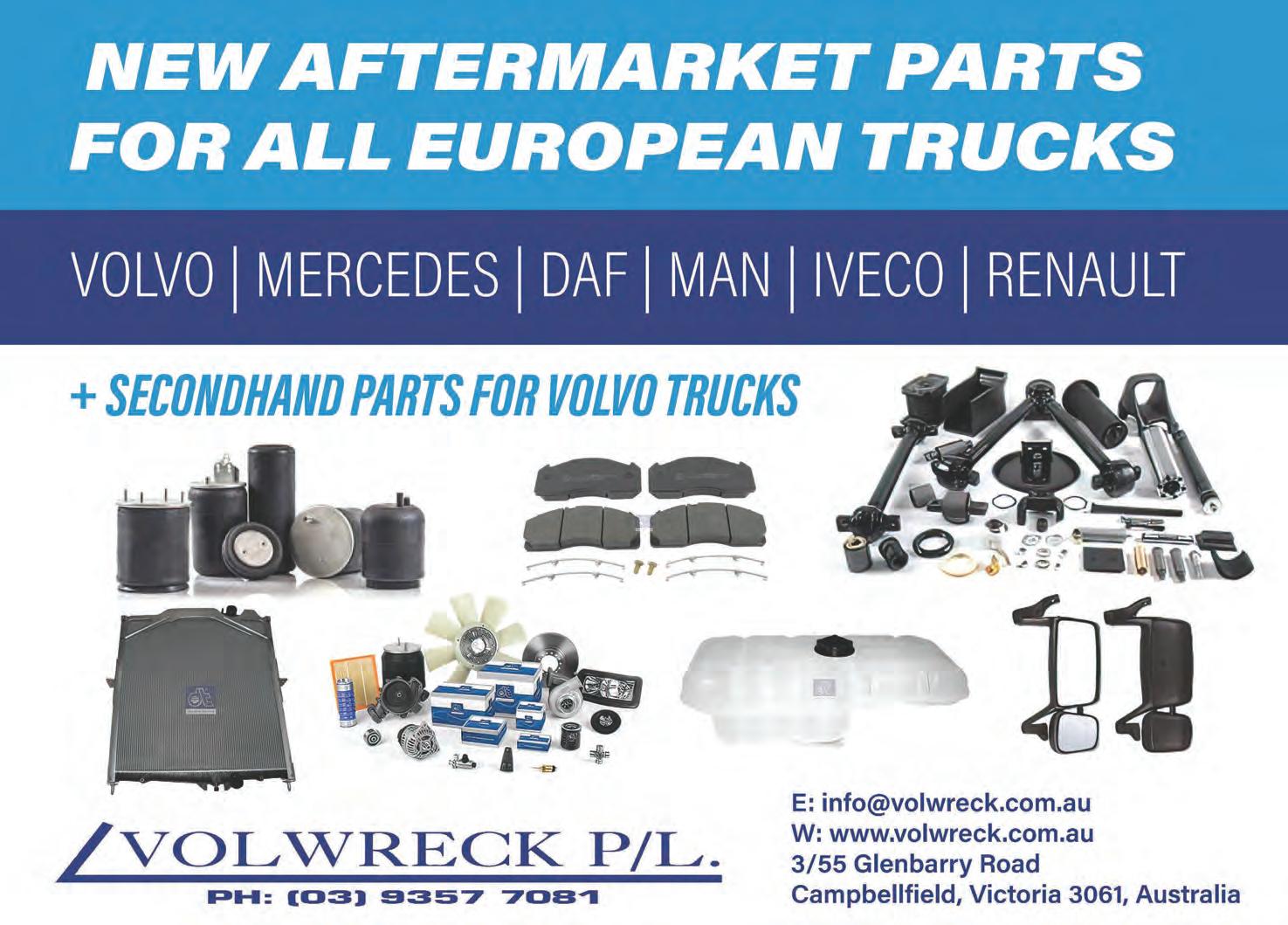



FREIGHTLINER IS SERIOUS ABOUT SAFETY.
Every Cascadia comes with a complete suite of fully integrated active safety features and connected technology that helps you get on with your work.
With Active Brake Assist, which can even detect moving pedestrians, Side Guard Assist, a driver airbag, and forward-facing camera footage that can be sent on-the-go for immediate incident reports, the Cascadia sets a new standard for practical safety.










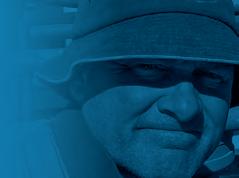
The next generation of transport talent is out there, keen to do it right
In a time when we hear so much doom and gloom, particularly in the transport industry, I’d like to throw a bit of positivity out there.
Over the last 22 years, I have split my time between driving trucks and turning spanners on them. As of March this year I was given the great opportunity to study for and gain my Certificate 4 in Training and Assessing, whilst accepting full-time employment as a teacher in the VET (Vocational Education and Training) system. I am employed to pass on my experience to up-and-coming Apprentice Mechanics throughout their apprenticeships.
This has exposed me to the people that will be maintaining our Heavy Vehicles in the future. Despite the bad wrap our younger generation are often given, generally I am personally impressed with the ones I work with, in particular the wide demographic that make up my classes. Might I say that they respond well to being treated with respect and give it back in return. Perhaps one gets back what they put in!
When I started my apprenticeship in 1989 the class I trained with were all 16–19-year old, male, Caucasian Australian citizens that were born and raised nearby. Like me, they had left school as soon as they could, and we were like peas in a pod.
Step forward 35 years and it is a whole different scene, and I believe our industry is a better place for it.
I have several students in their 30’s, with wives/husbands, kids and mortgages. They bring to the class maturity and some world experiences. I have one young man who has immigrated to Australia and is paying his own way, while my class today had three young ladies in it.
These apprentices, when asked why they chose to get a trade, generally give the answer that they want to make a better future for themselves. Some cite travel as a reason, and of course we still have the younger group we have always had, that got out
of school as soon as possible and took a trade.
What I am observing, is that there has been a shift over time in attitude, and self-assessment from someone being ‘Just a Mechanic’, to ‘I’m a tradesperson, and I am being paid well for my skills, and those skills can take me around the world.’ They are becoming proud — this is a great thing.
You see the heavy vehicle repair industry has recognised demand for tradespeople and has taken down the barriers that previously eliminated so many great people, based simply on age, gender and race among other poor reasons for culling potential applicants.
We now encourage people of all walks of life to come into this skilled trade and carve out a rewarding career. Perhaps it is time the freight and logistics side of our industry did the same.
When a first-year apprentice turns up for training, I am often taken aback a little as to how much they do not (yet) know. It is easy for me to look at a task I have been doing for years, and that I can practically do with my eyes closed and wrongly expect the inexperienced person I am teaching to have the same level of skill. I am starting to settle into a place where I am adjusting my expectations, raising my teaching skills, and making what I hope is a real change in someone’s life.
I expect all but the most cynical of readers will be following along with this and agreeing we need to nurture our up-andcoming tradespeople, both young and mature, male and female, Australian-born and immigrants.
So why is it we have such a negative view of the immigrants and inexperienced that have come to join our industry as drivers, particularly those who were not born in Australia?
To me, when I see someone has worked hard enough in a country where getting ahead is so difficult, to afford to come to Australia and continue to work hard in a very unforgiving industry, they have earned and deserve respect. They also deserve proper training
GORDO MACKINLAY is a former president and current board member of the National Road Freighters Association. To contact the NRFA see the website at www.nrfa.com. au, email info@nrfa.com.au or phone 0493 564 467.

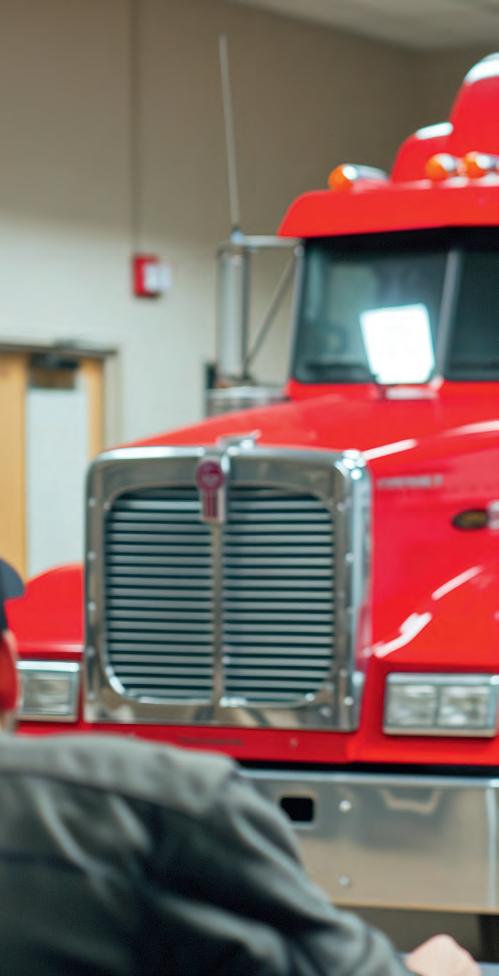
GTS Freight Group (GTS) is a privately owned business opera�ng since 1980 and is a market leader in linehaul transport and logis�cs solu�ons GTS services a range of blue-chip companies na�onally and has a strong commitment to customer service, safety and compliance
Having recently expanded our fleet, we are currently looking for new Team members who can con�nue to build that reputa�on We have some great opportuni�es for the right professional person looking to begin a new career with our iconic Mildura based business
Does this sound like you?
• I am looking for an employer who values and respects me
• Wan�ng to drive fresh, well maintained equipment (predominant Kenworth based fleet)
• I have a great a�tude, and I am looking for a stable, secure future
• I would like to have work paterns that suit my lifestyle and personal circumstances

• I am a safe, professional driver that cares for my equipment and the freight I am carrying
• Great earnings poten�al
• MC Licenced with night highway driving experience and a good history as an operator
Having recently expanded our fleet, we are currently looking for new Team members who can continue to build that reputation. We have some great opportunities for the right professional person looking to begin a new career with our iconic Mildura based business.
If this is you, then GTS can provide that opportunity!
Does this sound like you?
• I am looking for an employer who values and respects me
GTS currently has career opportuni�es for roles around the country for MC Interstate Drivers. To be successful in the role you will possess the following atributes:
• Wanting to drive fresh, well maintained equipment (predominant Kenworth based fleet)
• I have a great attitude, and I am looking for a stable, secure future
• Hold a current MC license
• I would like to have work patterns that suit my lifestyle and personal circumstances
• Preferably have at least 2 years Interstate MC driving experience
• I am a safe, professional driver that cares for my equipment and the freight I am carrying
• Reliable and enthusias�c
• Great earnings potential
• Clear communicator and must be punctual
• MC Licenced with night highway driving experience and a good history as an operator
• Strong understanding and commitment to safety
• Basic Fa�gue Management (BFM) accredita�on would be an advantage
If this is you, then GTS can provide that opportunity!
• Training and induc�on will be provided
GTS currently has career opportunities for roles around the country for MC Interstate Drivers.
For more details and applica�on forms, please go to gtsfreight.com.au and click on the Careers drop down menu, online at seek.com.au or call (03) 5051 0100 or email your resume and cover leter to hr@gtsfreight.com.au
For more details and application forms, please go to gtsfreight.com.au and click on the Careers drop down menu, online at seek.com.au or call (03) 5051 0100 or email your resume and cover letter to hr@gtsfreight.com.au

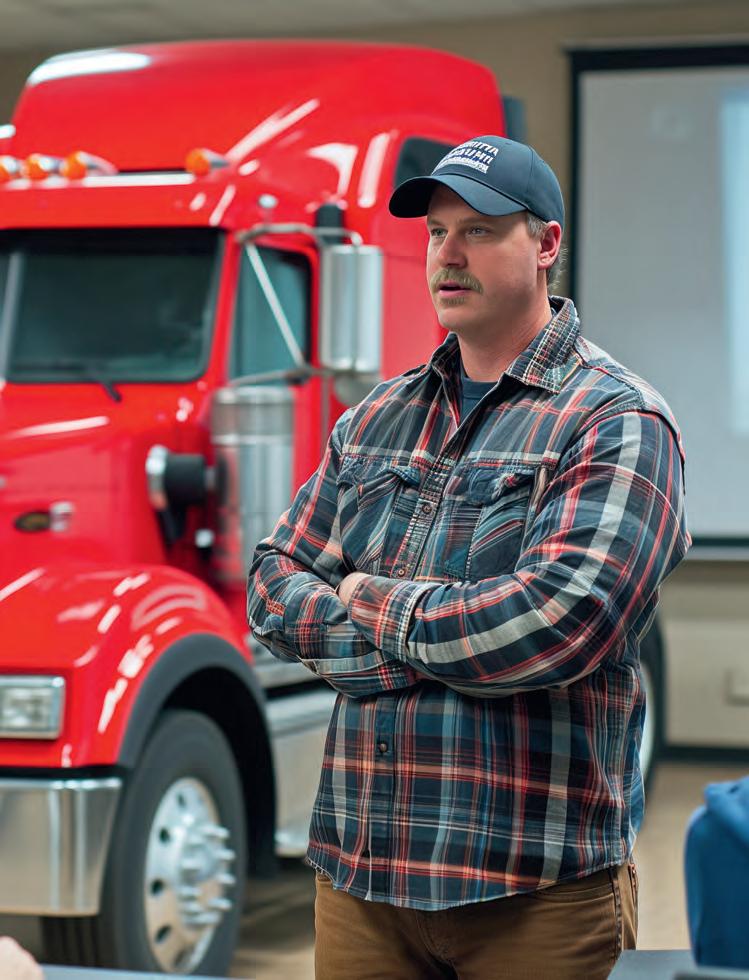
just as we give to our up-and-coming tradespeople.
If you are any sort of fair dinkum person and were living in a country where you thought a better life for you and your family was available in another country, would you not take the leap and do what is best for yourself and your family? So why do so many knock others for doing so?
I think as a general rule we have got it wrong about the immigrants that have moved to Australia to work in our industry. We collectively complain about the low standard of skills, and to be honest that is possibly an accurate assessment. There are lots of drivers entering/entered our industry without the skills needed to do the job. But that is ‘the system’s fault, not theirs.
If you sit around a group of ‘old school’ operators or listen to some of the podcasts reminiscing of times gone by, and how the local Sarge, after observing the interviewee drive unlicensed for some time, told them to ‘Get down to the station so we can give you a bloody license’, therefore admitting they too ‘shortcut’ the system (I admit I did too) — is it not a bit hypocritical to knock someone doing the same thing now?
How many ‘old school’ drivers got their MC licence simply by having a letter from their employee back in the day when that was all that was required? But that’s OK, they were born in Australia, and it was ‘The good old days.’
Is it the same as defending the cult
culture of drink driving ‘in the old days’ before RBT and common sense made it a socially unacceptable activity?
Let us stop the pointless bickering about the new immigrants joining our industry at a time when we are desperate for workers and should welcome the help.
For all you ‘old school’ readers out there, having a nervous tick and bulging veins in your temple after reading this, look in the mirror, look at the person in the reflection, and ask yourself ‘was I born with the skills to operate in this industry, or was I tutored by someone with the experience I so much wanted?’
Perhaps this bad rap on new drivers in our industry is both our fault and only repairable by the ‘old school’ operators out there.
Next time you are at a roadhouse or DC and someone who looks to be a bit ‘Green’ is there also, strike up a conversation, ask them where they are from, how they are going, and if there is something you can show them.
Perhaps educate them on something you are skilled and experienced at to help lift them to the standards the ‘old school’ operators demand of anyone who holds a licence to drive a Heavy Vehicle.
In the meantime, your National Road Freighters Association board members will continue to fight for a better industry for ALL who wish to be a part of it.
Safe trucking everyone, Gordo.





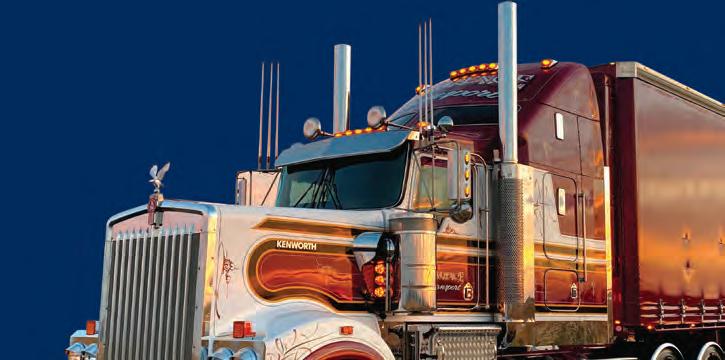
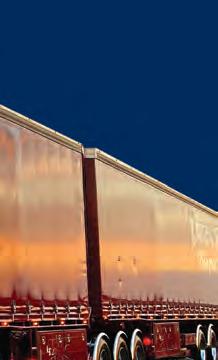


















The rules around mobile phone use while driving in NSW are a bit like a rundown old house: Some parts are falling down, there are draughts getting in all over the place, someone has slapped on a bad extension here, a poor paint job there and a crappy kitchen reno… but what needs to happen is a proper knock down rebuild.
As technology and how we use it has changed, lawmakers have tried to keep up, but in my opinion there’s still a lot of room for improvement.
The problem is that plenty of things that are allowed by the rules are dangerous, plenty of things that are illegal are pretty okay, and there is so much that isn’t captured.
For the time being we’re stuck with the rules we’ve got. So, here is a simple outline of what you can and can’t do with a phone while driving in NSW. The Basic Rule: The basic rule is that the driver of a vehicle must not use a mobile phone while the vehicle is moving, or is stationary but not parked, unless they fall into certain exceptions.
Below I go into exceptions, but the thing to remember is that any use of the phone while driving, allowed or otherwise, can be dangerous, and
if it causes you to drive badly or to have an accident, then you may face criminal charges, even if technically it’s allowed under the mobile phone rules.
Different rules apply to unrestricted licence holders and P-Platers too.
You can do these things with a phone while driving, as long as you are still driving safely:
1. Make and receive audio calls. If your phone is secured in a commercially manufactured holder which is being used properly, or if it is connected through a dash system, like Apple Car Play or a hands-free system, like Bluetooth and you don’t touch the body of the phone.
2. Play audio like music, podcasts or audiobooks. If your phone is secured in a commercially manufactured holder which is being used properly, or if it is connected through a dash system, like Apple Car Play or a

hands-free system, like Bluetooth and you don’t touch the body of the phone.
3. Use Sat Nav like Google Maps. If your phone is secured in a commercially manufactured holder, which is being used properly.
4. Use dispatch systems like the Uber app for Uber drivers. If your phone is secured in a commercially manufactured holder which is being used properly.
You cannot do anything else, including:
1. Text or use any messaging apps
2. Do anything else that involves images or videos, even if it is in a holder
3. Pick up the phone even if not using a function, because this counts as ‘using’ it.
The only times you can touch your phone while driving if it is not in a holder are:
1. to pass it to a passenger
2. to take it out if your car is stationary and you’re using your phone to pay at the drive through or to get into a car park.
If you need to do anything else with your phone, your car needs to be pulled over and legally parked and I recommend with the engine turned off.
P plate drivers cannot use their phones while driving AT ALL.
This means that they cannot:
1. Connect their phone to in-car systems like Apple Car Play or via Bluetooth
2. Use a phone for Sat Nav, even if it is in a holder or connected through the dash
“Different rules apply to unrestricted licence holders and P-Platers too.”

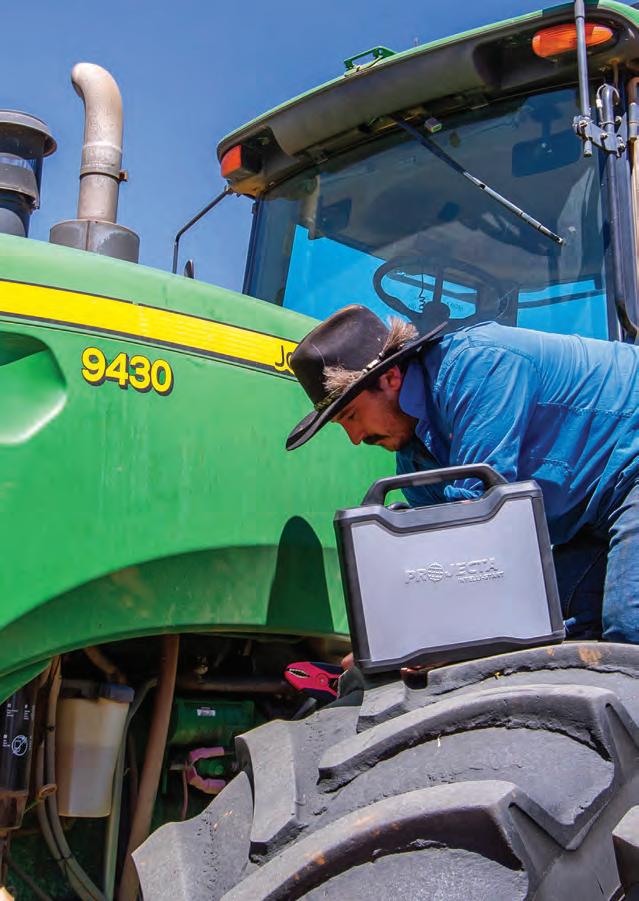
3. Make or answer calls, even if they are hands-free
4. Use their phones to play music, even if it is hands-free or connected through the dash
This means that a P Plate driver can never be on a call while driving. If they want to listen to music, it has to be through the radio or another system that does not connect at all with their phone. If they need a navigation aid, this too must not use phone software at all.
I recommend that P Plate drivers keep their phones out of reach while driving and do not have them in holders attached to the dash.
Even holding the phone in the hand, lighting up the screen with face activation or quickly checking the time count as ‘using’ it, whether stopped at lights or if the car is moving.
The only time a P Plate driver can use a phone while driving is if they are using the phone to pay at the drive through or to get into a car park and the car is stationary.
If a P Plate driver needs to do anything else with their phone, their car needs to be in a valid car park, in park and with the engine turned off.


A flat battery can leave you in a frustrated or even dangerous situation and cost businesses time and money. With Projecta’s patented Rapid Recharge Technology, Intelli-Start are the only jump starters in the world that replenish their charge after starting an engine, meaning they’re always ready for your next emergency. There’s a model to suit every engine and budget. Smart, compact, powerful. That’s Intelli-Start.
























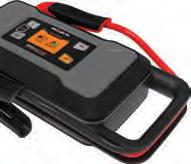
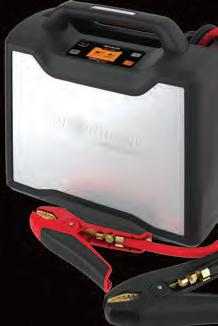







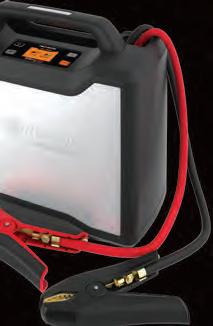



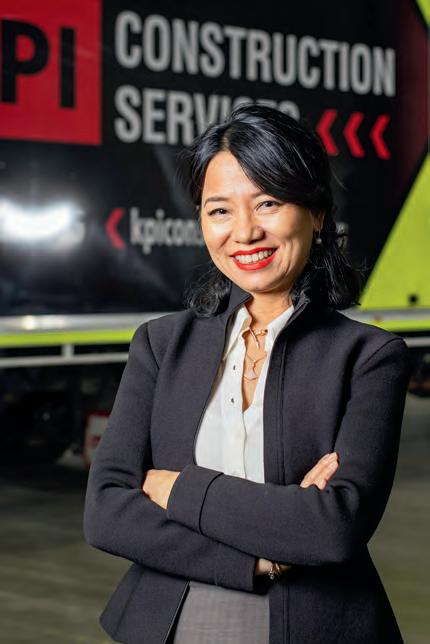
Built to save lives, an Australian made innovation has made a key element of roadside traffic control work a lot safer on Aussie roads.
According to National Road Safety, each year one traffic controller is killed on our roads and 100 are injured, requiring medical treatment or time off work.
Tragedies like these are preventable, cue the world’s first Australian built Automated Cone Truck (ACT), developed by Brisbane’s Arrowes Roading Safety.
Arrowes executive director, Lea Ea initiated the ACT development to find a solution to decrease the alarming number of fatalities and serious injuries among traffic controllers, while also reducing manual handling and traffic set-up times.
Lea says these numbers must go down, as every life lost is one too many.
“Research by Safe Work Australia found 63 per cent of fatalities on worksites were caused by being hit by moving vehicles,” she says.
The seed for the ACT was planted in 2014 with the development of the eSTOP, a portable traffic signal system designed to replace traditional traffic controllers who often worked in risky conditions.
This innovative vision was born from tragedy,
ignited by an accident involving a former member of parliament, who lost his wife who was working as a traffic controller.
Lea says the eSTOP was a game changer, allowing traffic workers to do their job remotely, away from the road.
“We transformed the traffic lantern into a portable that could be remotely controlled by a traffic controller, instead of someone standing in the middle of road with a stop sign,” she says.
“The worker is able to control the traffic from a distance, which led to saving lives.”
In 2018, a phone call highlighted its impact, the equipment had done its job and saved someone’s life, which sparked a whole journey of innovation and the seed that became the Automated Cone Truck.
The ACT is an Isuzu 140/120-260 Auto LWB and was built to be used easily by the drivers, who only have to program the spacing between each cone that can be deployed every seven seconds placed at intervals of 3 to 24 metres while travelling at speeds of up to 16 kilometres an hour.
“In terms of the mechanics behind it, the user has nothing to do with it, but from a development point of view we have made it so simple,” she says.
‘We want it to eliminate the number of moving components, and this is important because we want longevity of use and not constant mechanical issues that would result in us having to maintain it constantly.”
Mechanically, this is how the system works:
The gantry system picks up three cones at a time, placing them on the conveyor which will move left or right, depending on whether the operator wants to drop the cones on the left or right side of the truck.
There are two grippers on either side and depending on which one you’re deploying, it will grip the cone from the conveyor and place it on the road.
Lea explains the evolution of the ACT, with the development of the truck held in their workshop, everything had worked perfectly, until the trial in 2020 when the grippers slipped.
“The environment was very different compared to a workshop environment as we now had the debris, dust, oil, wet weather and all the greases, so it slipped through,” she says.
“We watered down the grippers with a hose, and nothing happened, but in the trial, it slipped, so we improved on that, and we spent quite a lot of time refining the gripper, so now it’s 100 per cent.”
“It’s got two gripping systems at the top and middle
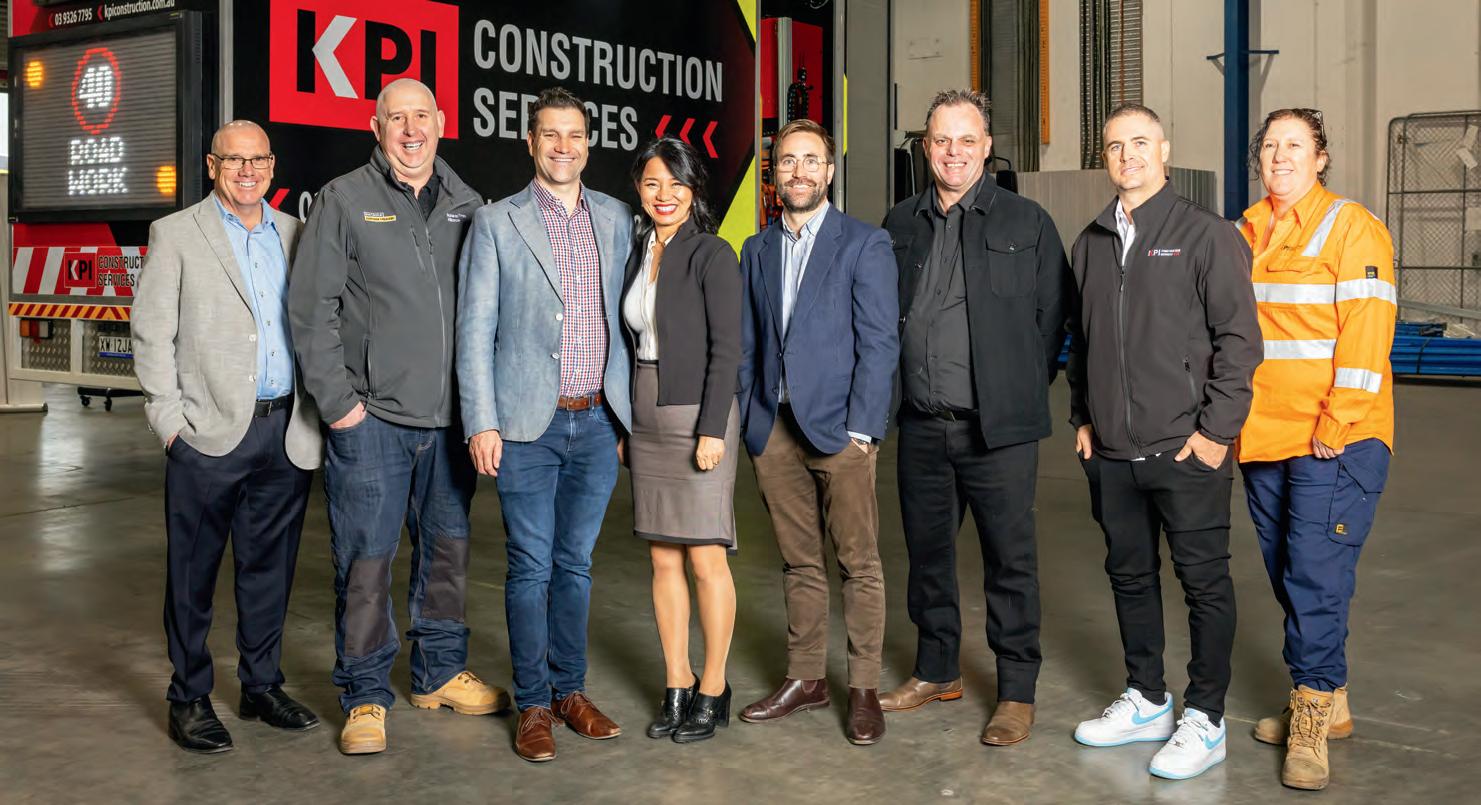
now, therefore there’s no slippage anymore.”
The team sought feedback from end users on how they used the trucking system, as well as the Human Machine Interface (HMI) which also had to be modified.
“We learnt a lot about what it’s like to sit in the truck, thinking about how truckies actually use the system in a real-life environment which gave us a lot of insight.”
“We spent two years after that refining and developing, trialling and testing it before we could commercially sell it.”
When Owner Driver asked the impact the ACT will have on the community, Lea listed reason upon reason.
“Thanks to this project, we’ve learnt that they’ve eliminated 1,200 tonnes of manual handling from just one project,” she says,
“You can imagine what that means from a manual handling in long term injury point of view, like arthritis or back strains.”
The project has not only improved safety but also demonstrates Australia’s capability in innovation and manufacturing.
As a small business, Lea says her team took on the project to show Australia’s capabilities.
“We don’t want to be like every other company that says, ‘I’ve got a problem, let’s look overseas and find a solution. We said, there’s a problem and we want to solve it, so why don’t we develop it, show our capability and then export it,” she says.
Before her job at Arrowes, Lea was working in Singapore for 16 years, supplying to 24 countries around the world.
“When I came back to Australia and started working, I realised that we don’t have any manufacturing here and I was quite disappointed.”
“We don’t do value creation, so for me to be able to showcase our capability and our relevance, and to be able to innovate, produce, create this kind of value, was actually important for me, it was amazing.”
“I had these guys coming up to me saying Lea, we wouldn’t have this opportunity to have this amount of hands-on development and to explore, research and develop it in Australia, the way it has been.
“So, we lose a lot of talent and capabilities because we don’t offer this kind of opportunity locally, everyone sources it overseas to get this kind of opportunity.
“And the reason why we develop it is because of the casualties and the fatalities on the road.”
According to the Australian National University, in 2017 alone, road fatalities cost the Australian economy $33 billion, with each fatality potentially costing $7.8 million in taxpayer money.
The ACT hasn’t gone without recognition, winning the Victorian Major Transport Infrastructure Authority’s award for innovation and the Director General Award for Safety innovations in 2022, as well as the National Safety Award (NSCA) in 2023.
The ACT is also a finalist in Moreton Bay City Council Business & Innovations Awards for 2024.
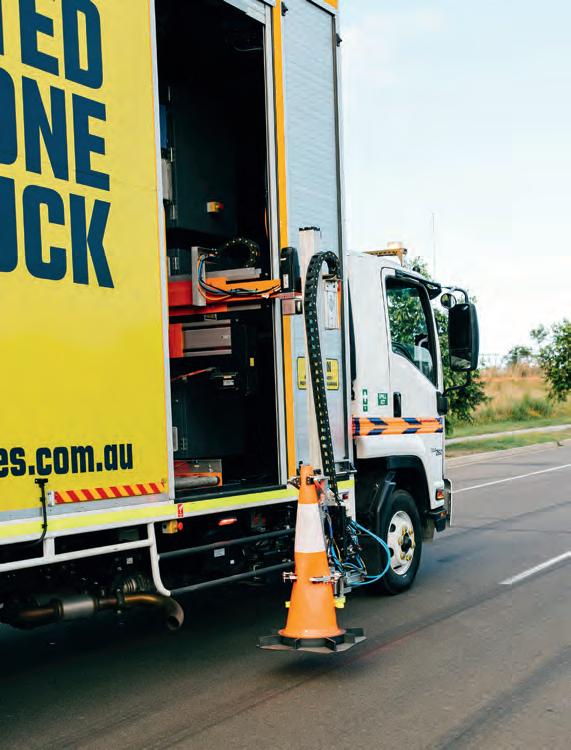
“It’s important for us to have that recognition, it’s affirming, and we all need that confirmation,” Lea says. “We believe in what we do, but to be recognised by the community is another level. It’s the satisfaction, the reward you feel because of your hard work.”
“We knew we had a purpose. We knew we would be making a difference but doing so and then getting recognition for it that is very satisfying and encourages us to continue to develop.”
Lea says the ACT won’t stop revolutionising and work will continuously be made to improve it.
“The iPhone was big and heavy in the 90s. Thirty years on, it’s smaller and more intelligent, we envision the automated cone truck will also revolutionise this way.”
Looking ahead, Arrowes is not resting on its laurels. The next project, named ASSIST (Arrowes Smart Interactive Safety Technology), promises to further revolutionise safety with advanced features like speed alerts for road workers and hazard detection in blind spots. This new initiative aims to build on the lessons learned from the ACT, pushing the boundaries of road safety technology.

More trucks than ever will be roaring into the NSW town of Deniliquin on October 26
The Deniliquin Truck Show and Industry Expo, proudly supported by the Rotary Club of Deniliquin is back for 2024, bigger and better than ever with a new location to boot.
Last year saw the first running of the show for three years, after it was delayed due to a combination of the COVID pandemic and flooding.
Now this time around, it’s going even bigger with a move to the Deniliquin Festival Site, which show founder and president John Creenaune says should be particularly exciting for showgoers.
“We think we’ve found a fairly good site at the Deniliquin Festival Site, the home of the famous Deni Ute Muster,” he says.
“Having it out at the Festival Site will bring more people in. It gives us more space to work with.
“Weather-wise we’re hoping we get a good rollup of trucks with plenty of trade sites on hand. We’ve got Kenworth and CMV Shepparton on board, PACCAR as well.
“We’ll have some trailer makers there as well. There’ll be plenty of food sites and a bar. There’s a big auction will have on the day too.
“It should be a similar turnout to the 1500 last year.”
For hopefuls showing off their rigs, there will be 13 awards handed out across a number of categories including:
• Truck of the Show and Runner Up
• Best Truck Age Categories (0-3 years, 4-9 years, 10-25 years, 26-39 years, 40 years+)
• Best Rigid Truck
• Best Local Truck
• Best Small Fleet (minimum three trucks)
• Best Non-American
• Muscles Gray Memorial Trophy
Last year’s Truck of the Show winner Kyle Nichol made the drive up from Victoria, showing off his recently restored 1990 Kenworth K100E cabover.
John says the organising team has been working hard to secure sponsors and sites to make sure people can come from all over the country to enjoy the show.
He is particularly proud of the contributions the Deniliquin Truck Show has made to get funds back into the local community, particularly in the wake of the floods in 2022.
“We’ve been going on preparation for a few months, gathering trade sites and sponsors for the whole event,” John says.


“It’s been a tough job, it’s tough out there in the industry at the moment. But we do it to bring everyone together and enjoy ourselves for a weekend. It brings the community together every year.
“We’re a non-for-profit group, and since we started in 2015 we’ve donated $90,000 back into the community. All that money goes back through the community.”
One of the most important parts of the Truck Show is the Wall of Fame, which receives new nominees that are honoured each year.
The ceremony takes place on the Friday night of the show weekend, with four new members to join the wall this year.
Last year’s inductees were Herbert Gladstone Grimison, David Mahon and Kenneth Maher.
“The pool of nominations has grown from 31 to 41,” John says.
“Our guest speakers for the night will be Donna Vawdrey, daughter of the famous ‘Toots’. She’s coming down.
“Alongside her will be Paul Fellows from NatRoad and Trucksafe. He’ll be saying a few words then Evan Whitbourne and myself will be handling the rest of the night.”
Other highlights for the show will include the various trade sites scattered across the Festival Site and the auction, which will feature jackets and other transport memorabilia, weekend trips, tyres, mini fridges and more.
The young ones will also have a site to play to their hearts’ content.
If you’re interested in entering your truck for the show, the entry fee is $15 per truck, payable at the Truck Show Office at the Festival Site.
Entries close at 12pm sharp of October 26, with the judging to start immediately afterwards.
Entry for the show $15 per person, with kids going free. For more information, check out the Deniliquin Truck Show website or Facebook page.
October 12, 2024. Boort, VIC.
Held in conjunction with the Boort A&P Society Show the 2024 Boort Truck Show will offer plenty of entertainment and a great selection of trucks. There will be prizes on offer across a range of categories.
To fi nd our more visit the Boort Truck Show Facebook page, phone Heath on 0428 382 725 or email heathsaunders@outlook.com
MATTY HILLCOAT’S TRUCKIES’ DAY OUT
October 12, 2024. Gympie, Queensland.
Held at the Gympie Showgrounds, Matty Hillcoat’s Truckies’ Day Out kicks off at 9am and runs until late. Attendees can enjoy a truck show and parade, show ‘n’ shine display, timber sports, a tractor pull, a vintage machinery display, kids’ amusements, music and more. Entry is $25 for trucks (including one adult) and $20 per adult, with concession $15, kids $5, and kids under fi ve going free.
RALLY & TRUCK SHOW
October 19 & 20
Urana Vintage Machinery Club will host a two day Vintage Rally and Truck Show at Victoria Park, Urana, NSW, including a vintage tractor trek, twilight tractor pull on Saturday and Sunday and a Truck Show and Shine on Sunday, October 20. Sunday will include a fete to raise money for the local hospital with coffee, food stalls and kids’ activities as well. Camping is available on site too.
For more information phone Gary on 0408 683 111 or Justin on 0423 319 488 or email uvmcinc@gmail.com
November 9, 2024
Held in conjunction with the annual Mullumbimby Agricultural Show. Truck registrations open from 9am at the Mullumbimby Industrial Estate off Manns Rd. Drivers to register their vehicles before the truck parade through town at 11am, travelling through town to the showgrounds. All the attractions of a country show including sideshow alley, rides, food vans, full bar facilities andlive music. Other features include horse and cattle events including trotting.
For further truck show info see the registration form at www.mullumbimbyshow. org.au or phone Mark on 0427 634 903 or email wardysmachinerycentre@gmail.com
November 17, 2024
The Illawarra community’s big annual big convoy is celebrating 20 years. Bikes will leave Illawarra Coal’s Westcliff Colliery on Appin Rd at around 8.15am, followed by family’s buses then lead. Non-lead trucks join at Maddens Plains to Mount Ousley, Warrawong to Shellharbour Airport. Family fun day at Shellharbour airport, includes live music. Fundraising will continue on-line with a silent auction, raffl es and merchandise with monies raised to be distributed via the Illawarra Community Foundation to charities and families in need within the Illawarra and South Coast regions.
For further information visit www.illawarraconvoy.com.au or see the convoy’s Facebook site.
November 23-24, 2024
The highly anticipated Castlemaine Rotary Truck Show will be held in the second-last weekend of November in one of the highlights of the Victorian trucking calendar. Last year saw 265 trucks entered for judging, with the oldest being 96 years old. Applications are open for those interested in entering their truck or a display at the show which is held at Campbells Creek Recreation Reserve, Campbells Creek, Victoria. For more information contact castlemaine.truck.show@gmail.com or go to rotarycastlemaine.org.au/page/truck-show online.




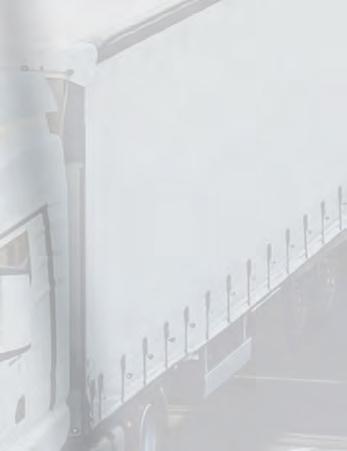
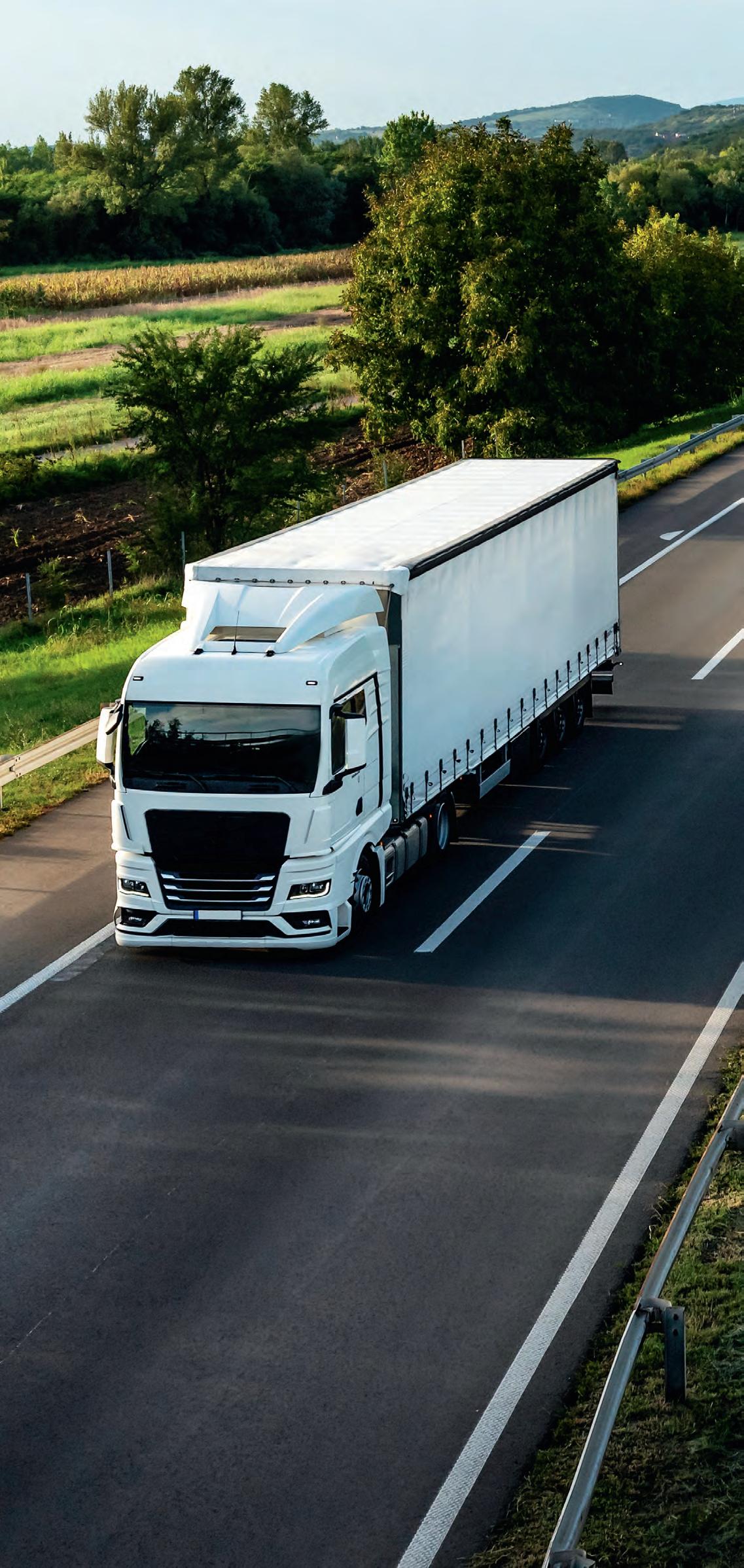














Thallon’s population nearly doubled as people showed up from all over rural Queensland for the famous truck pull
The tiny Queensland town of Thallon, located more than 500km west of Brisbane, put itself on the map with the third edition of the Thallon Truck Pull on August 31.
It’s not your typical trucking event — there’s no showing of trucks to claim the top prizes — instead teams of six went head-to-head pulling a 12-tonne prime mover over 25 metres as quickly as they possibly could.
The actual competition part is over in a flash — the fastest teams pulling a Kenworth T610 SAR prime mover, kindly provided by the local 4 Hill Farming, in under 30 seconds.
Thallon Progress Association president and Thallon State School P and C grants officer Janna Spierenburg say it was a weekend to remember, even in scorching conditions, following the last Truck Pull in 2022.
“It was a wonderful success,” she says.
“According to our postcode collection, which I created from a QR code that people would scan, we think we had about 267 adults and 155 kids, but it may have been closer to 300 adults.
“We had a kids’ zone that was free, and they just went wild out there which was fantastic. That was the whole point and what we try and do it for.
“It’s a fantastic result for our small community event. This year was a lot of locals. We did have a few travellers coming through, but it was people who had travelled up, planning too ahead, not so much the passersby.
“A lot of travellers said they’d been there two or three days. They’d heard about it and were coming up to see it.”
The 2022 event saw women’s teams participate for the first time, and due to popular demand, a women’s only competition was run this year.
Six women’s teams signed up, outnumbering the five men’s teams.
“The women really wanted to get in there and give it a go,” Janna says.
“They’re far more organised than the blokes. They had the teams nominated and signed up in advance, whereas the blokes were the day before!”
When it came time for the Truck Pull itself, the organising committee pulled out all the

bells and whistles. Teams were encouraged to show up in uniforms and give themselves a fun name (with some teams having maybe too much fun).
While it was a competition for $3,000, the light-hearted fun and games make the Thallon Truck Pull what it is.
“Every team gets to have a bit of fanfare, run through the curtain and get an MC chatting them up,” Janna says.
“It’s ready, set, go and over in less than 30 seconds. They each got to pull the truck three times.
“Sometimes the first go you think is the fastest, but they work out their technique in the first two pulls and then the third one is usually








the fastest. It’s very hard to get the chance to just go out and practice it!
“A lot of our teams are farmers or young blokes, but they weren’t that young this year!”
Once all was said and done, the women’s competition was taken out by ‘The Better Frillies’, with a time of 31 seconds. The ‘Truck Wits’ earned the cheque in the men’s division with a time of 23.14 seconds.
The event was supported by Brown and Hurley, who presented the prizes to the winning teams, as well as the winners of the uniform competition.
“The Better Frillies are made up of members of the women’s rugby team, but they call themselves ‘better’ because the Frillies is the men’s team,” Janna laughs.
“They thought they could do better!
“Angus Short from Brown and Hurley opened up the event, gave a speech and helped to present the awards.”
With the Truck Pull over and done until 2026 now, it served as a great advertisement for the town of Thallon.
Janna hopes that more people will look at making it a part of their travel calendar for the next edition, which the committee is thinking of moving to March to encourage more attendance.
“What is great about the Thallon Truck Pull is that it’s so uniquely Thallon,” she says. “It’s our one major event that’s so inclusive. Anyone can attend, it’s free entry. The market stalls were brilliant this year.
“We had vintage cars, we tried to get trucks as well but they were all far too busy. It was a great day for our wider shire community to all come together and have a bit of fun.
“The whole day was the highlight. Everyone just really enjoyed their day. It was a nice afternoon out.
“The competition was really tight. I was a timekeeper, and I thought after every pull each team won that I couldn’t believe how fast they were moving the truck.
“The competitors gave it everything. They put their bodies on the line and beat their times on every time around. It’s very impressive to see what people can do together.”
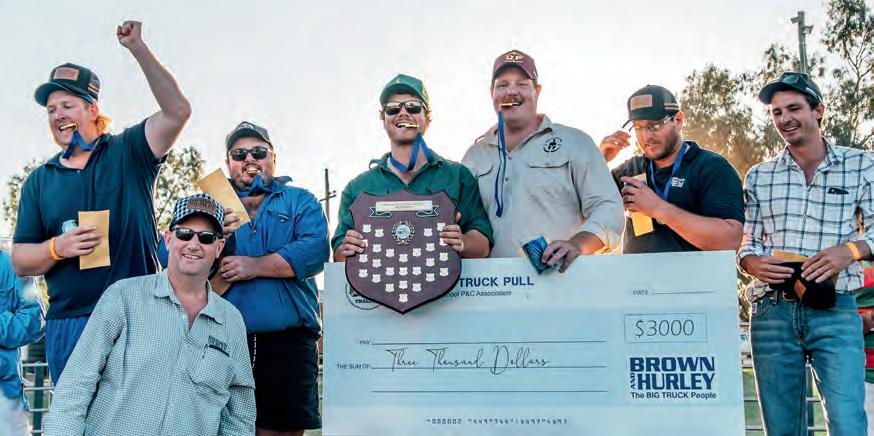
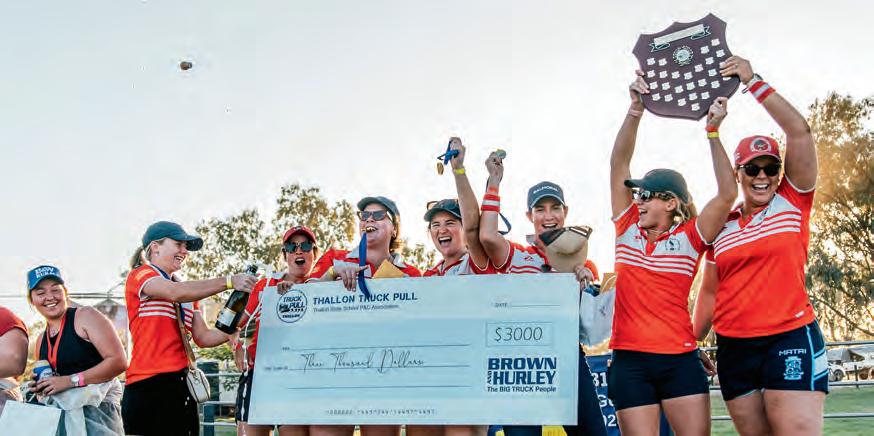

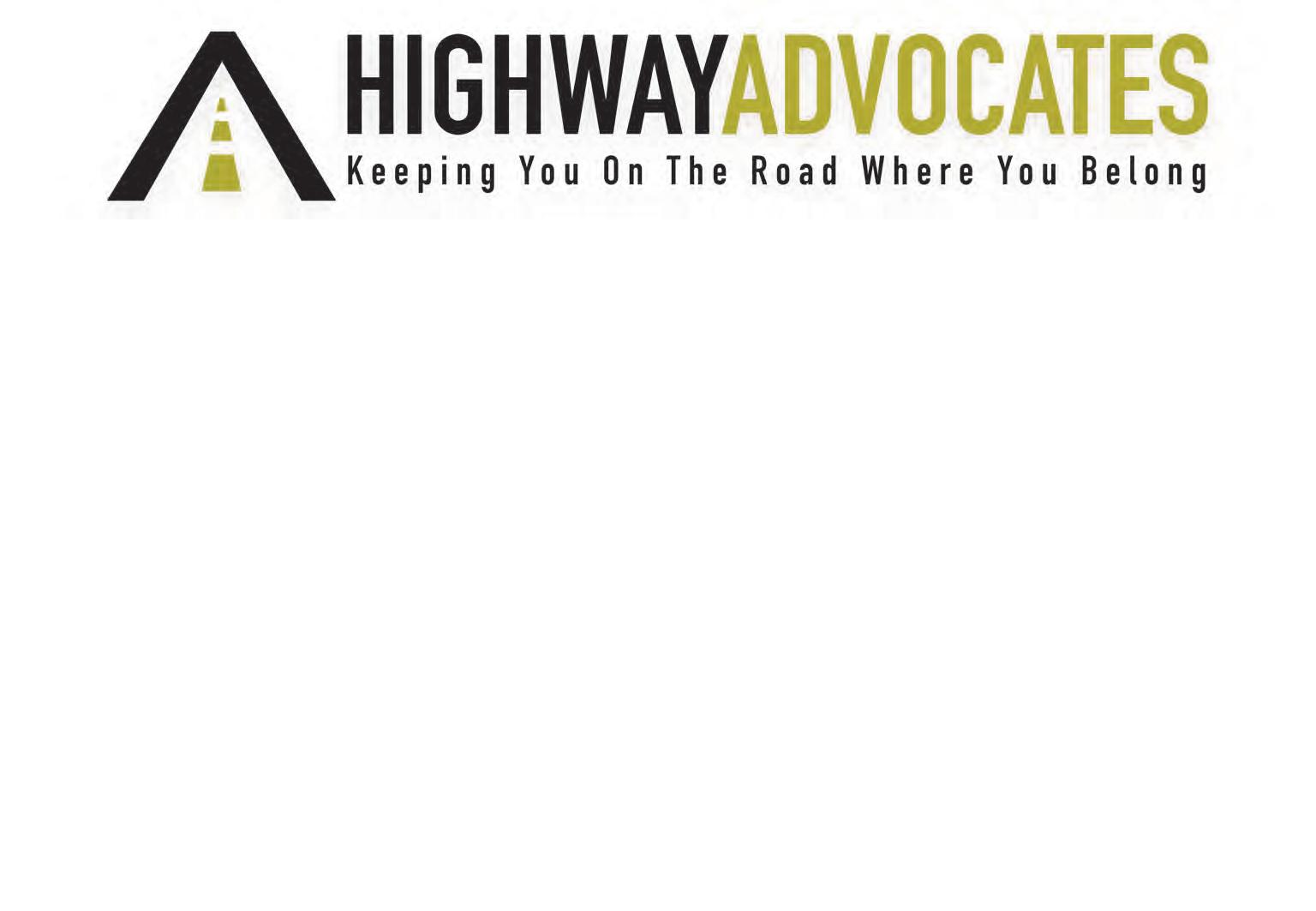

Investing in your people can have untold benefits. That’s exactly what’s happening at WA-based Goldstar Transport, Alex Catalano found out
Goldstar Transport has become a mainstay of the transport industry in Western Australia.
Sean and Dot Carren started the business in 2004, with plenty of challenges coming early. They originally had just two prime movers in their fleet, which has since grown to over 250 trucks and 260 trailers. They recently took delivery of their 100th Mercedes-Benz truck, a special anniversary 25 Driver Edition model.
It was a fitting way to celebrate the company’s 20th year in operation, which has seen another stunning year of growth for the Kewdale based operator.
While the trucks keep everything moving, from major projects like delivering materials for the construction of Optus Stadium and the Perth rail tunnels to carting soft drink and produce for major retailers, it’s the growth of their people that Sean is most proud of.
He and the team take great satisfaction in watching young people come through the business, developing their skillsets and learning about what it takes to be in the trucking games, and growing in their roles and confidence.
OwnerDriver heard from two of Goldstar’s younger team members, Sean Harfield and Maddison Leaman, who have taken on their roles within the business and excelled with flying colours.
Sean is the more tenured of the two, having worked with Goldstar since 2017 when he joined as a trade assistant.
“I was on the lookout for a job and came across an opportunity at Goldstar Transport as a trade assistant in the workshop,” he says.
“The location was convenient, the benefits were appealing, and it seemed like a great fit with plenty of opportunities to learn and grow. So, I applied and got started.”
And learn and grow Sean did. Within a year of starting at Goldstar, he had the opportunity to take up a heavy diesel mechanic apprenticeship, which he jumped at immediately.
Shortages are affecting all areas of the transport industry – not just drivers. Having a young mechanic like Sean learning the ropes of what it takes to keep a truck moving is vital to moving transport forward.
“I started my apprenticeship in February 2018,” he says.
“As technology advanced, I wanted to keep up, so I
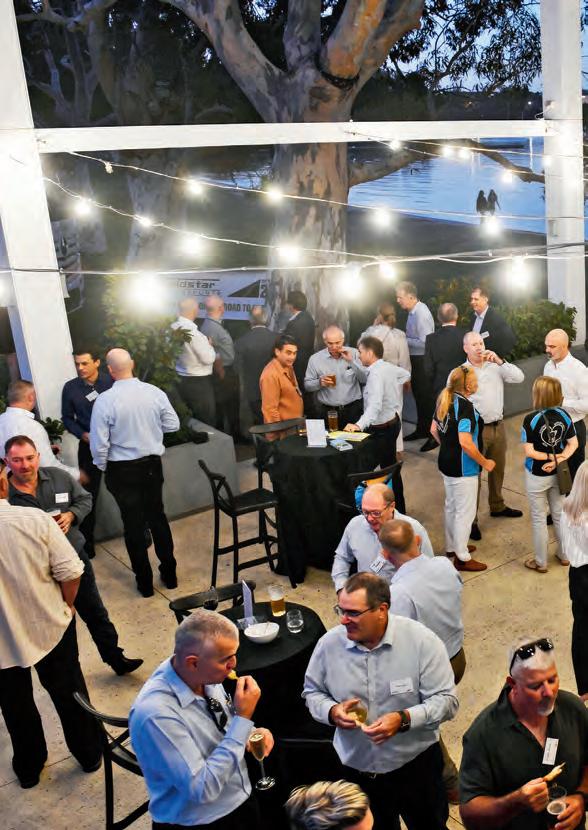
decided to further my skills by taking on an mechanic and auto electrician apprenticeship, which I aim to complete by February 2026.
“So far, I’ve been with Goldstar for eight years, and I’ve loved it so far.
“I’ve enjoyed the variety of work, from servicing and addressing defects to mechanical and electrical diagnostics. The work environment is excellent, and I’m fortunate to be surrounded by supportive people.”
Sean says that since he’s started at Goldstar, he’s been well supported in his ambitions to grow his skills and across his apprenticeship.
It’s a key reason why he’s spent nearly a decade already with the business.
“Goldstar has given me the opportunity to complete multiple apprenticeships, which have been crucial in helping me develop valuable skills and industry knowledge,” Sean says.
“The company’s supportive environment and opportunities for growth have pushed me to expand my capabilities, take on more responsibility, and ultimately become a more confident and capable professional.”
No job within the transport industry comes without its challenges – embracing them is where Sean finds enjoyment in his work.
He encourages anyone who has any interest in getting involved to jump in as fully as they can, to get the most out of it.
“I appreciate how busy the industry is — there’s always something to do,” Sean says.
“I’ve also enjoyed the diverse range of work, including offsite and regional projects involving long-haul trucks.
“I’d absolutely encourage anyone to seek out a career in transport. If you’re eager to learn and willing to work hard, the transport industry is a great fit.
“My advice is to jump in and stick with it. It won’t always be easy, but the rewards are worth it.
“Goldstar has provided me with a stable, meaningful career, and the industry’s constant demand for skilled professionals ensures long-term opportunities. After all, without trucks, Australia stops.”
Keeping people moving
When you think trucking, most would envision the hands-on jobs — getting behind the wheel and driving for hundreds of kilometres, throwing straps, getting your hands greasy under the truck and so forth.
But there’s a dedicated team behind the scenes wherever you look, keeping everything moving on the operations side.
Maddison Leaman is one of those people, currently working with Goldstar in the accounting team.
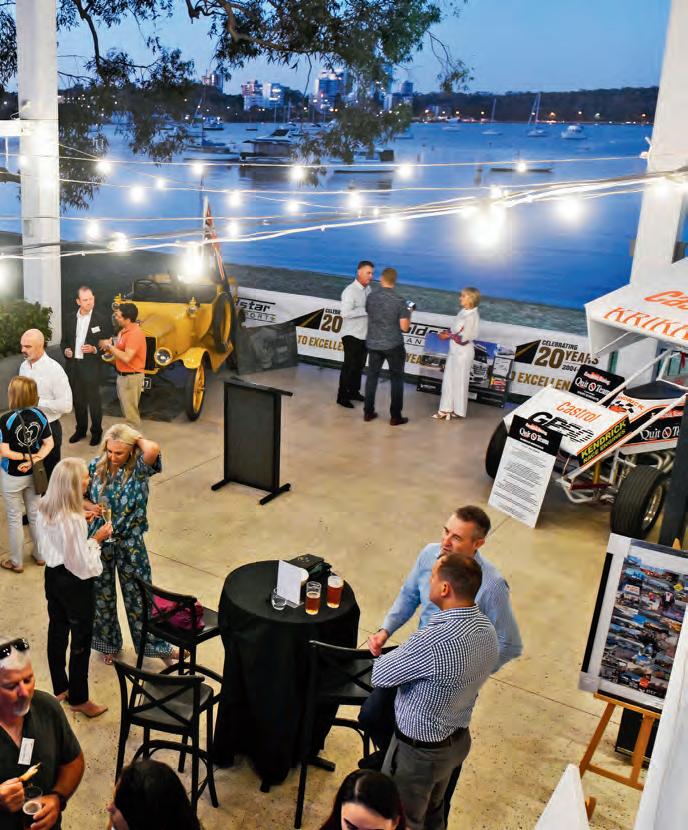

“Mercedes-Benz make trucks that drivers what to drive, that is why we have 100 of them.”
She made the leap into transport world fresh out of TAFE at just 17, completing a Certificate 3 and 4 in Accounting and joining the team as her first job.
Coming up to two years since starting as a junior accounts clerk, Maddison says she has found being involved in transport incredibly rewarding so far.
“I enjoy challenging myself to learn new things and keeping myself busy with a high workload,” she says.
“My favourite part of the job is working in my team with liked minded people who are also highly motivated to work hard.
“Goldstar also provides flexibility with work hours and being able to work from home when necessary.”
Transport is not necessarily the specific path that Maddison was aiming to go down, but now that she’s in the thick of it, she’s loving every minute.
She says it has been incredibly welcoming as a teenager fresh out of studying, and has put her on the right path.
Opposite top: The company’s 100th Mercedes-Benz model arrived just in time for the celebrations
Above: It’s been a year of celebration for Goldstar Transport
Below, L to R: Goldstar celebrated its 20th anniversary with a special event for its staff and customers; Sean Harfield has almost finished his heavy vehicle mechanic apprenticeship, and is loving every minute.
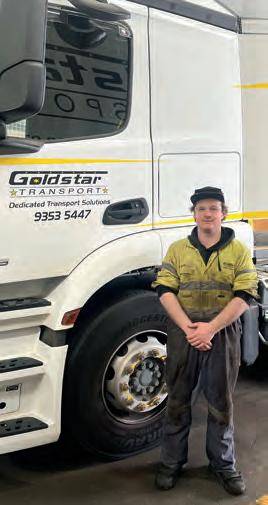
“I enjoy seeing the complexities of each division of the business and how they manage different challenges,” Maddison says.
“Learning an accounting program that is specific to the transport industry and incorporates each department has been really helpful too.
“When I started working at Goldstar, I was a lot quieter, and I have definitely become more confident in talking to new people and developing friendships. The Goldstar team is incredibly supportive and I am lucky to work alongside them.
“At any stage that I want to advance my skills Goldstar offers to pay for relevant courses.
“The world will always need the transport industry so staff will continue to be indispensable. There is currently a high demand for jobs in the industry so now is a great time to get involved.”
Bringing up the ton with their 100th Mercedes-Benz model was just one part of Goldstar’s 20th anniversary celebrations.
Going from just two trucks at the start, one of which was even stolen, it was a great reminder to Sean Carren and the team just how much the business has grown since those humble beginnings.
It now has more than 450 employees to go with its evergrowing fleet, also welcoming its first electric truck in the form of a Fuso eCanter in 2022.
Goldstar continues to operate the 100 Actros models, which have been added to the fleet since 2016, as well as 27 Freightliner Cascadias and 62 Fuso Fighters and Shoguns.
“Mercedes-Benz make trucks that drivers what to drive, that is why we have 100 of them,” Sean says.
“As a fleet truck there is no better for our most important asset – our people.”

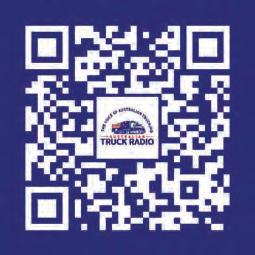








going one better, with its iconic Plate



“South Australia is going one better, with its iconic Plate 8 being
sold for a
cool
$2,300,100.”
be hoping for some good fortune on the roads.
Australia all the way back in 1906, with the bidding starting at $600,000 before skyrocketing into the millions. The sale set a new auction record for South Australia, with the number eight considered the luckiest number in Chinese culture. Now, the lucky winner will
If you happen to have a Halloween party on the horizon, now is the time to start planning your costume before all of the good options run out. For the trucking inclined, don’t be afraid to go DIY – we’d love to see a variety of trucks, trailers and prime movers being made and adorned on the night of horrors! Not all costumes have to be bought – some of the best trucking and transport-based gear starts with a painted box, keeping it both comfy and entertaining.
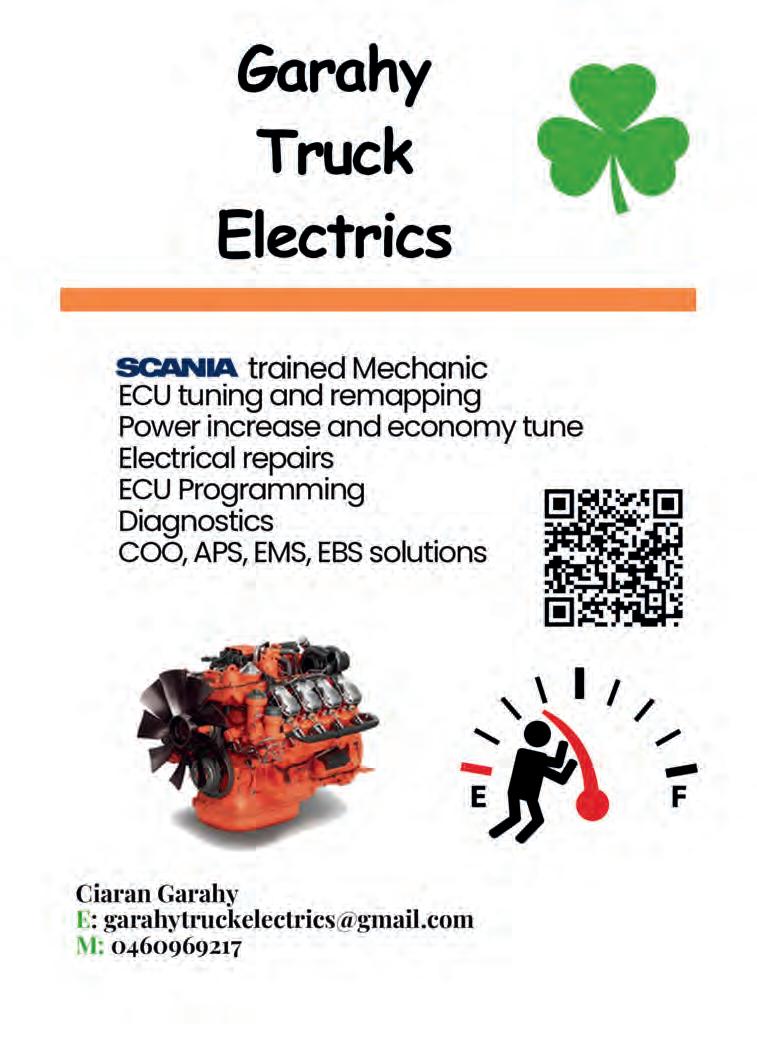



The new transport reform laws which have been talked about for quite some time finally came into force in August, which I think can’t come soon enough for us owner drivers.
Operators have seen rates go down, along with safety standards, and drivers often struggle to make ends meet with the tight margins.
The absence of regulation has meant that our negotiating power is restricted – not only on rates, but on other conditions – because we’ve had no protection against a client simply terminating our contract if we speak up. That will change under these laws. We now have access to the Fair Work Commission for the first time, and from February we will have the right to challenge unfair contract terminations.
In the first days of these laws coming into effect, the Transport Workers’ Union put in applications to start building a safety net of standards.
One of the most significant changes for owner drivers is an application for fairer payment terms throughout contract chains.
The TWU’s application does two things: first, it calls for payments to be made within 30 days of a job being completed, and second, it calls for the removal of ridiculous payment terms that reduce
rates year on year for longer-term contracts. We shouldn’t be screwed over by a technicality that is designed to save money at the expense of our financial well-being and ultimately, our safety. Let’s face it trucks are a never-ending pit of expenses with so many specialised parts, so the more available cash for operators, the better.
These changes to payment terms would apply throughout the supply chain, meaning it no longer has to be a difficult conversation for us to navigate. All those weeks and months we have often spent chasing payments for work completed should soon come to an end. Getting paid sooner gives us financial security and more available cash for repairs and maintenance.
Even though payment terms have improved for the majority of owner drivers there are still some clients that stretch out payment to 60 and 90 days.
Another part of the application

that affects owner drivers is allowing disputes over payment amounts to be heard by the Fair Work Commission. This means it’s not just us against the company — an independent arbitrator is there to support the process, which I think really will work in our favour. We’re not looking to rip off clients, we just want a fair deal.
The other applications made by the TWU are targeted in areas to address the exploitation in the gig economy that has dragged down standards even further with the likes of Uber and AmazonFlex coming into the market.
Even though this might not directly affect us right now, it protects us in the future. The gig economy has been one of the biggest threats to our jobs as we know them. Overseas, Amazon and Uber engage truck owner drivers on low rates, on a take it or leave it basis through apps. There’s no notion of negotiation — not even a human to talk to. For those drivers, their work, right down to the route they take and how long they’re on the road, is monitored and controlled through algorithms. Bringing in standards for gig economy workers in transport stops the disastrous undercutting that was coming for us.
Now that these applications have been made, there’ll be a process of consultation with the industry before the Fair Work Commission makes any orders to set standards into law. Although it slows down the standards we desperately need, it’s so important that drivers and operators have a say on how changes to our industry will affect us.
These applications show how this system can introduce some quick fixes that will make our work easier. Over
“One of the most significant changes for owner drivers is an application for fairer payment terms throughout contract chains.”

time, we need to see these standards built up to address more of the issues we face.
For too long, things have been weighted in favour of big corporates that engage the transport industry, and too much against drivers, who have little opportunity to negotiate fair rates and conditions. The new laws coming into force can see a greater balance between drivers and companies.
The more things like fair payment terms, cost recovery, and realistic deadlines become enforceable standards for everyone, the less time we have to spend trying to push back against unrealistic, dangerous demands. We should never feel the pressure to compromise our safety or that of other road users to win or retain contracts. Having a safety net means we can negotiate decent outcomes on top of what is already the norm, or the industry standard.
Fair standards means better-rested drivers, properly maintained vehicles, a decent living, dignity in retirement, and ultimately, a safer environment for everyone on the road.







